Plant Selection Considerations
Congratulations on choosing native plants! To further enhance the vitality of your landscape, it's important to tailor your plant selection to suit your specific property. While factors like mature height and light requirements should always be considered, paying attention to salt tolerance, both from wind and water, becomes particularly important for properties directly situated on the water. Besides potential saltwater inundation, it's vital to account for the detrimental effects of salt-laden winds. You can find information about the tolerance of plants to both conditions in the Quick Glance Table provided in the following pages. Although many plants thrive across the Keys, the table indicates their natural occurrences in either the Upper or Lower Keys, providing additional guidance for making more tailored selections for your landscape. Links to planting guides are provided in the references and resources section on page 41. Happy Planting!



i
John Winder (CC BY-NC-ND 2.0)
muhly grass (p. 38)
Joewood (p. 16)
Quick Glance - Sorted By Category
*Status Key - E = Endangered, T = Threatened, RI = Regionally Important
**Approved for use as a Street Tree by Monroe County
^Tolerance to temporary saltwater inundation
2 Category Common Scientific Canopy Palm Under story Shrub Groundcovers, Vines, Grasses Location (Upper/ Lower Keys) Black ironwood Krugiodendron ferreum C U Up & Low Buttonwood Conocarpus erectus C U S Up & Low Geiger tree Cordia sebestena C U Up & Low Gumbo limbo Bursera simaruba C Up & Low Inkwood Exothea paniculata C Up & Low Jamaica dogwood Piscidia piscipula C Up & Low Lancewood Damburneya coriacea C U Upper Mastic Sideroxylon foetidissimum C Upper Milkbark Drypetes diversifolia C U Up & Low Paradise tree Simarouba glauca C Up & Low Pigeon plum Coccoloba diversifolia C Up & Low Princewood Exostema caribaeum C U Upper Satinleaf Chrysophyllum oliviforme C U Up & Low Seagrape Coccoloba uvifera C S Up & Low Slash pine Pinus elliottii var. densa C Lower Wild tamarind Lysiloma latisiliquum C Up & Low Willow bustic Sideroxylon salicifolium C U Up & Low Buccaneer palm Pseudophoenix sargentii P U Upper Cabbage Palm Sabal Palmetto P Up & Low Thatch palm, Florida Thrinax radiata P U S Up & Low Thatch palm, Keys Leucothrinax morrisii P U S Up & Low Silver palm Coccothrinax argentata P U S Up & Low Saw palmetto Serenoa repens P S Up & Low Blackbead, catclaw Pithecellobium unguis-cati U S Up & Low Blackbead, Fl. Keys Pithecellobium keyense U S Up & Low
ii






































3 Special Status* Street Tree** Salt Tolerant (Water)^ Salt Tolerant (Wind)+ Light Needs Swale Suitable# Screening Suitable∞ Showy Flower/ Fruit Season Butterfly Plant Page RI x Low Moderate 1 x Moderate High x x Nectar 1 RI x Low Mod/High Sum-Fall Nectar 2 Low/Mod High Host 2 RI x Low Moderate x Wint-Sum 3 x Low/Mod Moderate Spring Host 3 RI x Low Mod/High x Spring-Fall 4 RI x Low Mod/High x 4 E x Low Low Host 5 RI x Low Mod/High x 5 x Low Moderate x Nectar 6 E x Low Low Year Round 6 T x Low Moderate Year Round 7 x Moderate Moderate x Sprg-Sum Nectar 7 RI Low Moderate 8 x Low Low Host 8 x Low Moderate Nectar 9 E Low Mod/High 9 N Low/Mod Mod/High Host/Nectar 10 E Low Mod/High x x Host 10 T Low Mod/High x Host 11 T Low Mod/High Host 11 Low/Mod Moderate Host 12 Low Moderate x x Sum Host/Nectar 12 T Low Moderate x x Sprg-Sum Host/Nectar 12 Sheet 1 of 4 iii +Tolerance to salt-laden winds #Approved for use in swales by Monroe County ∞Provides privacy
Quick Glance - Sorted by Category
*Status Key - E = Endangered, T = Threatened, RI = Regionally Important
**Approved for use as a Street Tree by Monroe County
^Tolerance to temporary saltwater inundation
4 Category Common Scientific Canopy Palm Under story Shrub Groundcovers, Vines, Grasses Location (Upper/ Lower Keys) Blolly Guapira discolor U S Up & Low Cinnamonbark Canella winterana U S Up & Low Cinnecord Vachellia choriophylla U Up & Low Crabwood Gymnanthes lucida U Up & Low Darlingplum/Red ironwood Reynosia septentrionalis U Up & Low Fiddlewood Citharexylum spinosum U Up & Low Jamaica caper Quadrella jamaicensis U Up & Low Joewood Jacquinia keyensis U S Up & Low Lignumvitae Guaiacum sanctum U S Up & Low Limber caper Cynophalla flexuosa U Up & Low Marlberry Ardisia escallonioides U S Up & Low Myrsine Myrsine cubana U S Up & Low Myrtle-of-the-River Myrcia zuzygium U S Upper Rhacoma Crossopetalum rhacoma U S Up & Low Seven-year apple Casasia clusiifolia U Up & Low Soldierwood Colubrina elliptica U S Upper Spicewood, Pale lidflower Myrcia neopallens U S Up & Low Stopper, Red Eugenia rhombea U S Up & Low Stopper, Redberry Eugenia confusa U S Upper Stopper, Spanish Eugenia foetida U S Up & Low Stopper, White Eugenia axillaris U Up & Low Strongback, pineland Bourreria cassinifolia U S Lower Strongback, rough Bourreria radula U S Lower Strongback, Bahama Bourreria succulenta U S Up & Low
iv










































5 Special Status* Street Tree** Salt Tolerant (Water)^ Salt Tolerant (Wind)+ Light Needs Swale Suitable# Screening Suitable∞ Showy Flower/ Fruit Season Butterfly Plant Page X Low Mod/High X Sum-Fall 13 E X Moderate Moderate Sprg-Sum Nectar 13 E Low Moderate X Sprg-Sum 14 RI X Low Mod X Host 14 T Low Moderate X 15 RI Low Low Year Round Nectar 15 X Low Mod/High X Sprg-Sum 16 T Moderate High X Sum-Fall 16 E X Low Moderate Year Round Host 17 Low Mod/High Sprg-Sum Host 17 Low Mod/High Fall 18 Low Mod/High X 18 E Low Moderate 19 T Low Low 19 RI Low Moderate X Nectar 20 Low low 20 RI Low Moderate X 21 Low Low E Low Low 21 Low/Mod Mod/High X 21 X Low/Mod Moderate 21 E Low Moderate 22 Low Moderate 22 E Low Moderate 22 Sheet 2 of 4 v +Tolerance to salt-laden winds
Approved for use in swales by Monroe County
Provides privacy
#
∞
Quick Glance - Sorted by Category
*Status
6 Category Common Scientific Canopy Palm Under story Shrub Groundcovers, Vines, Grasses Location (Upper/ Lower Keys) Torchwood Amyris elemifera U Up & Low Velvetseed, Everglades Guettarda elliptica U Up & Low Velvetseed, rough Guettarda scabra U S Up & Low Wax-Myrtle Myrica cerifera U S Up & Low White ironwood Hypelate trifoliata U Up & Low Wild dilly Manilkara jaimiqui subsp. emarginata U Up & Low Wild lime Zanthoxylum fagara U S Up & Low Bahama senna Senna mexicana var. chapmanii S Up & Low Bay cedar Suriana maritima S Up & Low Beautyberry Callicarpa americana S Upper Blacktorch Erithalis fruticosa S Up & Low Cocoplum Chrysobalanus icaco S Upper Coffee, Bahama Psychotria ligustrifolia S Up & Low Coffee, wild Psychotria nervosa S Up & Low Coontie Zamia integrifolia S GC Up & Low Firebush Hamelia patens var. patens S Up & Low Florida boxwood Schaefferia frutescens S Up & Low Florida swampprivet Forestiera segregata S Up & Low Inkberry Scaevola plumieri S Up & Low Locustberry Byrsonima lucida S Up & Low Maidenbush Heterosavia bahamensis S Lower Mangrove spiderlily Hymenocallis latifolia S Up & Low Mayten Maytenus phyllanthoides S Up & Low Pearlberry Vallesia antillana S GC Up & Low
vi
Key - E = Endangered, T = Threatened, RI = Regionally Important
**Approved for use as a Street Tree by Monroe County
^Tolerance to temporary saltwater inundation




































7 Special Status* Street Tree** Salt Tolerant (Water)^ Salt Tolerant (Wind)+ Light Needs Swale Suitable# Screening Suitable∞ Showy Flower/ Fruit Season Butterfly Plant Page RI Low Moderate Host 22 RI X Low Low 23 Low Low Wint-Sprg 23 Low Moderate X Host 24 E X Low Moderate 24 T Moderate Low 25 RI Low Moderate X Host/Nectar 25 T Low Low X Year Round Host 26 RI Moderate High X Host 26 Low Moderate Sprg-Sum 27 T Moderate High X Nectar 27 Low Moderate X X Nectar 28 E Low Moderate X X Sprg-Sum Nectar 28 Low Mod/High X X Sprg-Sum Nectar 28 Low Mod/High Nectar/Host 29 Low Moderate X X Nectar/Host 29 E Low Low 30 RI Low Mod/High X 30 T Low High 31 T Low Moderate X Sprg-Sum Nectar/Host 31 E Low Moderate X 32 Moderate Moderate X Sprg-Sum 32 T Moderate Moderate X 33 E Moderate Moderate 33 Sheet 3 of 4 vii +Tolerance to salt-laden winds #Approved for use in swales by Monroe County ∞Provides privacy
Quick Glance - Sorted by Category
Sea-oxeye-daisy, green Borrichia arborescens
Sea-oxeye-daisy, silver Borrichia frutescens
East
Muhly grass Muhlenbergia capillaris Grass Up & Low
Railroad vine Ipomoea pes-caprae subsp. brasiliensis
*Status Key - E = Endangered, T = Threatened, RI = Regionally Important
**Approved for use as a Street Tree by Monroe County
^Tolerance to temporary saltwater inundation
8 Category Common Scientific Canopy Palm Under story Shrub Groundcovers, Vines, Grasses Location (Upper/ Lower Keys)
Randia
S
Randia, White indigoberry
aculeata
Up & Low
S
Sea lavender Heliotropium gnaphalodes
Up & Low
S
Up & Low
S
S
GC
Up & Low Wild lantana Lantana involucrata
Up & Low Blue porterweed Stachytarpheta jamaicensis
Up & Low
GC
coast dune sunflower Helianthus debilis subsp. debilis
Up & Low Elliott’s lovegrass Eragrostis elliottii Grass Up & Low
Golden creeper Ernodea littoralis GC Up & Low
GC Up & Low
S
V
small-leaved Chiococca parvifolia S GC Up & Low
common Chiococca alba S GC Up & Low Snowberry, pineland Chiococca pinetorum S GC Lower
Saltmeadow cordgrass Spartina patens
Grass Up & Low Skyblue clustervine Jacquemontia pentanthos
Up & Low Snowberry,
Snowberry,
viii























9 Special Status* Street Tree** Salt Tolerant (Water) ^ Salt Tolerant (Wind)+ Swale Suitable# Screening Suitable∞ Showy Flower/ Fruit Season Butterfly Plant Page Light Needs Low Moderate X Nectar 34 E Low High X Nectar 34 Moderate High Nectar 35 Moderate High Nectar 35 Low Mod/High Year Round Nectar 35 Low Moderate Year Round Host/Nectar 36 Low High Year Round 36 Low High X 37 Low Moderate X 37 Moderate High Sum-Wint 38 Moderate High Year Round 38 High Mod/High X Nectar 39 E Low High Fall 39 Low Low Year Round Nectar 40 Low Mod/High Sprg-Sum Nectar 40 Low Low Year Round Nectar 40 Sheet 4 of 4 ix +Tolerance to salt-laden winds #Approved for use in swales by Monroe County ∞Provides privacy
Canopy Species
Black Ironwood (Krugiodendron ferreum)
This underutilized tree may reach to 30 feet but is slow growing and often seen as a smaller understory tree. Species has attractive shiny green leaves with distinctive notched apexes. The characteristic grey bark becomes furrowed with vertical ridges. Prefers full sun to light shade. The tree will grow taller than wider and would be a nice fit for a canopy tree in a narrower space. Fun fact: This is one of the densest woods in the world.


Tall Trees

Buttonwood (Conocarpus erectus)
This species, widely employed in Keys landscapes, showcases two color variations: green and silver, both of which serve admirably as hedges or trees. The green morph grows up to 30 feet tall when cultivated as a tree, while the silver morph tends to be smaller and more shrub-like. When grown as a tree, the green variety often exhibits expansive, sprawling trunks that radiate widely from the center. Thriving best in full sun, this plant serves as a nectar source for the amethyst hairstreak and various other butterflies.
Fun Fact: Domatium (small holes) can be seen along the midrib on the underside of the leaf. They are intended to be used by arthropods that have a symbiotic relationship with the plant.
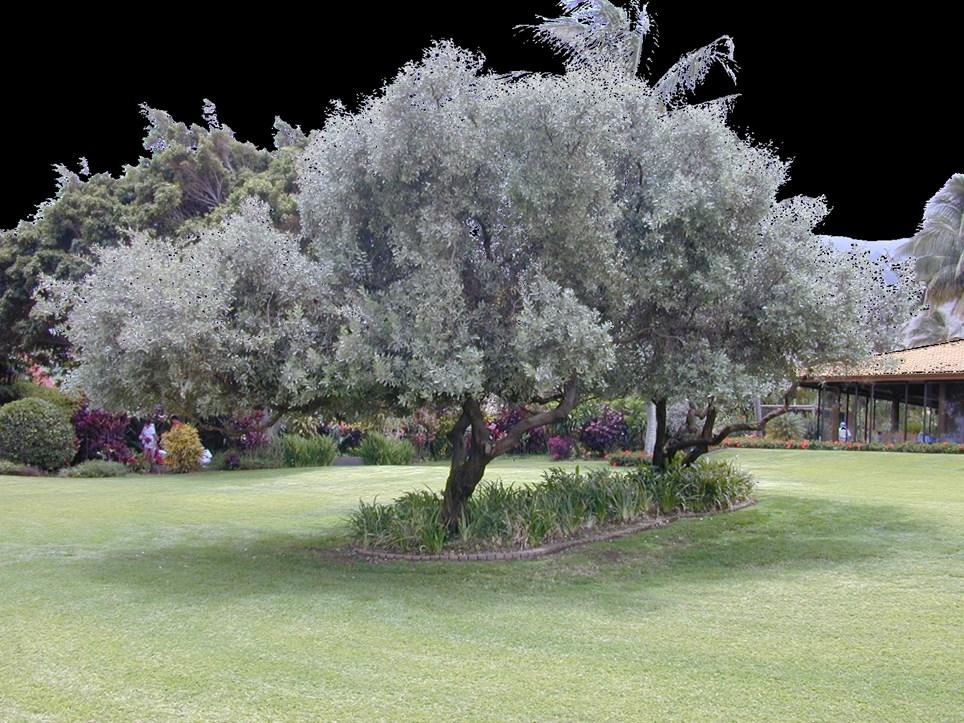
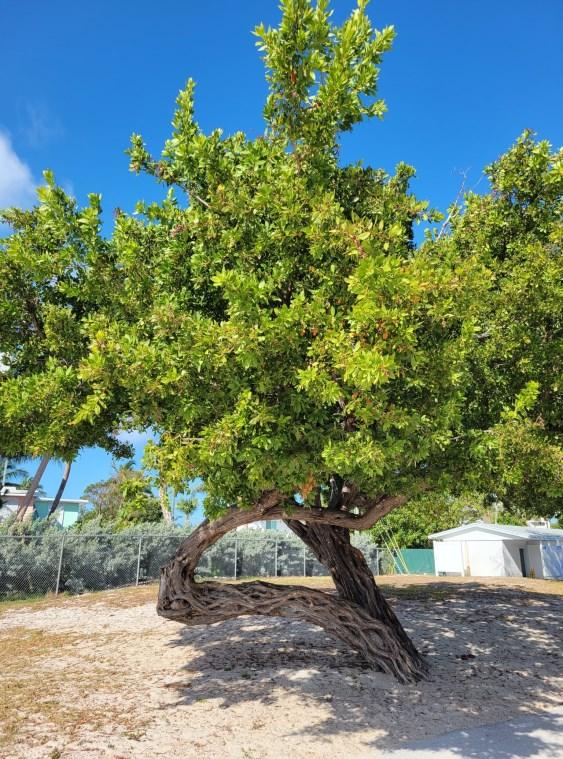 Bark of Mature Black Ironwood
Bark of Mature Black Ironwood
Credit:
Sandra Lee
Status Regionally Important Street Tree Eligible Salt Water Tolerance Low Salt Wind Tolerance Moderate
© kmpetteruti, (CC-BY-NC)
Black Ironwood in Understory Phase. Credit: Tree World Wholesale
1
© shinners, (CC-BY-NC)
Credit:
Forest
&
Kim Starr
Status Native Street Tree Eligible Salt Water Tolerance Moderate Salt Wind Tolerance High Swale Suitable Screening When Hedged Butterfly Plant Nectar Canopy
Canopy Species
Geigertree (Cordia sebestena)
While capable of reaching 25 feet, this species commonly attains a smaller stature, usually maintaining a columnar shape that stands taller than its width. Displaying stunning, vibrant orange flowers, the tree bears large, rough, and hairy leaves. It serves as a nectar source for butterflies such as the large orange sulphur and Schaus' swallowtail, thriving best in full sun to light shade. (Not so) Fun Fact: Geigertree has an interesting association with the captivating Geiger beetle. This iridescent beetle may inhabit the tree at various times of the year, often skeletonizing the top portions of leaves. Although this damage might appear unsightly, it rarely proves fatal to the tree.


Gumbo Limbo (Bursera simaruba)
One of the most recognizable trees in Florida Keys hammocks, gumbo limbo reach 50 feet in height often exhibiting a width equivalent to their height. Mature specimens have large diameter trunks often with a shiny, peeling red outer later. Known as the 'tourist tree' due to its bark resembling a sunburnt tourist, this tree also serves as a host plant for the dingy purplewing butterfly. It makes a nice shade tree but will lose its leaves in cooler weather. The overall tree is resistant to high winds, but branches may drop in very strong winds. An associated pest, the gumbo limbo spiraling whitefly, typically will not kill the plant but may cause damage. The most bothersome symptoms are the related honeydew and sooty mold that coats the surface of plants and nearby objects.
Fun Fact: The soft, lightweight, easily carved wood was used for making carousel horses.
Tall Trees


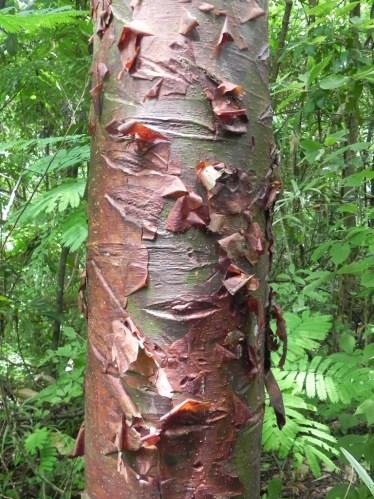
2
Credit: TopTropicals.com Status Regionally Important Street Tree Eligible Salt Water Tolerance Low Butterfly Plant Nectar Credit::
armelle mathe (cc-by-sa)
Status Native Salt Water Tolerance Low/Mod Salt Wind Tolerance High Butterfly Plant Host
© sflamand, (CC-BY-NC)) Canopy
Credit:RichardCrook (CCBY-NC-SA2.0)
Credit: Delray Garden Center
Canopy Species Tall Trees
Inkwood (Exothea paniculata)
Inkwood is commonly seen in high elevation tropical hardwood hammocks and is frequently encountered in the Upper and Middle Keys. It is rare in the Lower Keys. This tree can reach heights of up to 50 feet and is distinguished by its glossy compound leaves, usually composed of four elongated leaflets. Its white flowers, adorned with yellow disks, form semi-showy clusters. This species exhibits a moderate to slow growth rate and thrives best in light shade to full sun. Species specialty: The fruits were utilized in ink production, while the dense, sturdy wood found application in boat construction, marine pilings, and crafting tool handles.
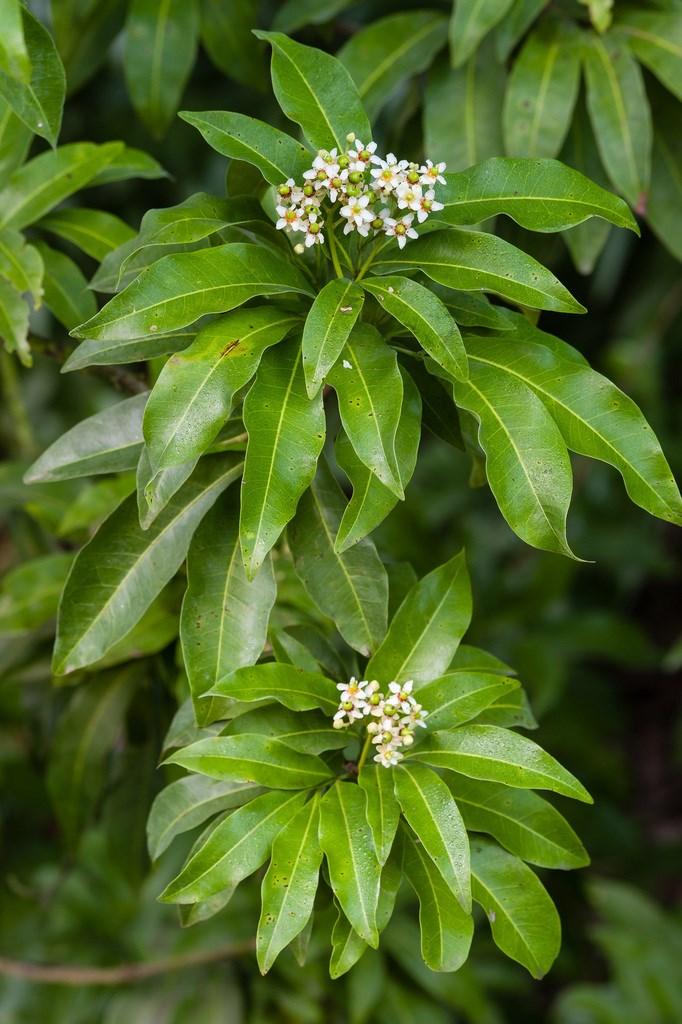

Canopy
Jamaica Dogwood (Piscidia piscipula)
A tree to 35 feet in height adorned with soft light-green compound leaves. Exhibits striking light-pink to white flowers that bloom (AprilJune) in clusters. The tree is deciduous and will loose its leaves, but this just serves to show off the striking blooms. It is a host plant for the hammock skipper and the fulvous hairstreak butterfly. Fun Fact: The leaves, twigs, and bark contain toxins historically used by Native Americans to stupefy fish for easier capture, a practice now prohibited by state law. The wood has found application in shipbuilding, while other parts are utilized for various medicinal purposes.

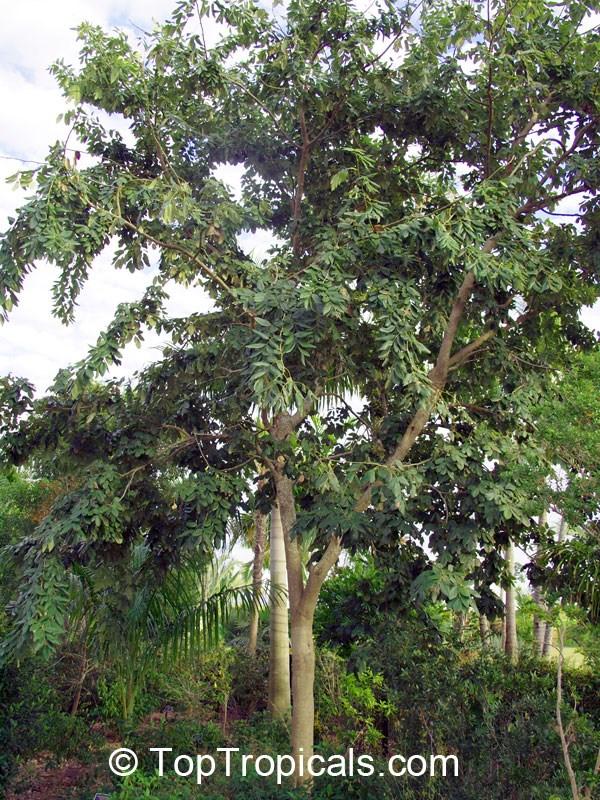
3
Status
Salt Water Tolerance
Salt
Regionally Important
Low
Wind Tolerance Moderate Swale Suitable Showy Flowers/ Fruits Semi-showy Street Tree Eligible
© Keith Bradley, (CC-BY-NC)
Status
Salt Water Tolerance Low/Mod Salt Wind Tolerance Moderate
© Wayne Longbottom, (CC-BY-NC)
Native
Showy Flowers/ Fruits Semi-showy Butterfly Plant Host Street Tree Eligible
Credit: Tree World Wholesale
Canopy Species
Lancewood (Damburneya coriacea)
A 25-foot tree features reddish-brown bark with cork deposits and showcases delicate white flower clusters on long-stalked panicles. Its leaves notably curve downward. The species typically maintains a slightly smaller stature compared to most canopy trees and is often observed in the understory. This species is prevalent in the hammocks of the Middle and Upper Keys but rare in the Lower Keys. Blooming occurs from May to August, and it thrives best in light shade to full sun.

Mastic (Sideroxylon foetidissimum)
A tree to 70 feet tall with long undulating leaves clustered at the end of stems and large buttressed trunks. It has an irregular, rounded canopy. Yellow flowers bloom along the stems from March to December. The tree grows at a moderate pace and thrives in hammocks in the Middle and Upper Keys. It makes a good shade tree but the fruits can be messy. Prefers full sun. Species
Specialty:
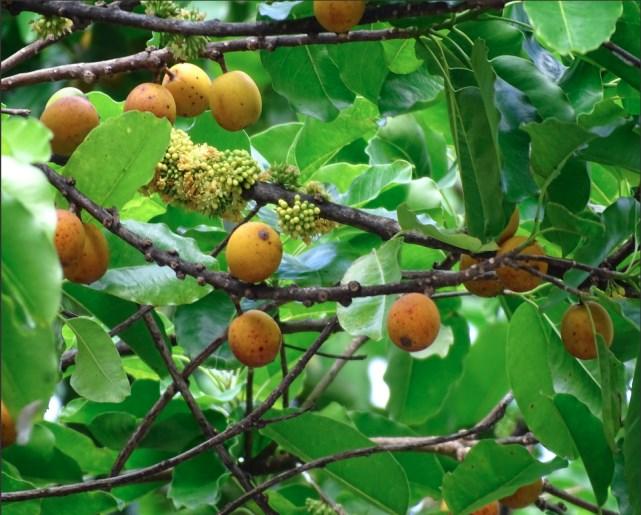
hardwood is used in cabinetry and shipbuilding.
Tall Trees
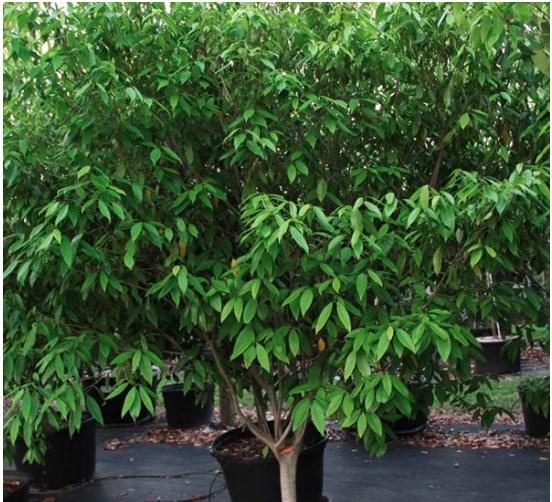
Showy Flowers/ Fruits
Semi-showy


4
Status Regionally Important Street Tree Eligible Salt Water Tolerance Low Salt Wind Tolerance Mod/High Screening Suitable
The
Credit: Tree World Wholesale
Credit: Janice Broda
Credit: Jenny Evans (CC BY-NC)
Status Regionally Important Street Tree Eligible Salt Water Tolerance Low Salt Wind Tolerance Mod/High Swale Suitable
Buttressed Trunk © mg509537, (CCBY-NC)
Canopy
© Alexis López Hernández, (CC-BY)
Canopy Species
Milkbark (Drypetes diversifolia)
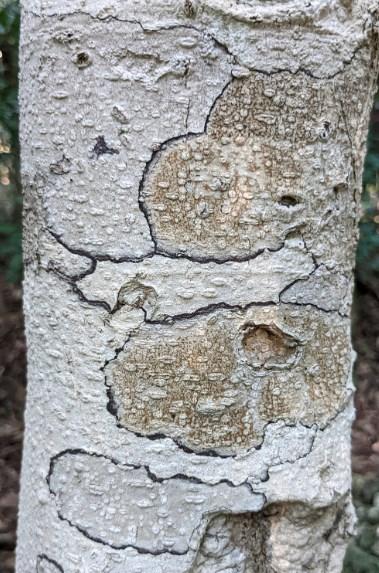
Grows to 30 feet but typically smaller. It’s stiff leathery leaves and striking lenticel covered milk-white bark makes it a worthy specimen tree in any landscape. While it may serve as a shade tree, it exhibits an exceptionally slow growth rate. Typically found in rockland hammocks, this species prefers light shade and serves as a host plant for the Florida white butterfly. Although challenging to find commercially, the milkbark tree is undoubtedly worth the effort due to its unique and impressive qualities.
Tall Trees
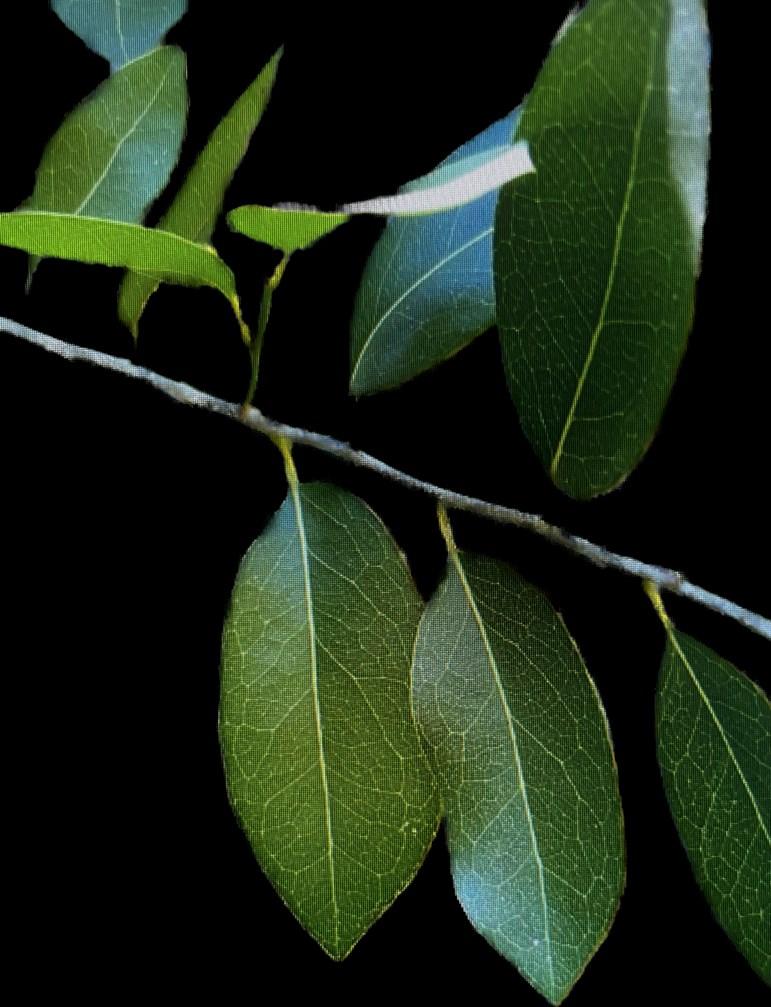
Paradise Tree (Simarouba glauca)
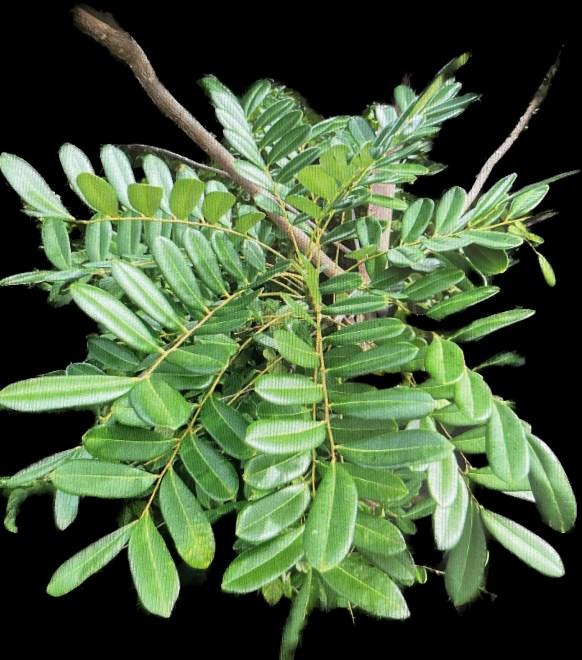
Highly suitable as a specimen or shade tree. Growing to 50 feet in height with a spread of up to 30 feet, the tree has beautiful glossy green compound leaves and 1” long (somewhat messy) fruits that ripen from orange to dark purple. The tree has a slow to moderate growth rate and will grow in full sun or partial shade.


5
© Kristof Zyskowski, some rights reserved (CC-BY)
© angelkelley, (CC-BY-NC)
Status Endangered Street Tree Eligible Salt Water Tolerance Low Salt Wind Tolerance Low Butterfly Plant Host Status Regionally Important Street Tree Eligible Salt Water Tolerance Low Salt Wind Tolerance Mod/High Swale Suitable
© Samuel Brinker, (CC-BY-NC) edited
©
volpen, (CC-BY-NC)
Canopy
Canopy Species
Pigeon Plum (Coccoloba diversifolia)
A standout accent or specimen tree, reaching heights of 30-40 feet and displaying a relatively fast growth rate. It features peeling, mottled bark that adds considerable allure to landscapes. The leaves, bright green in color, showcase petioles that seemingly wrap around the stem. Thriving in various light conditions from full sun to light shade, this hammock species serves as a nectar source for butterflies such as the large orange sulphur, Schaus' swallowtail, and several others.

Species Specialty: This tree has the added benefit of being a food source for the threatened white-crowned pigeon.
Princewood (Exostema caribaeum)
Tall Trees
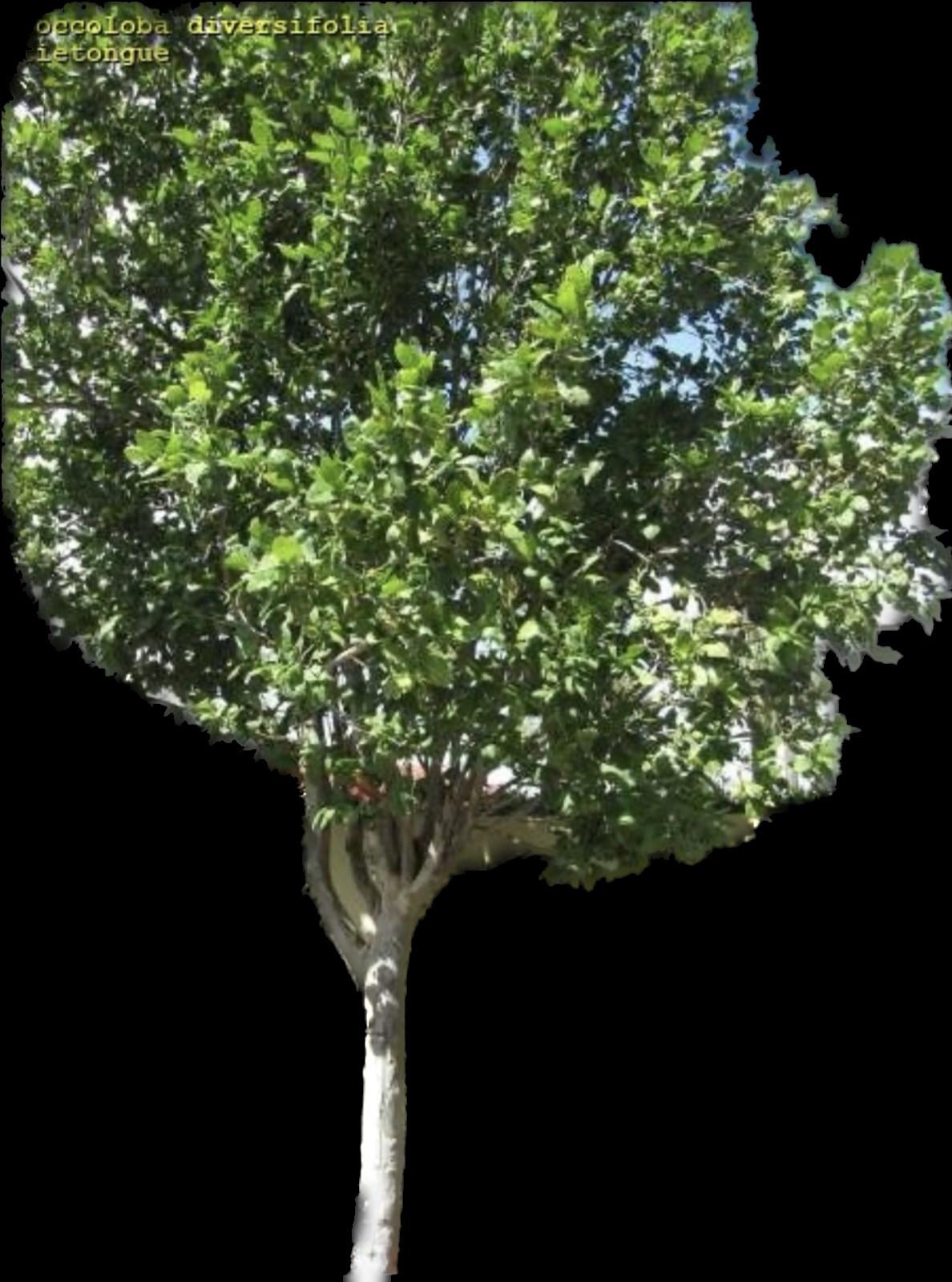
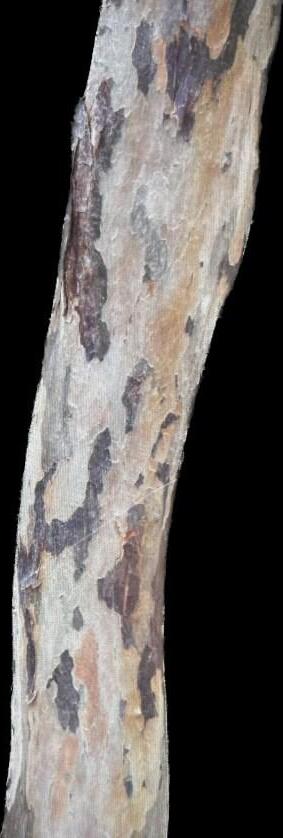
Princewood is more often seen as a small tree or shrub and can grow to 18 feet. The tree has dark green, shiny, often wavy leaves. Its most distinguishing characteristic is the white flaring tube flowers with long splashy recurved lobes. These flowers emit a fragrant, vanilla-like scent during the night, making them a distinctive trait of the tree.
Species specialty: Extracts from this source have been utilized in specific regions worldwide to address various ailments, including the mitigation of malaria symptoms. Moreover, the highly flammable wood has found practical use as material for torches.

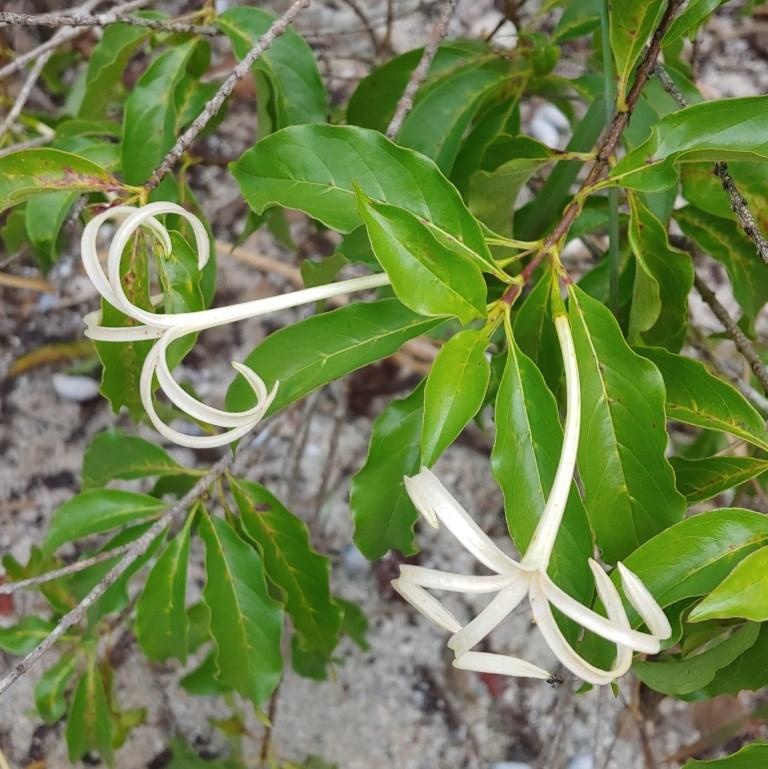
6
© Rachel Stringham, (CC-BY) , background edited.
Status Native Street Tree Eligible Salt Water Tolerance Low Salt Wind Tolerance Moderate Screening Suitable Butterfly Plant Nectar
© ALAN SANKEY, (CC-BY-NC) Background edited.
(c) Kurt
Miller (CC BY-NC)
Status Endangered Street Tree Eligible Salt Water Tolerance Low Salt Wind Tolerance Low Showy Flowers/ Fruits Semi-showy
Canopy
© Luis Humberto Vicente-Rivera, (CC-BY-NC)
© Forest and Kim Starr (CC BY 2.0 DEED)
Canopy Species
Satinleaf (Chrysophyllum oliviforme)
Tall Trees
Satinleaf, with its shimmering copper leaves, makes a wonderful specimen or accent tree in the landscape. The tree grows between 20-30 feet, sometimes up to 40 feet with a more columnar canopy. The leaves are dark green above with a coppery pubescence below. It grows at a slow to moderate rate and accepts full sun to light shade. The fruit can be a bit messy and you may not want to plant this tree adjacent to walkways.
Fun Fact: It has been reported that the Seminole Indians placed an extract from the wood ashes on the tongue of newlyweds to cleanse the body and strengthen the marriage.
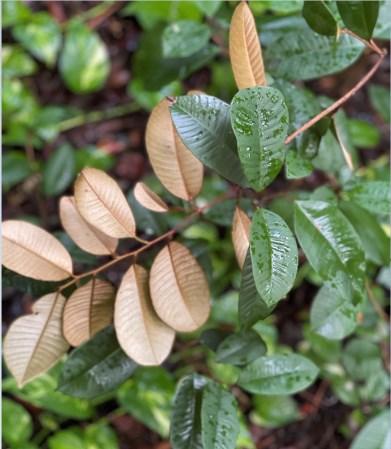


Seagrape (Coccoloba uvifera)
A tall, sprawling tree generally grows up to 20 feet but may reach a height of 50 feet. Typically, it features multiple trunk-like stems and attractive peeling bark. The large rounded leathery green leaves have prominent red veins and may reach 12 inches in diameter. The leaves are colorful when emerging and then again just prior to winter shedding. The leaves do not decompose quickly and may require removal if a tidier, more formal appearance is preferred. Skillful pruning can yield dramatic formations. This species does well near the shoreline and is a nectar plant for Florida duskywing, julia, and Schaus' swallowtail butterflies. Species Specialty: The showy grapes found on female trees are used locally to make Seagrape jelly.

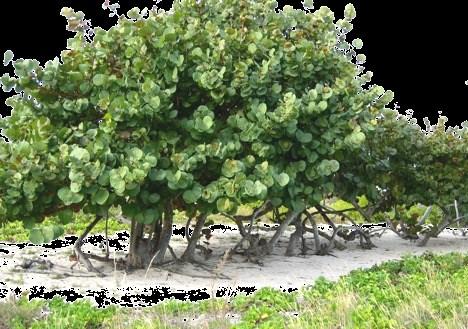
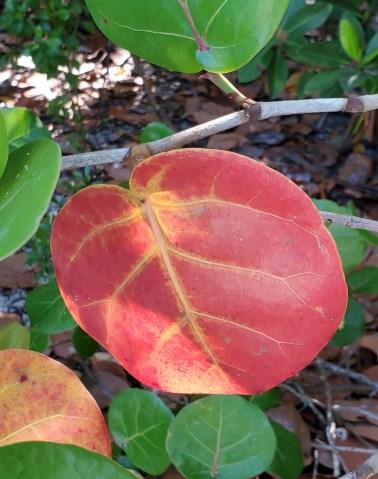
7
© Ceallaigh, (CC-BY-NC)
Salt
Salt
Showy
(c) VALENTINA ROUMI (CC BY-NC)
Status Native
Water Tolerance Moderate
Wind Tolerance Mod/High Swale Suitable
Flowers/Fruits Fruit & Leaves Street Tree Eligible Butterfly Plant Nectar Status Threatened Street Tree Eligible Salt Water Tolerance Low Salt Wind Tolerance Moderate Showy Flowers/ Fruits Fruit & Leaves Credit:
Veber’s Jungle Garden
Credit: Treeworld Wholesale
Monroe County Environmental Resources
Canopy
Canopy Species
Slash Pine (Pinus elliottii var. densa)
A conifer, a cone-bearing tree, typically reaches heights of 30-50 feet and is characterized by sparse branches and long “needles.” The tree is found in the pine rocklands of Big Pine Key and adjacent keys to the west. Planting this species outside of this specific area in the Keys is not recommended and will likely not be successful. Slash pines prefer full sun.
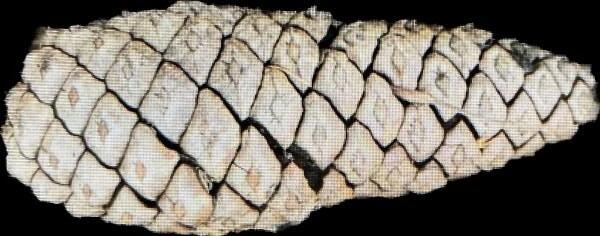
Tall Trees

Wild Tamarind (Lysiloma latisiliquum)
A towering tree to 50 feet in height, with wide spreading branches, offering ample shade. Have some room for this species, as the canopy spread can be as wide as the tree is tall. More common in the Upper Keys where its feathery, light-green, compound leaves can often be seen extending beyond the hammock canopy. The tree is relatively fast growing and prefers full sun. White puffball flowers bloom April to November, followed by flat, mottled, slightly twisted seed pods. It is the larval host for the orange sulphur, mimosa yellow, and cassius blue butterflies. The wood has been used for boat building and is coveted by wood carvers for its distinctive grain pattern.

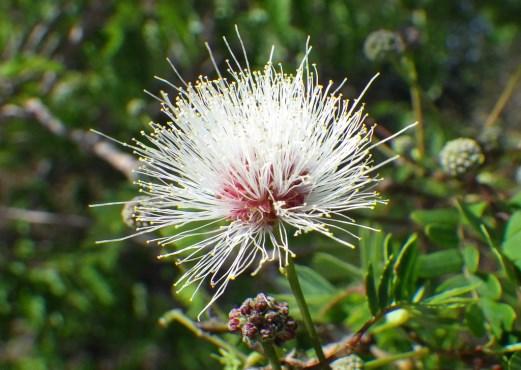
8
© Ben Machado, (CC-BY-NC)
Canopy
© Mike Jones, (CC-BY-NC) , Background removed.
Status Regionally Important Salt Water Tolerance Low Salt Wind Tolerance Moderate
Credit: Treeworld
Status Native Street Tree Eligible Salt Water Tolerance Low Salt Wind Tolerance Low Butterfly Plant Host
David Jeffrey Ringer, (CC-BY-NC)
Canopy
Canopy Species
Willow Bustic - Sideroxylon salicifolium
A common hammock tree growing to approximately 30 feet tall and forming a slender crown. It has narrow, curved, green leaves that are clustered toward the end of stems. This is a relatively fastgrowing species that prefers full sun. The species is a nectar plant for the Florida duskywing, red-banded hairstreak, and other pollinators. The species has been reported to support warblers, vireos, flycatchers, thrushes, blue jays and mockingbirds.
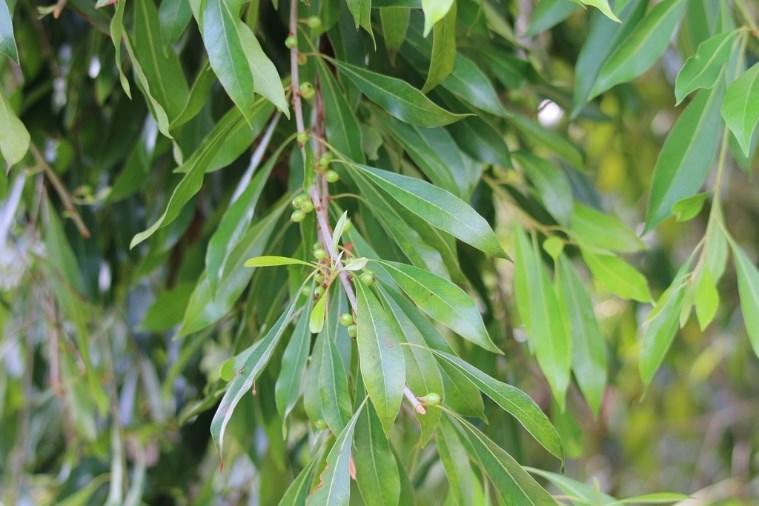
Tall Trees

Palms
Palm Trees
Buccaneer Palm - Pseudophoenix sargentii
A rare and stately species reaching to 25 feet tall and 12 feet wide. The species is extremely slow growing, but looks stunning in both its juvenile and mature phases. Trunks have very distinct rings, while its fronds display an enchanting greenish-blue hue on the upper side and a striking silvery shade below. Its flower stalks, stretching up to 3 feet tall, bear petite yellow flowers. Note: This species is often confused with the non-native Pseudophoenix vinifera. Be sure to purchase from a reputable nursery to secure the correct species.


9
Immature Buccaneer Palm
Status Endangered Salt Water Tolerance Low Salt Wind Tolerance Mod/High
KATHERINE WAGNER-REISS, CC BYSA 4.0,
Credit: Treeworld Wholesale
© juliakmil, (CC-BY-NC)
Status Native Street Tree Eligible Salt Water Tolerance Low Salt Wind Tolerance Butterfly Plant Nectar
Mature Buccaneer Palm Credit: Paul Craft/Palmpedia.com
Palm Trees
Cabbage Palm - Sabal Palmetto
Reaching heights of up to 40 feet, Florida's state tree, the majestic sabal palm, stands as an iconic addition to any landscape. This palm species is defined by its sturdy trunk, adorned with dark green fanshaped leaves that form a rounded crown. A unique feature lies in the base of its fronds, often remaining on the tree as "boots," creating a distinct appearance and serving as microhabitats for plants and beneficial wildlife. Renowned for its hurricaneresistant nature, this palm is a testament to resilience. Species Specialty: Notably referred to as the "Tree of Life" by Native Americans, nearly every part of this specimen was utilized leaves for thatching, trunks for sturdy pilings, and hearts as a source of food, known as swamp cabbage.

Credit: Nonbinary Naturalist -CCO 1.0
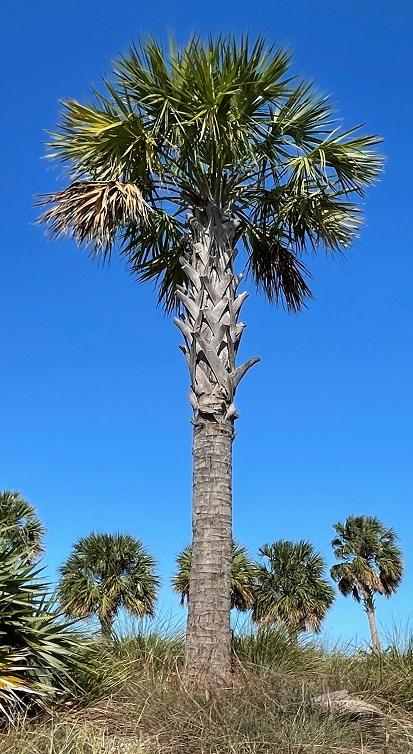
Credit: Monroe County Environmental Resources
Florida Thatch Palm (Thrinax radiata)
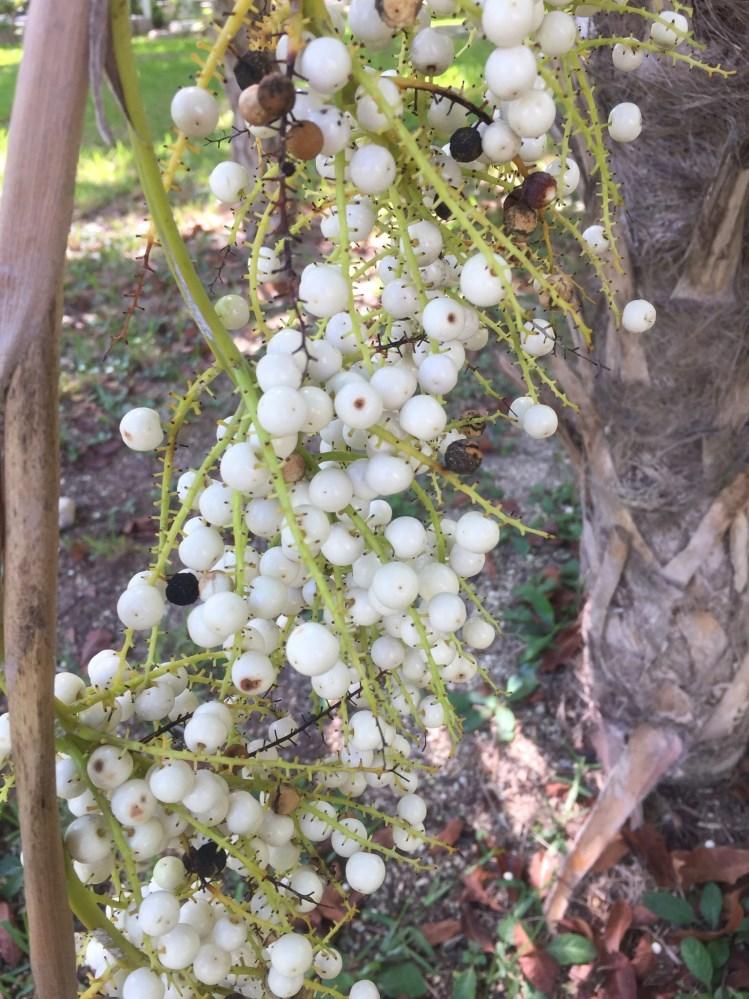

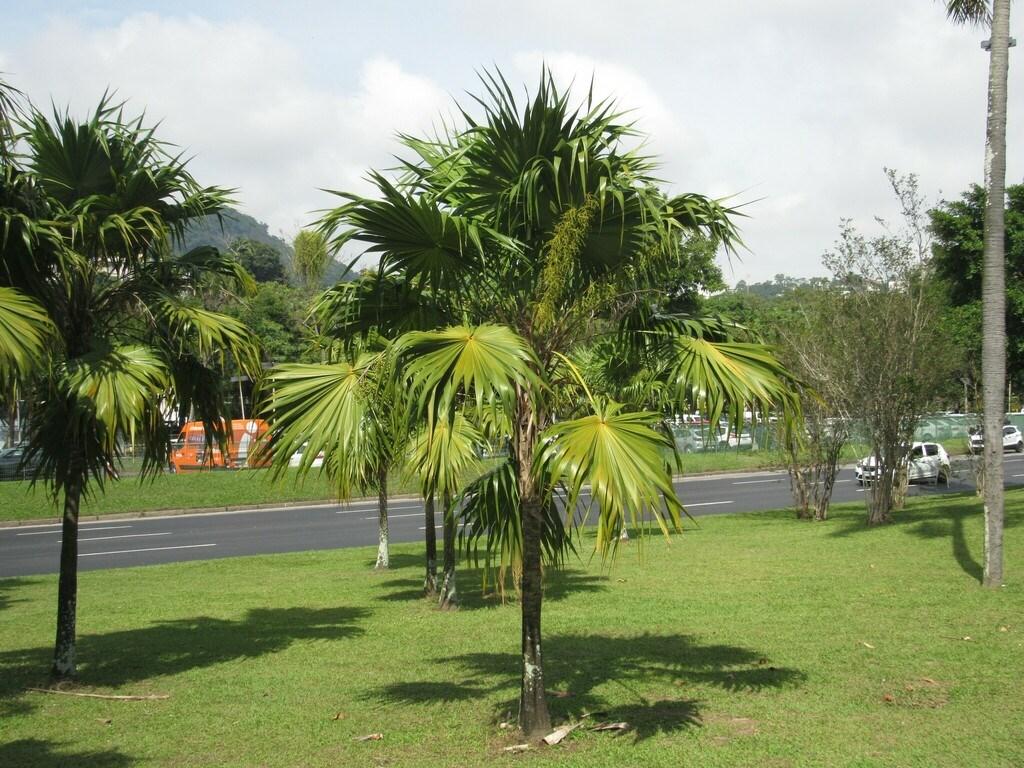
A slow growing solitary palm to heights of 28 feet, but more typically 10 to 20 feet. The fronds resemble hand-held fans, are green above and below. The creamy white flowers are arranged in clusters on spikes yielding relatively small white round fruits. They are the larval host plant for the monk skipper butterfly. ten confused with the Keys thatch palm (refer to page 11), the Keys thatch can be differentiated by the silver underside of its fronds.
10
© mavc, (CC-BY-NC)
© Alexis López Hernández, (CC-BY)
Status Endangered Salt Water Tolerance Low Salt Wind Tolerance Mod/High Swale Suitable Butterfly Plant Host Screening Suitable
© sajiacruz, (CC-BY-NC)
Palms
Status
Salt Water Tolerance Low/Mod Salt Wind Tolerance Mod/High Butterfly Plant Host /Nectar
Native
Palm Trees
Keys Thatch Palm (Leucothrinax morrisii)
A slow growing solitary palm to heights of 20 feet, but more typically 10 to 15 feet. The fronds resemble a handheld fan, are green above and silver below. The creamy white to yellow flowers are arranged in clusters on spikes and produce relatively small white round fruits. They are the larval host plant for the monk skipper butterfly and will tolerate full sun to light shade. The silvery underside of the frond differentiates this species from the Florida thatch palm shown on page 10.
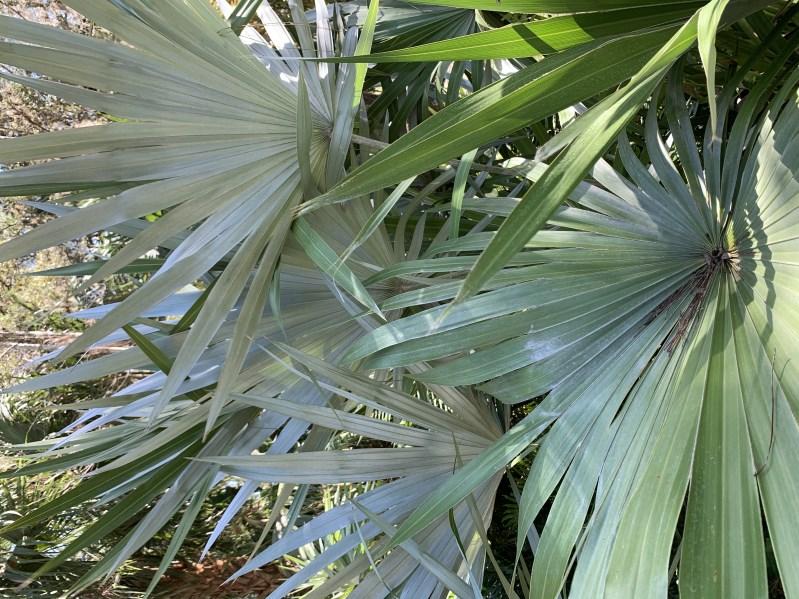
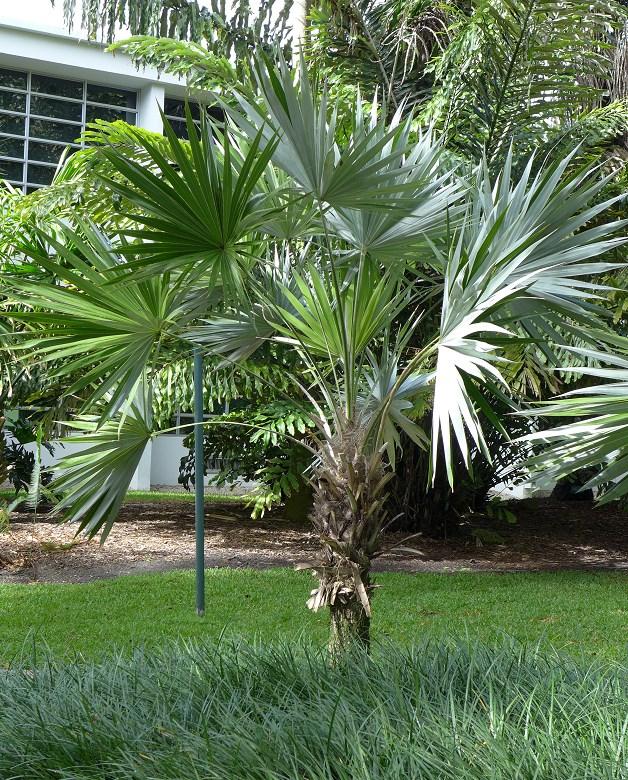
Palms
Silver Palm (Coccothrinax argentata)
A solitary palm up to 20 feet but often much smaller. The palm is slow growing and somewhat similar to the Keys thatch palm described above. Main differences include, fruits ripening to black, being smaller in stature, having more vivid silver coloring on the underside of the fronds and having fronds that are more lax with deeply divided segments. This last difference gives the fronds an elegant drooping appearance. Prefers well-drained soils. It is a host plant for the monk skipper butterfly.


11
Scott Zona, (CC BY-NC 2.0)
Status Endangered Salt Water Tolerance Low Salt Wind Tolerance Mod/High Swale Suitable Butterfly Plant Host Screening Suitable
Katharine Wagner Reiss (CC BY-SA 4.0)
Katherine Wagner-Reiss (CC BY-SA 4.0)
Waiting Steve@rarepalms.com Status Threatened Salt Water Tolerance Low Salt Wind Tolerance Mod/High Butterfly Plant Host
Palm Trees
Saw Palmetto (Serenoa repens)
A recumbent, spreading palm capable of reaching heights up to 10 feet (often smaller) and a width to ten feet. Stems typically trail across the ground. Fan-shaped fronds usually exhibit a green hue; however, a variant showcases striking blue-silver fronds. Notable are the sharp spines lining the leaf stems. This palm's unique growth pattern adds intriguing texture to any landscape.
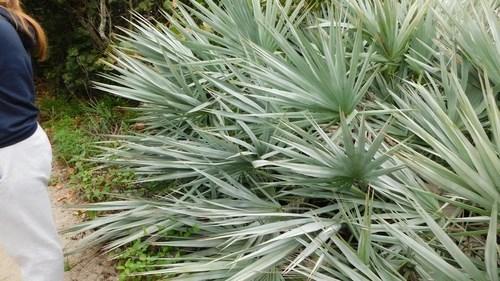
Fun Fact: Place this under your child’s bedroom window and you will never have to worry about them sneaking out at night.

Understory Species
Blackbead (Pithecellobium keyense)
Blackbead and it’s related species cat’s claw (Pithecellobium unguis-cati ) are common in Keys hammocks, but the latter is not currently commercially available. Blackbead has a sprawling branching pattern, creating a wide, shrub-like canopy. It has distinctive compound leaves, generally with four leaflets in pairs. The showy puffball shaped flowers vary from cream to light pink in color. The twisted, curling seed pods are also very showy revealing a red or white interior with shiny black seeds. Blackbead is also a host plant for the large orange sulphur, cassius blue, and Miami blue butterflies and a nectar plant for numerous butterfly species. The species prefers full sun.
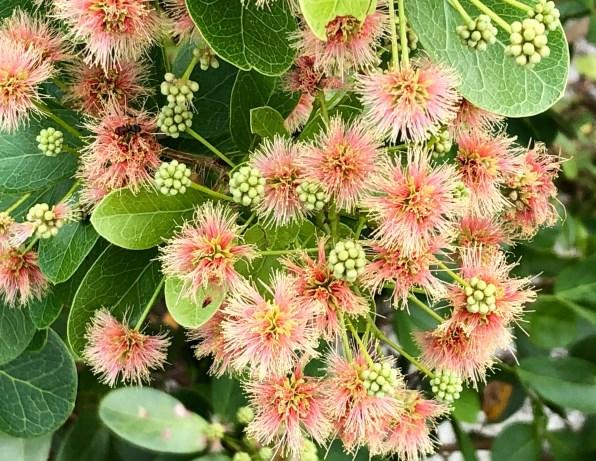
Small to Medium Trees
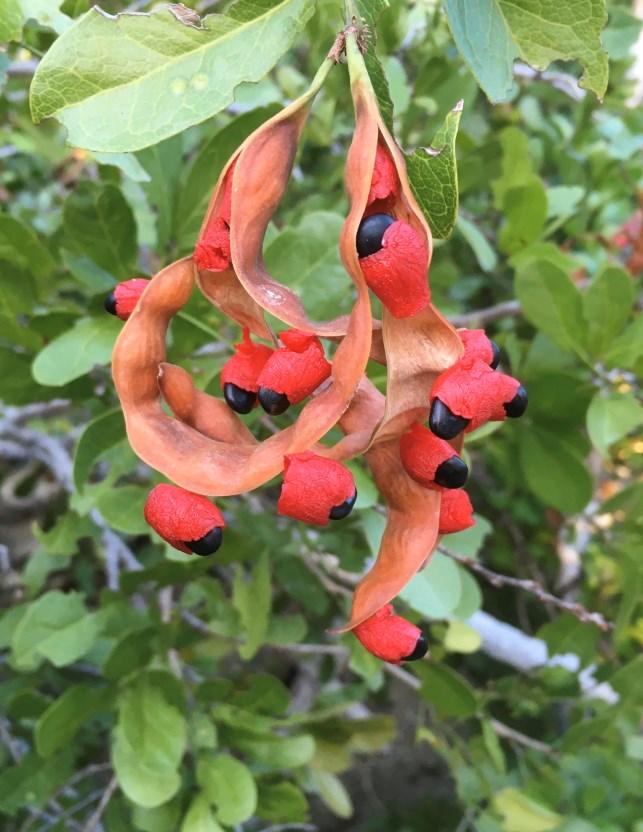
12
stephanie_naturalist, (CCO 1.0)
GardeningSolutions
(CCBY-NC2.0)
Status Endangered Salt Water Tolerance Low/Mod Salt Wind Tolerance Moderate Butterfly Plant Host
© marytod, (CC-BY-NC)
© brendanboyd, (CC-BY) Status Threatened Salt Water Tolerance Low Salt Wind Tolerance Moderate Swale Suitable Showy Flowers/ Fruits Semi-showy Screening Suitable Butterfly Plant Host/Nectar
Palms Understory
Understory Species
Blolly (Guapira discolor)
Typically a compact tree, yet capable of growing up to 30 feet in height, this underutilized species often displays numerous upright stems and limbs that create an elegant drooping profile. The bark's allure is further enhanced by patches of lichens, lending an artistically mottled charm. Female trees are adorned with strikingly vibrant pink or red drupes, imparting an exceptionally ornate appearance. This tree blossoms from May to August and thrives in conditions of full sun or partial shade.
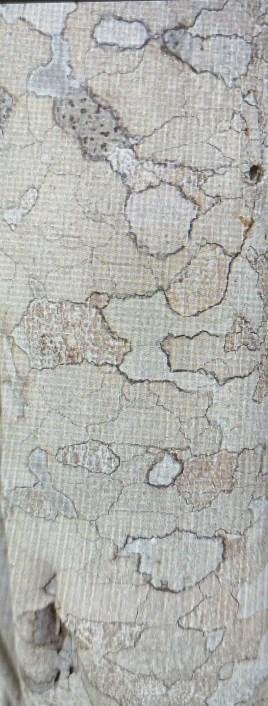

Cinnamonbark (Canella winterana)
A small evergreen tree reaching heights of up to 30 feet, distinguished by its spirally and irregularly arranged paddle-shaped leaves situated on short branches. Its distinctive growth pattern, adorned with vibrant white, red, or purple flowers, renders it a superb selection for a focal or accent tree. The strikingly bright red clusters of ripened fruits further enhance its visual appeal Underutilized in the landscape this tree promises a distinctive addition to any property. The Cinnamonbark, boasts year-round blooms and serves as a vital nectar source for the Schaus' swallowtail and various other butterflies.
Small to Medium Trees
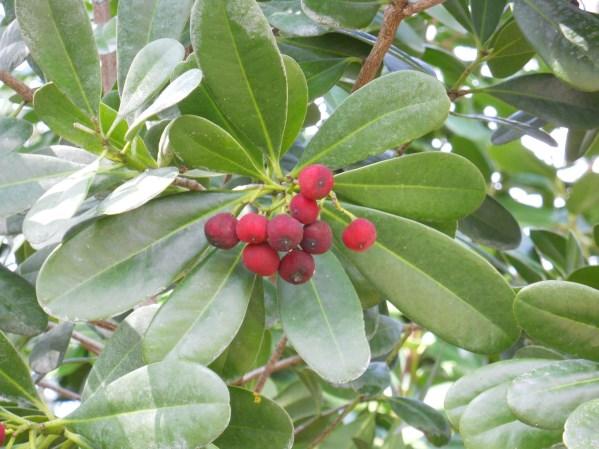
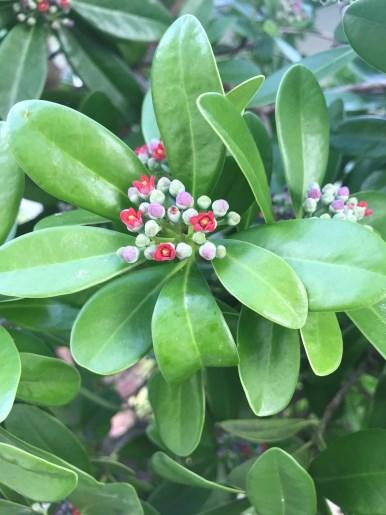

13
© bpdawson, (CC-BY-NC)
Status Endangered Salt Water Tolerance Moderate Salt Wind Tolerance Moderate Swale Suitable
Showy Flowers/Fruits Flowers & Fruit Street Tree Eligible Butterfly Plant Nectar
Credit: Richard Lyons Nursery
Monroe County Environmental Resources Status Threatened Salt Water Tolerance Low Salt Wind Tolerance Mod/High Screening Suitable
Showy Flowers/ Fruits Semi-showy Understory
Credit: TreeWorld Wholesale
Understory Species
Cinnecord (Vachellia choriophylla)
Typically a small tree, often standing below 15 feet in height, although occasionally stretching to 30 feet. Its width matches or surpasses its height, presenting a broad and robust appearance. Adorned with compound leaves housing numerous small, dark green leaflets, this tree produces tightly compact, yellow flowers that cluster into round puff-like balls, creating a delightful contrast against the backdrop of dark green foliage. Left unattended, its growth may resemble a sizable shrub, yet skilled pruning can shape it into a tree-like form. Notably, this species sporadically bears small stipular spines.
Small to Medium Trees
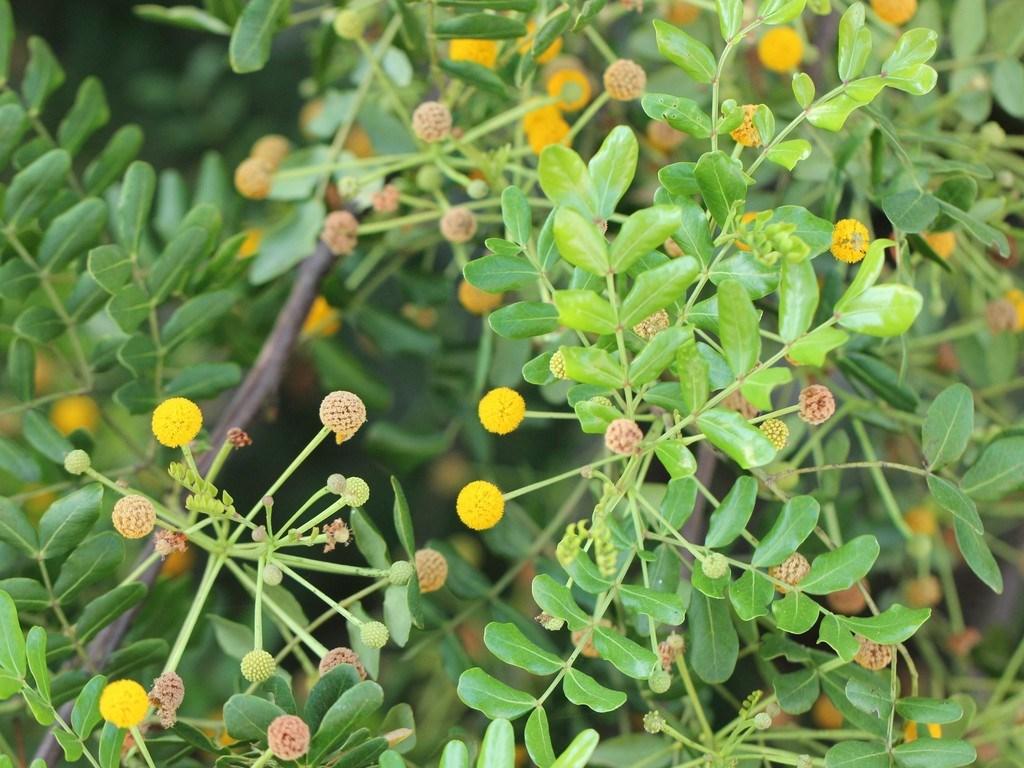

Crabwood (Gymnanthes lucida
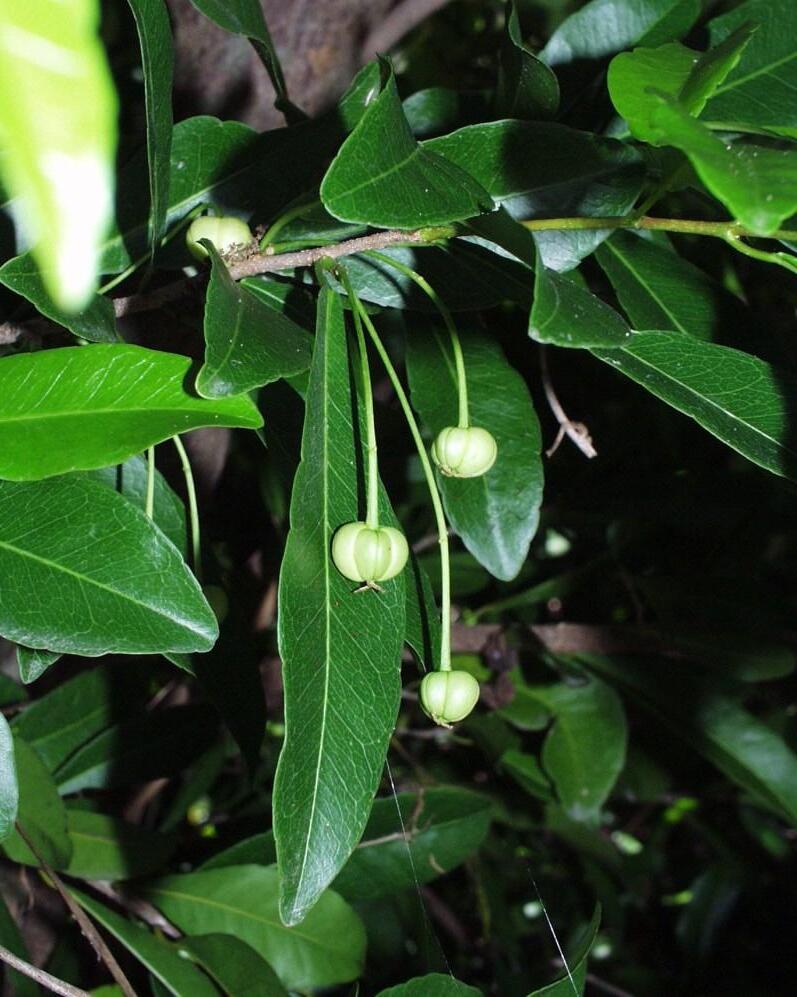
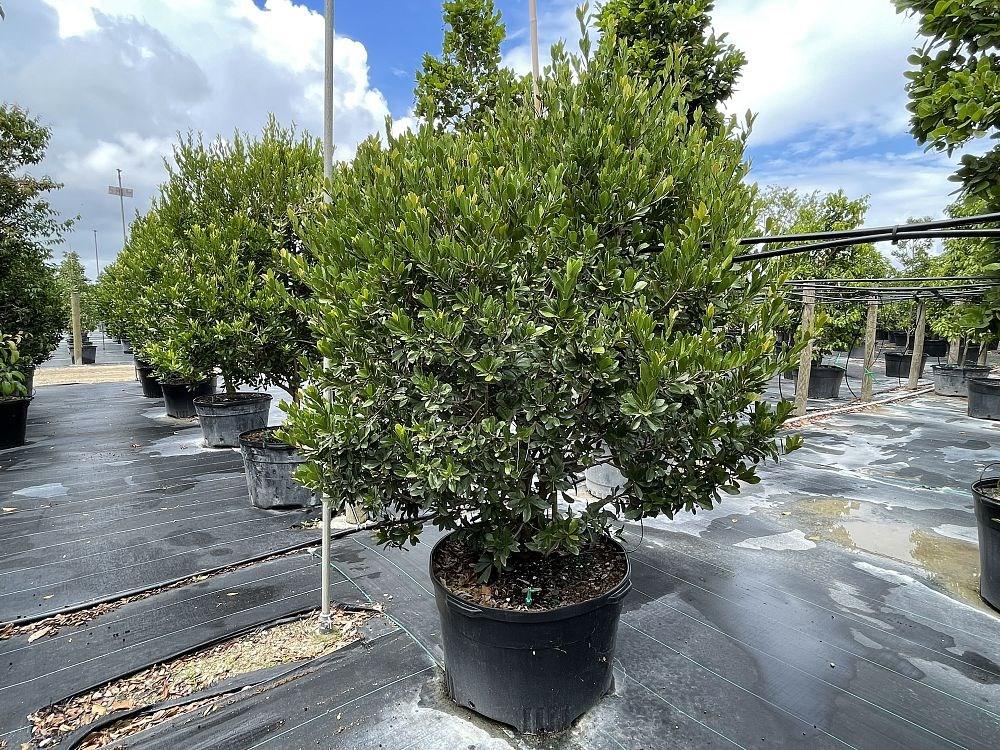
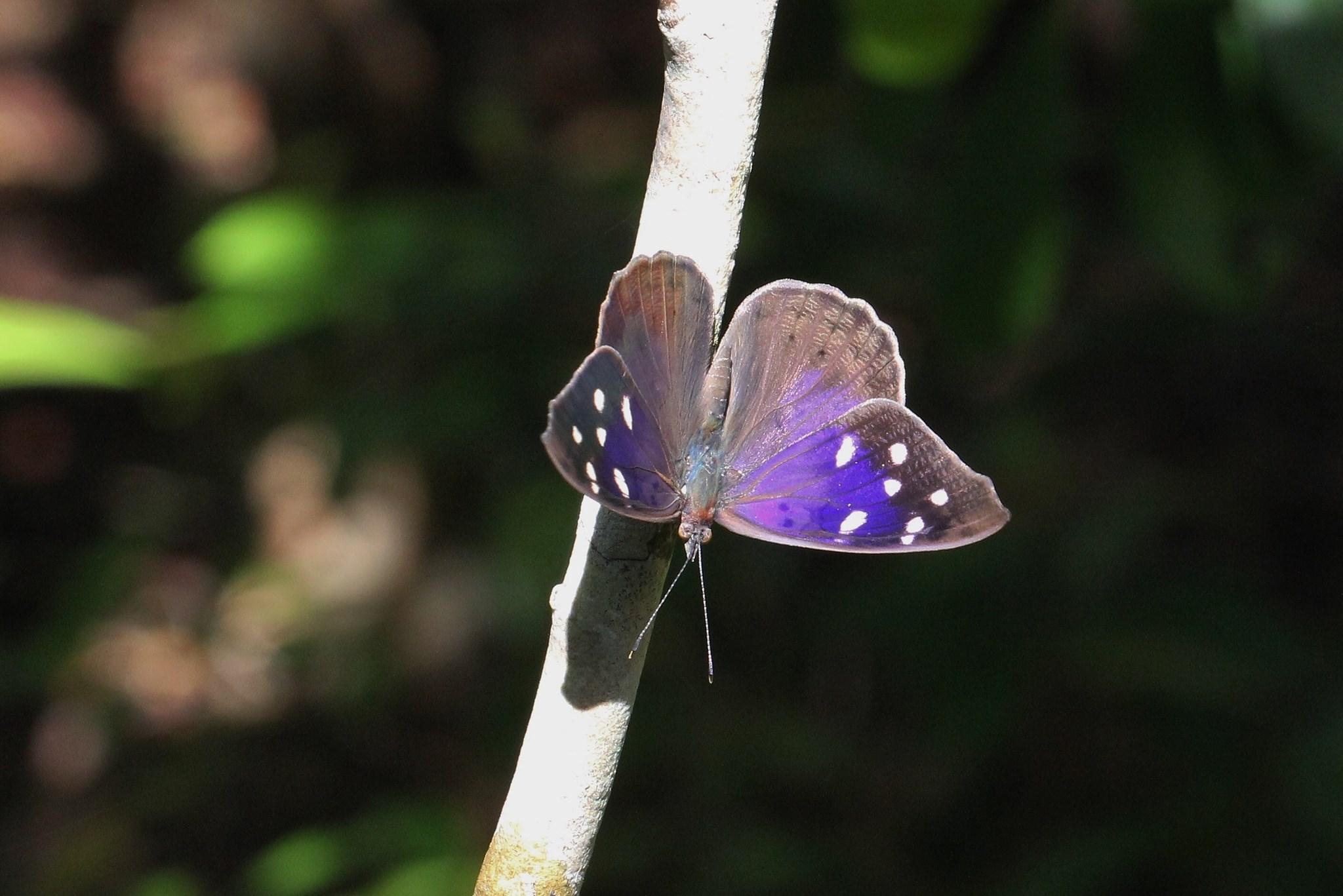
shade. The tree is a host species for the Florida purplewing butterfly.
14
Credit: Native Tree Nursery
Florida Purplewing Butterfly
©
Bart Jones, (CC-BY-NC)
Status Regionally Important Street Tree Eligible Salt Water Tolerance Low Salt Wind Tolerance Moderate Butterfly Plant Host Screening Suitable Tri-
lobed fruit
© Bruce Holst, (CC-BY-NC)
Understory
Credit: Farm Life Nursery © jrcagle, (CC-BY)
Status Endangered Salt Water Tolerance Low Salt Wind Tolerance Moderate Screening Suitable Showy Flowers/ Fruits Semi-showy
Understory Species
Darlingplum (Reynosia septentrionalis)
Small to Medium Trees
A compact tree, usually reaching heights of around 15 feet, though occasionally growing up to 28 feet. Identified by its rigid leaves that taper to a distinct dimple at their tips, this species bears edible dark purple to black plum-shaped fruits. Its canopy displays an irregular growth pattern, while the trunk features reddish-brown bark that flakes into plate-like scales, adding a unique visual appeal. Thriving in conditions from full sun to partial shade, this tree boasts robust hardwood and is commonly known as red ironwood.

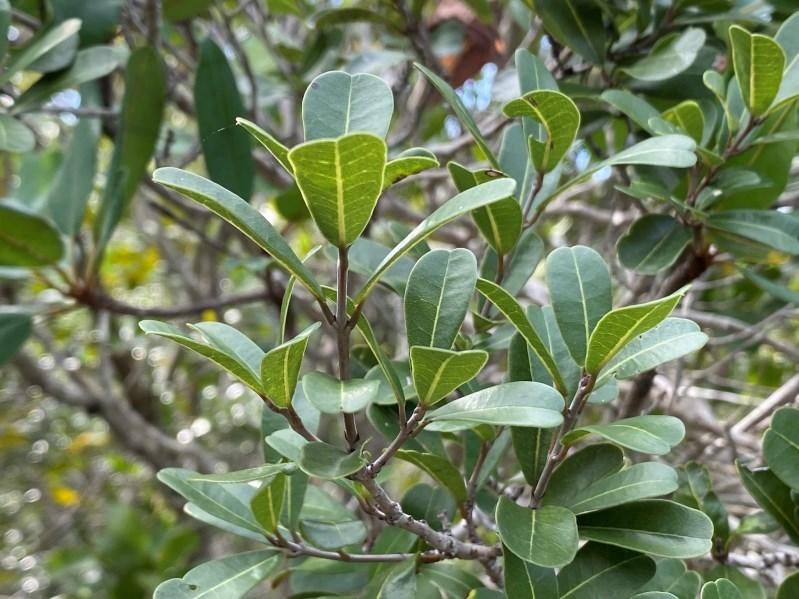
Fiddlewood (Citharexylum spinosum)
A charming shrub or petite tree reaching heights of 15 to 20 feet, adorned with gracefully arching branches. Its small, white flowers, clustered on a drooping raceme, create a captivating ornamental display, especially against the backdrop of its lustrous, dark green foliage. This slow-growing species thrives in conditions of full sun to partial shade. Additionally, it's noted as a nectar source for butterflies, adding ecological significance to its delightful ornamental qualities. Status Regionally Important

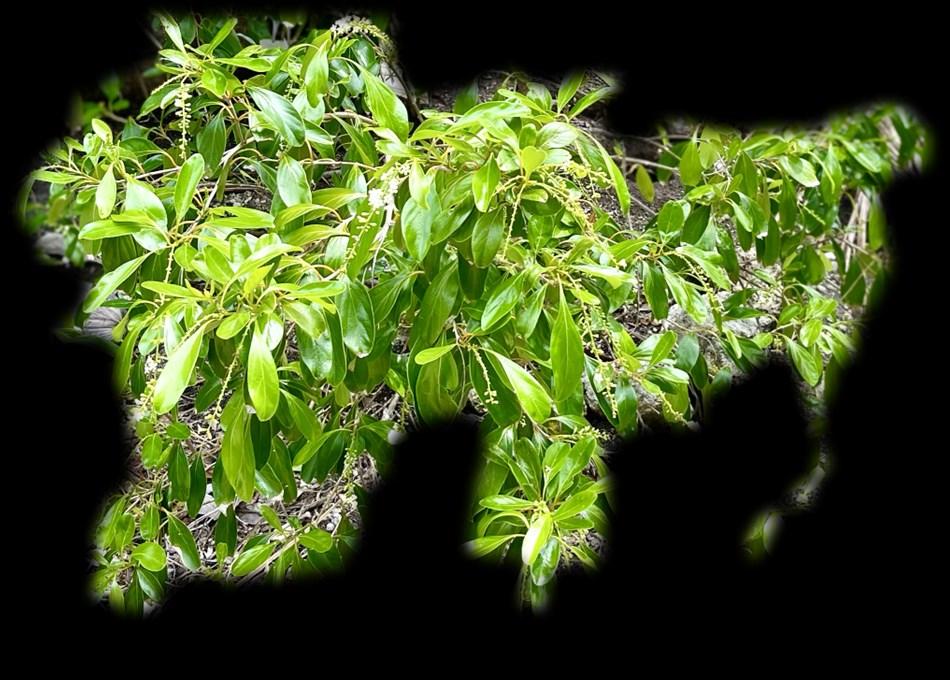

Salt Water Tolerance Low Salt Wind Tolerance Butterfly Plant Nectar Showy Flowers/Fruits Semi-showy
15
© David Jeffrey Ringer, (CC-BY-NC)
© Stan Shebs, (CC-BY-SA)
Status Threatened Salt Water Tolerance Low Salt Wind Tolerance Moderate Swale Suitable Understory
Credit: Monroe County Environmental Resources
Understory Species
Jamaica Caper (Quadrella jamaicensis)
A tall shrub or small tree with a columnar canopy. Often chosen for landscapes due to its striking features, this plant stands out for its dark green leaves contrasted by shimmering silvery undersides. It showcases showy white to pink fragrant flowers with vibrant elongated stamens, complemented by artistically curved seed pods. Thriving in full sun to partial shade, it serves as the host plant for the Florida white butterfly.
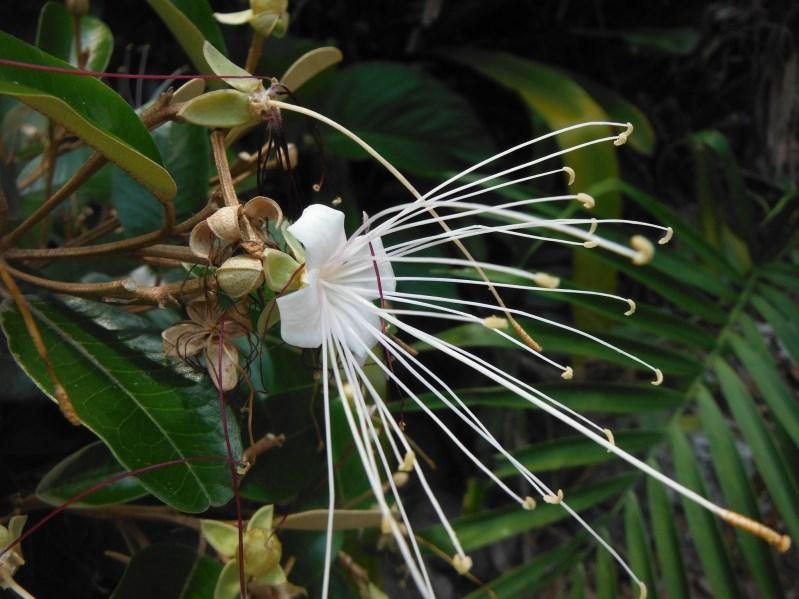
Small to Medium Trees
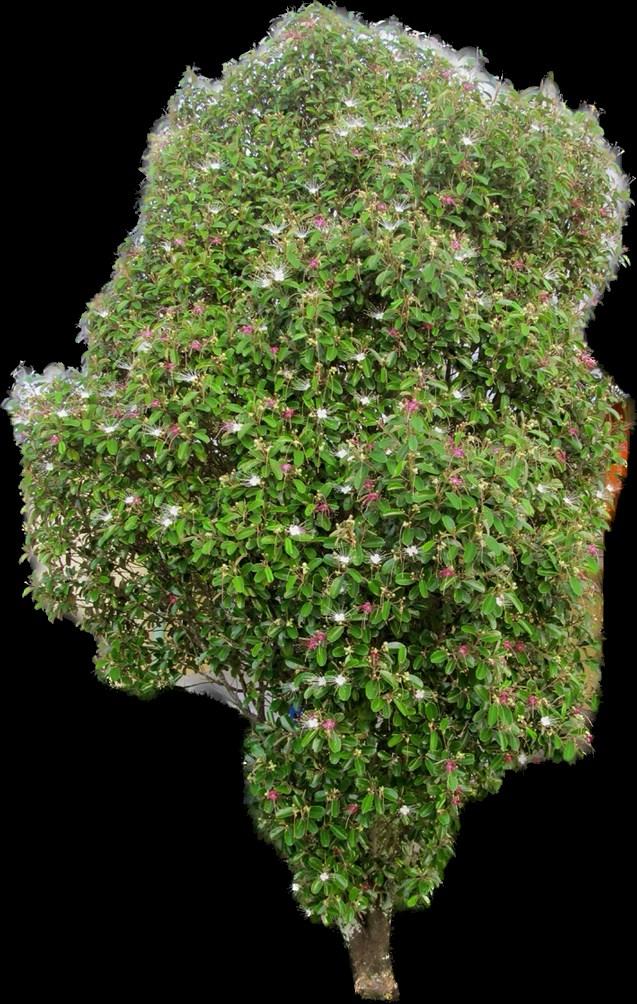

Joewood (Jacquinia keyensis)
An underutilized small tree with showy clusters of white flowers which contrast nicely with the succulent dark green leaves. The distinctive mottled bark of this species enhances its appeal as an accent tree. Flowers are fragrant and produce cream-colored fruits. This species is more common in the Lower Keys where it typically grows in the ecotone between mangrove shorelines and hammocks. Joewood prefers full sun to light shade. The species is also known as Cudjoewood.
IMPORTANT: This species may be confused with Jacquinia arborea which has larger leaves and fruits ripening to orange. Be sure to purchase from a reputable native nursery.
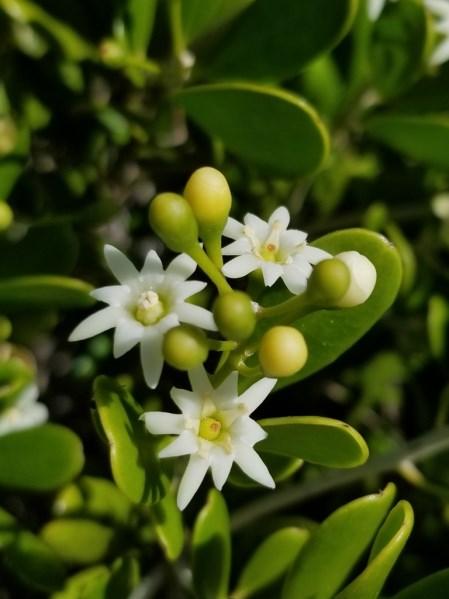
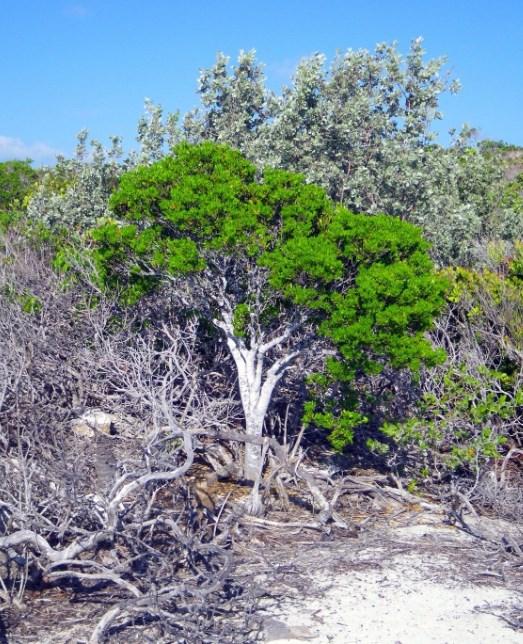
16
Credit: Richard Lyons Nursery
Status Native Salt Water Tolerance
Salt Wind Tolerance
Screening
Showy Flowers/ Fruits
Butterfly
(c) Livan (CC BY-NC)
Low
Mod/High
Suitable
Semi-showy
Plant Host
Credit: TreeWorld
Status Threatened Salt Water Tolerance Moderate Salt Wind Tolerance High Swale Suitable Showy Flowers/ Fruits Semi-showy Understory
© Adam Hull, (CC-BY-NC)
Credit: Monroe County Environmental Resources
Understory Species
Lignumvitae (Guaiacum sanctum)
A small specimen tree or shrub adorned with vibrant purple flowers and a spreading canopy. Its bright yellow-orange fruits, upon opening, reveal seeds adorned with a red aril. Lignumvitae serves as a larval host plant for the lyside sulphur butterfly.

Fun fact: This tree's high resin content has made it highly sought-after for self-lubricating bearings, including ship propeller-shaft bearings, pulleys, and various other applications.
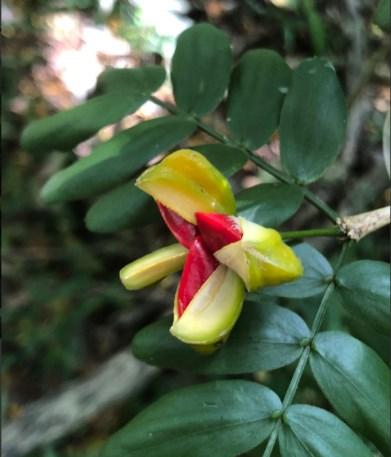
Small to Medium Trees

Status
Eligible
Limber Caper (Cynophalla flexuosa)
A small tree or climbing woody vine boasting showy white flowers adorned with numerous slender elongated stamen. Its fruits take the form of lengthy pods that gracefully split open, unveiling a red interior housing white seeds. Limber caper plays a vital role as the host plant for the Florida white butterfly and provides food for birds.
Fun Fact: Can be grown from seed.
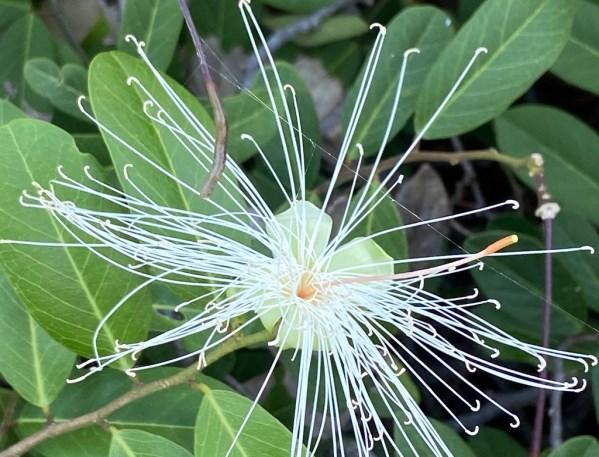
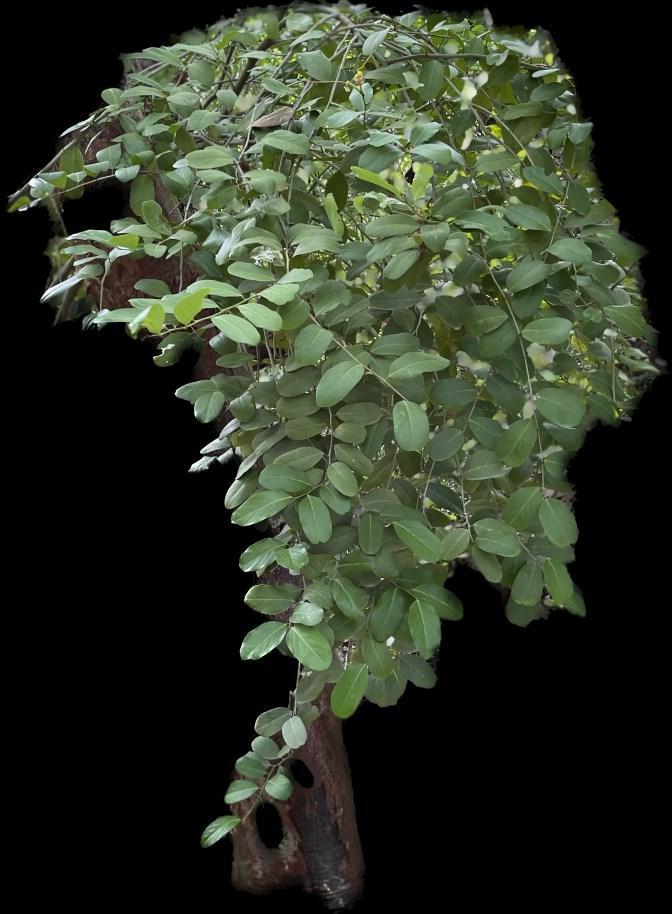
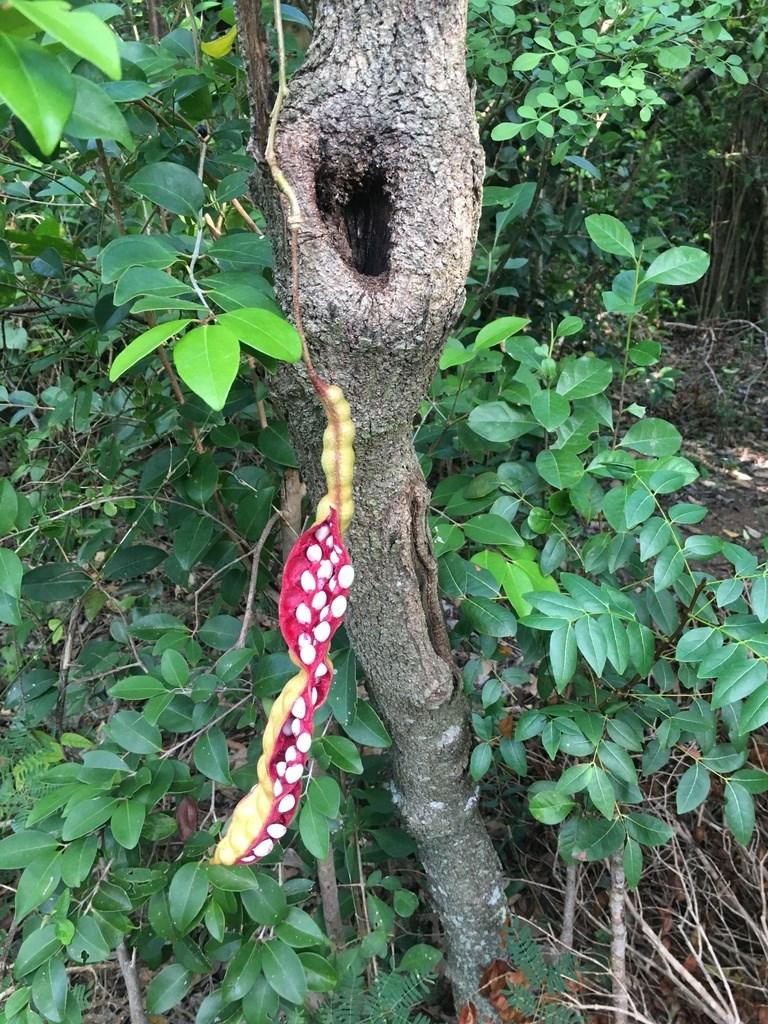
17
(c) Jason Sharp, some rights (CC BY-NC-SA)
(c) Jason Sharp, rights
Endangered Salt Water Tolerance Low/Mod Salt Wind Tolerance Moderate Showy Flowers/ Fruits Semi-showy Street Tree
c) sheldonmcgregor – (CC BY-
Status Native Salt Water Tolerance Low/Mod Salt Wind Tolerance Moderate Butterfly Plant Host (c)
Armando Feliciano – (CC BY-NC)
(c) jonathan_chama_corrales – (CC BY-NC)
Understory
(c) taniarm , (CC BY-NC) lt422, (CC BY-NC)
Understory Species
Marlberry (Ardisia escallonioides)
A shrub to small tree displaying a columnar growth pattern. The species has large, leathery, glossy green leaves, spirally arranged on the stems. Its showy clusters of white to light purple flowers at the stem ends transform into deep purple ripening fruits. Frequently, the limbs gracefully bow under the weight of these flowers and fruits. The plant prefers light shade to full sun and is known to attract a diverse array of birds.
Fun Fact:
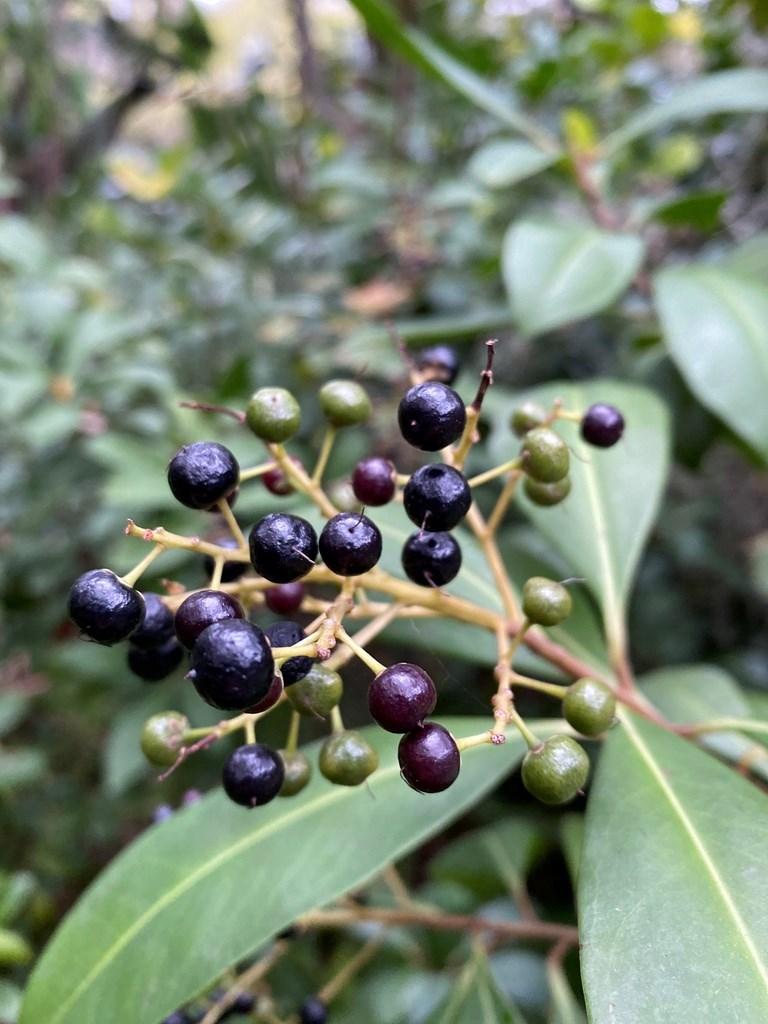
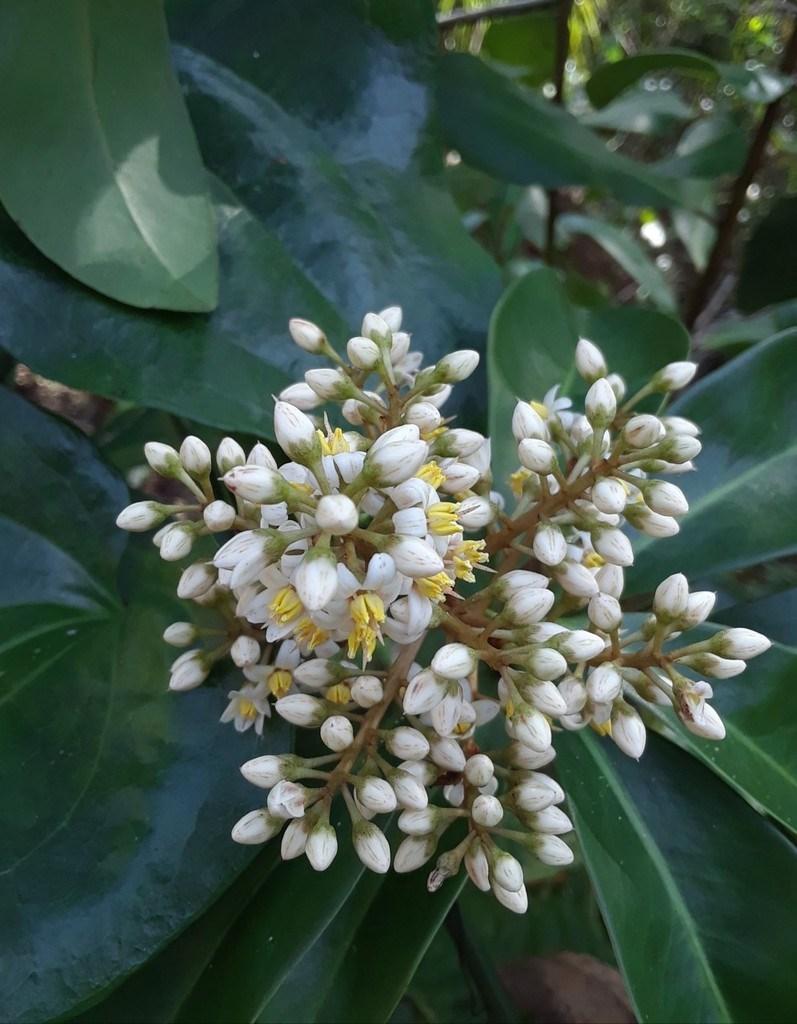
Historical accounts suggest that the Miccosukee Indians incorporated the leaves into their smoking tobacco practices.
Myrsine (Myrsine cubana)
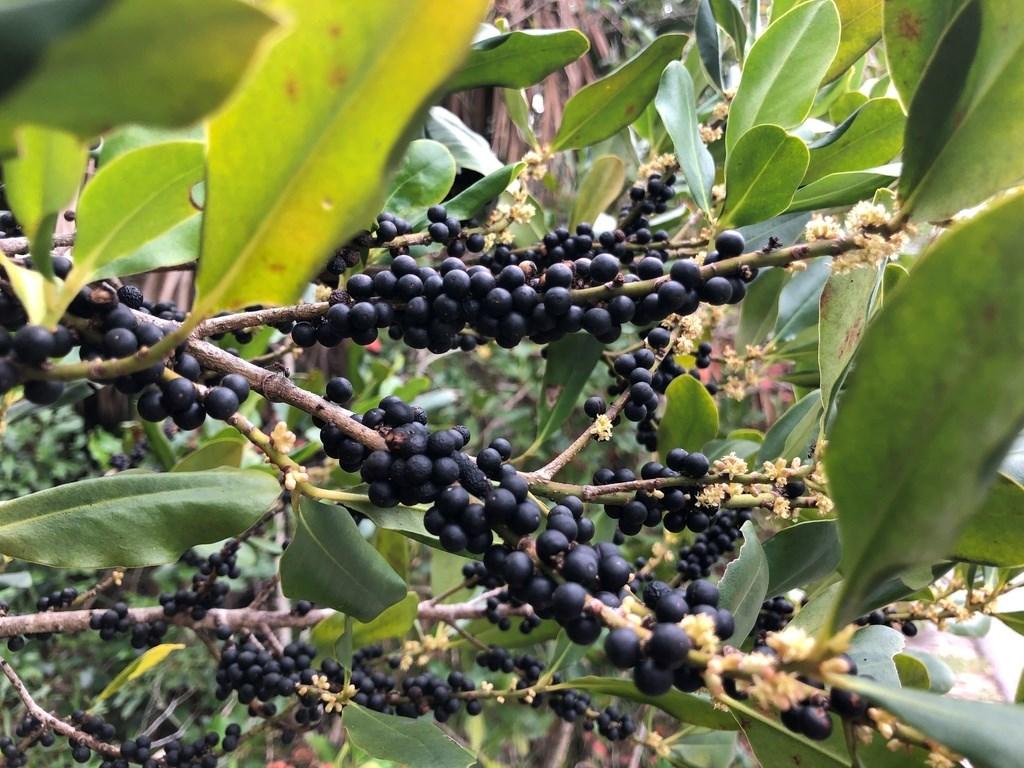
Small to Medium Trees
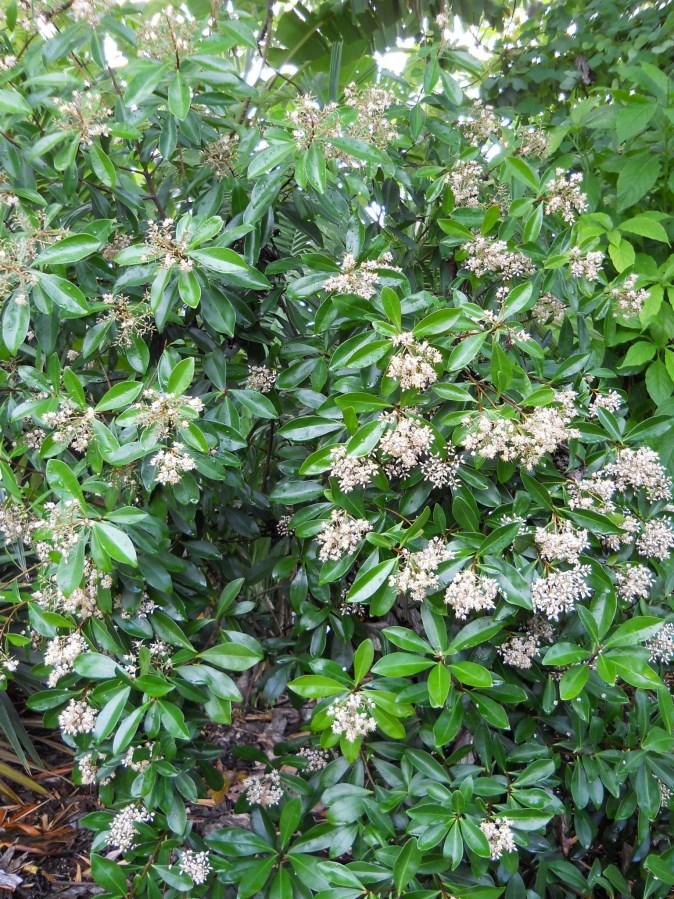
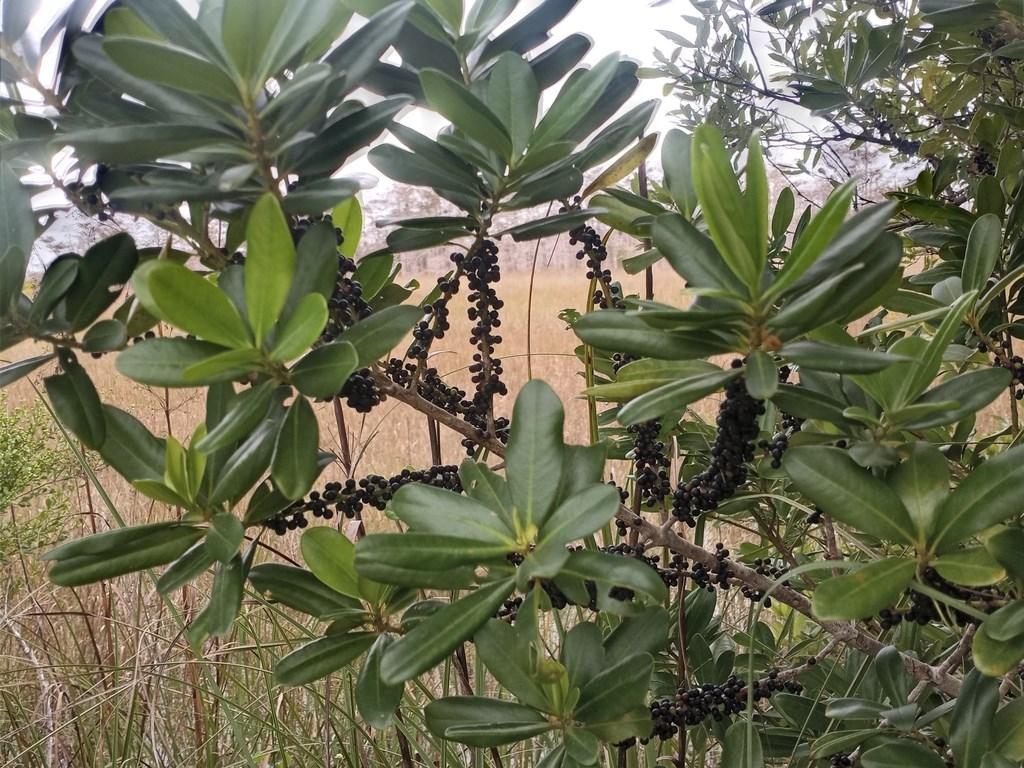
A small tree or shrub exhibiting an erect growth habit, akin to the marlberry (mentioned above), yet distinct in its floral presentation. Myrsine features inconspicuous flowers emerging sporadically along the stems, contrasting with the clustered flowers typically found at the end of the stem in the marlberry. Commonly sighted in hammocks and pinelands, this plant thrives in environments ranging from full sun to light shade. Fun fact: As with marlberry, it is reported that the Miccosukee Indians added the leaves to their smoking tobacco.
18
(c) Wayne Longbottom – (CC BY-NC)
Credit: Richard Lyons Nursery (c) Mark Kenderdine – (CC BY-NC)
© madisonbennett01, (CC-BY-NC)
Status Native Salt Water Tolerance Low Salt Wind Tolerance Mod/High Showy Flowers/ Fruits Semi-showy
Status
Salt
Understory
(c) Susan J. Hewitt – (CC BY-NC)
Threatened
Water Tolerance Low Salt Wind Tolerance Mod/High Swale Suitable
Understory Species
Myrtle-of-the-River (Myrcia zuzygium)
An uncommon shrub or small tree, reaching heights up to 16 feet and characterized by its wide-spreading crown. Its petite, fragrant flowers lack petals but feature numerous stamens, displaying a semi-showy appearance when blooming in inflorescences. The plant's new growth emerges in hues of pink to light red, adding a vibrant touch to its appearance. Prefers light shade to full sun.
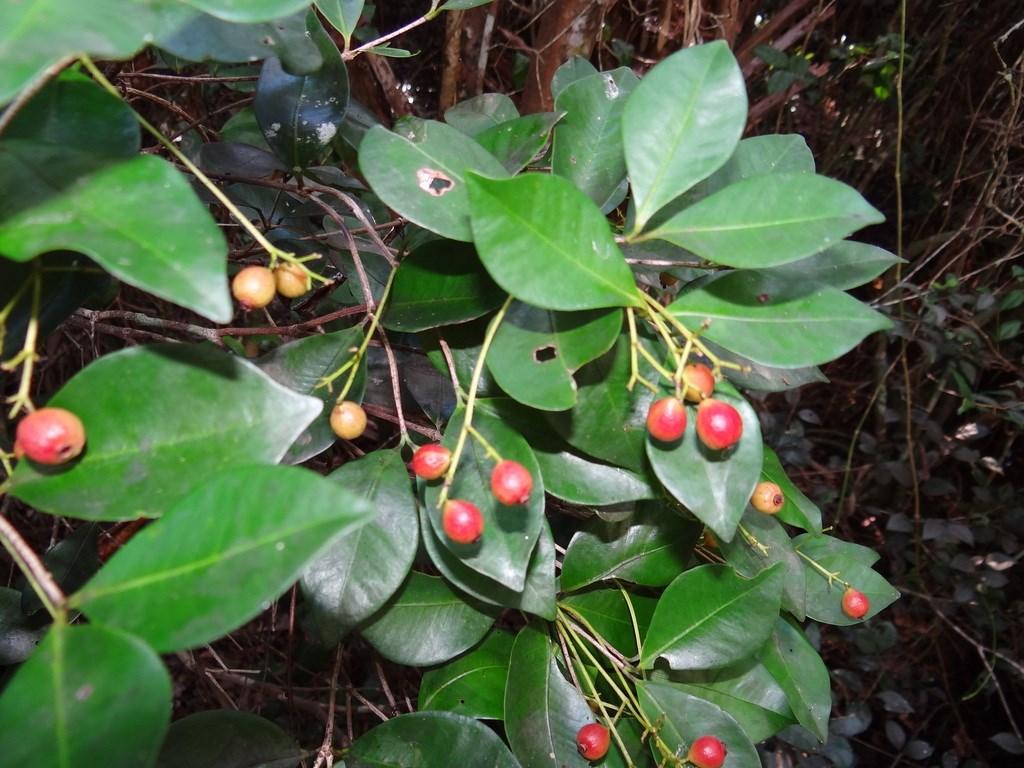
Fun Fact: This species can be cultivated from depulped, scarified seeds. It's crucial to plant them immediately, as these seeds don't retain viability for an extended period. Expect germination within approximately a month. To encourage a single leading stem, early pruning is recommended due to the plant's tendency to produce multiple stems.
Small to Medium Trees

Rhacoma - aka Maidenberry (Crossopetalum rhacoma)
An underutilized small ornamental tree or shrub, generally to 8 feet in height. The species has elegant drooping branches (when mature) with petite, delicate leaves and vibrant red fruits on long stems. Flowers are relatively inconspicuous. This tree makes a nice specimen or accent plant. Rhacoma prefers full sun to light shade, grows in rockland hammocks and pine rocklands and can be found in the Upper and Lower Keys.
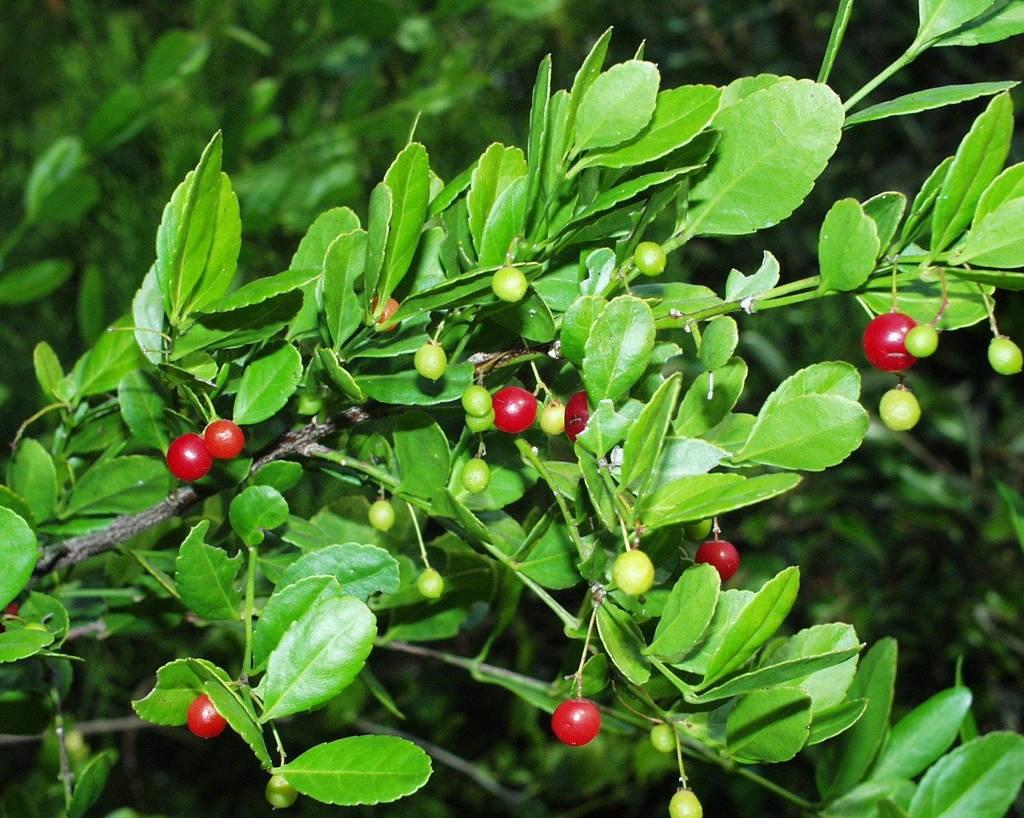
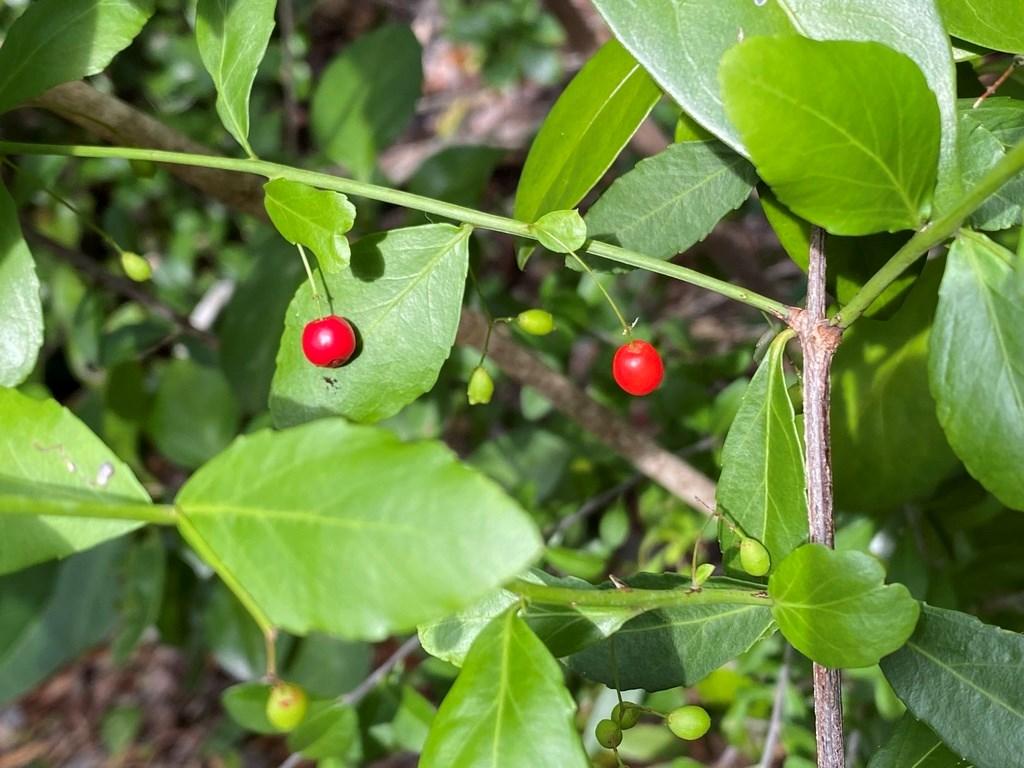
19
Status Threatened Salt Water Tolerance Low Salt Wind Tolerance Low
(c) Bruce Holst – (CC BY-NC)
(c) David Jeffrey Ringer – (CC BY-NC)
Status
Salt
Salt
(c) Tim – (CC BY)
Endangered
Water Tolerance Low
Wind Tolerance Moderate
Understory
(c) Bruce Holst – (CC BY-NC)
Understory Species Small to Medium Trees
Seven-Year Apple (Genipa clusiifolia)
A small tree or shrub to 15 feet tall with a rounded crown. Leaves are large, glossy, leathery and clustered toward the end of stems. The species grows in coastal thickets and likes welldrained, sandy limestone soils. White starshaped flowers produce egg-shaped fruit which ripens from green to yellow to black. Typically grows 5 to 15 feet and prefers full sun to light shade. The plant is a nectar plant for mangrove skipper butterfly. And the fruit is enjoyed by birds and mammals.

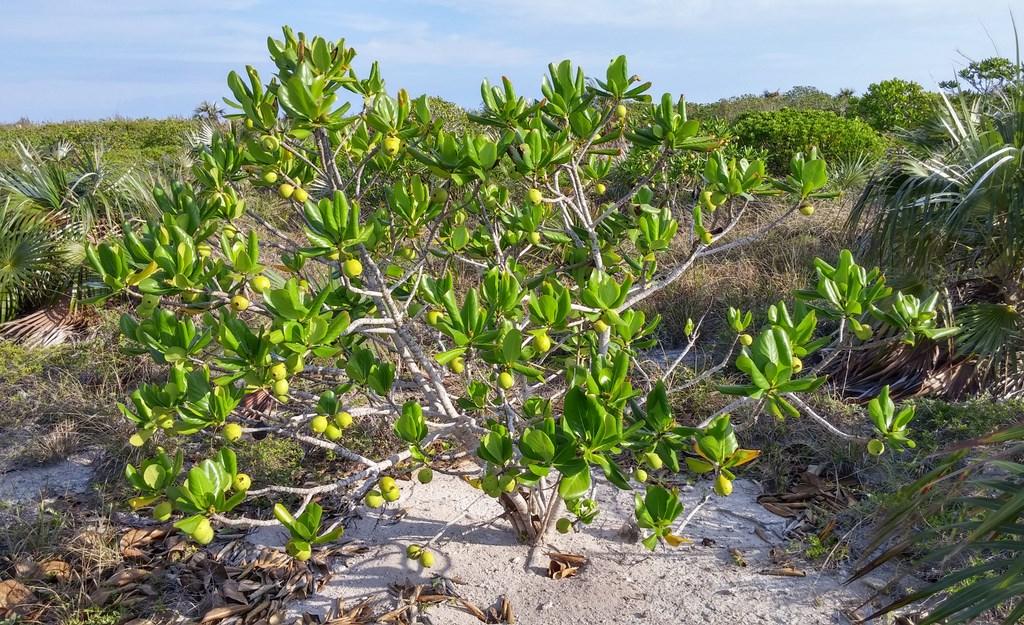
Salt Wind Tolerance Moderate Butterfly Plant Nectar

Salt Water Tolerance Low Understory
Soldierwood (Colubrina elliptica)
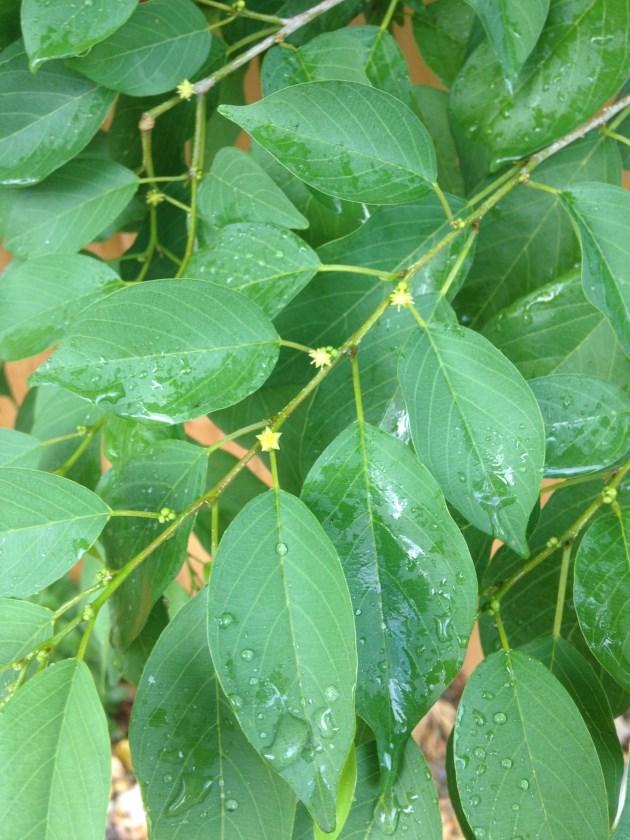
A medium-sized shrub to a small tree, reaching heights up to 20 feet. The standout feature of this species lies in its distinct dark orange-brown flaky bark, which steals the spotlight in appearance. Exhibiting a moderate to fast growth rate, its light green, softly hairy leaves create a striking contrast amid other species within hammock environments. While its greenish-yellow flowers may be inconspicuous along the stem, this plant's preference for full sun to light shade characterizes its habitat, limited to the Upper Keys. Fun Fact: As the sun heats the dries the fruits, they explode open with a popping sound that resembles musket fire, hence, the common name Soldierwood.
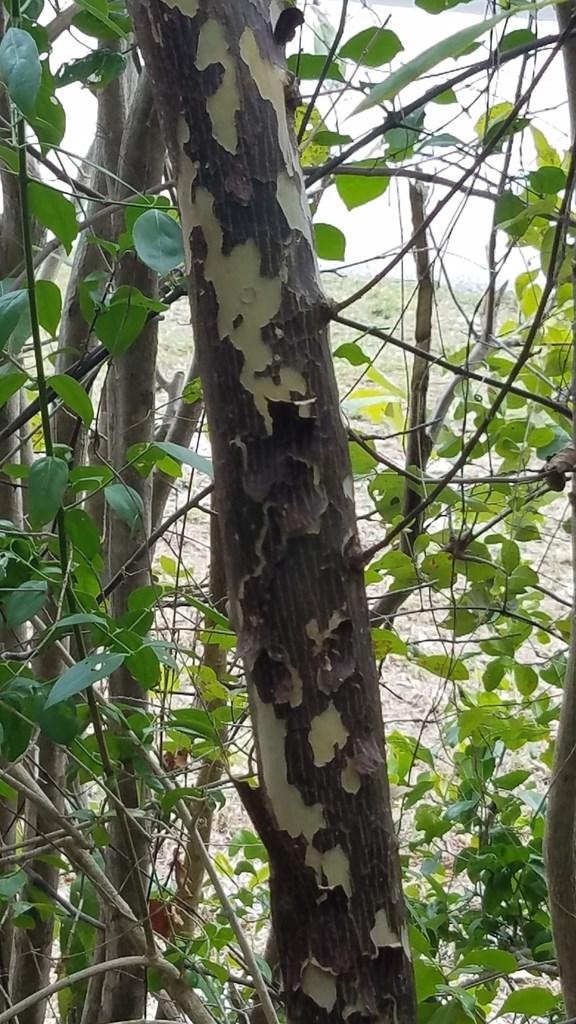
20
(c) Joshua Sands – (CC BY-NC)
(c) Alan R. Franck – (CC BY-NC)
Status Native Salt Water Tolerance Low Salt Wind Tolerance Low
(c) Kristof Zyskowski – (CC BY) (c) Pj – (CC BY-NC)
Status Regionally Important
Understory Species
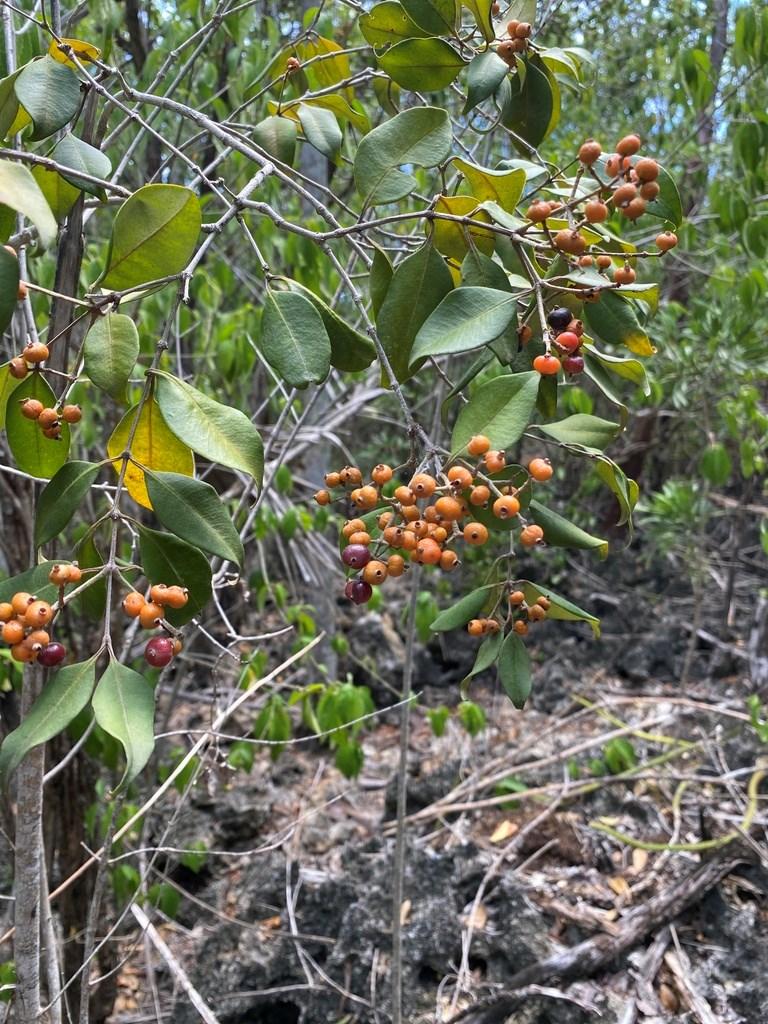
Myrcia neopallens)
Small to Medium Trees
sized shrub with dark green leaves, white multi-stamen flowers and colorful fruits. Fruits have a crown and mature from green to orange to red to purple. Prefers light shade

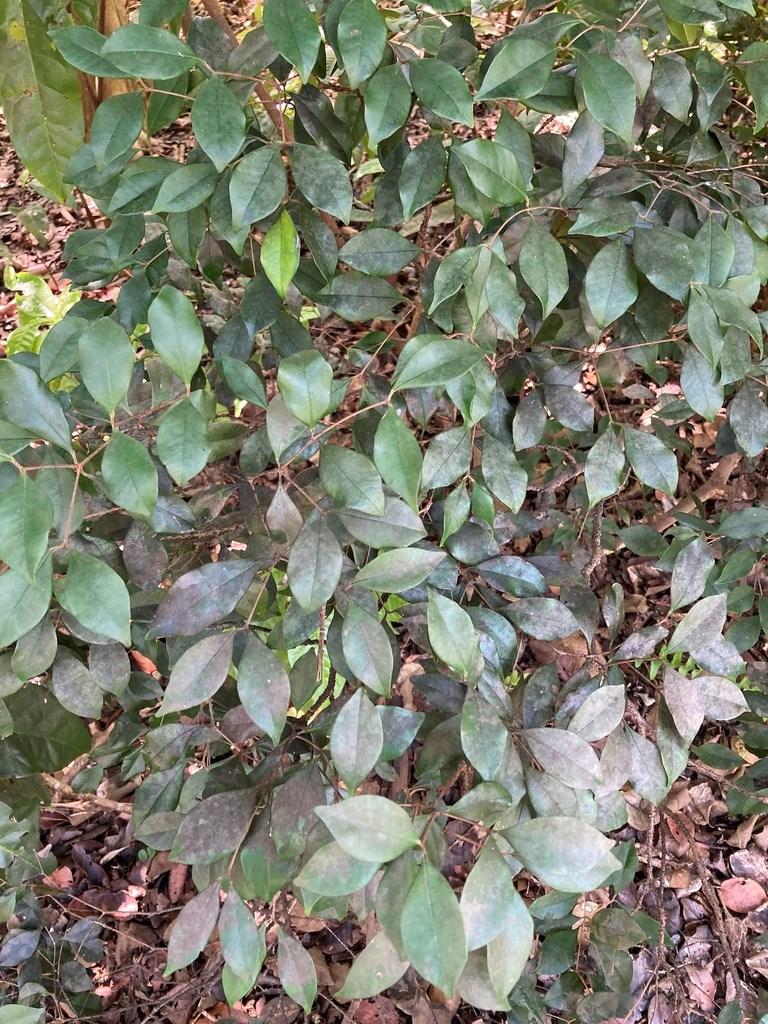
Tolerance
Salt Wind Tolerance Moderate Screening Suitable
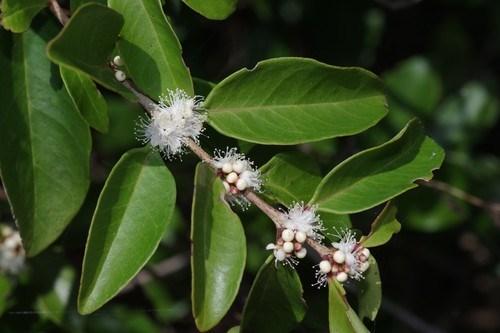
in the Keys (red, redberry, white and Spanish). Red stopper is often a shrub, while the other three often obtain understory height. All can be small trees or shrubs and may attain a height of 18 feet or more. They generally have a columnar growth pattern with a slender trunk when grown as a tree making them suitable for narrow spaces. Redberry stopper and red stopper are listed as endangered while white stopper and Spanish stopper are otherwise protected in the Keys. Redberry and red have low salt water and wind tolerance, while white has low to moderate tolerance. Spanish also has a low to moderate salt water tolerance but higher salt wind tolerance (mod/high).

Credit: TopTropicals.com Status Endangered/ Protected
Salt Water Tolerance Salt Wind Tolerance Screening Spanish stopper
21
White Stopper
(c) Peter and Kim Connolly – (CC BY-NC)
Spanish Stopper
By Jade Fortnash – (CC0)
(c) Alan R. Franck – (CC BY-NC)
Understory
(c) fredjburton – (CC BY-NC)
Understory Species
Strongback species (Bourreria sp.)
The Keys are home to three strongback (aka strongbark) species. All three are shrubby understory species with gracefully drooping limbs. Small white flowers produce fruits that ripen from green to yellow to orange to red.
The main differences between the species is the leaf size and texture, with B. succulenta have larger, smooth leaves, B. radula having slightly smaller, densely hairy leaves and B. cassinifolia having much smaller, slightly hairy leaves. The plants prefer full sun to light shade. Species are nectar plants for several butterflies.

(c) queenbruiser
Torchwood (Amyris elemifera)
A shrub or small tree to 16 feet. The species has a drooping compound leaf, typically with three leaflets and an elongated drip tip. Species has small white flowers with fruits that ripen to dark purple. Leaves are aromatic when crushed. Plant prefers full sun to light shade. Larval host plant for giant swallowtail, Schaus' swallowtail and other butterflies.
Fun Fact: The resinous wood is highly flammable and has been used for fuel and torches.
Small to Medium Trees
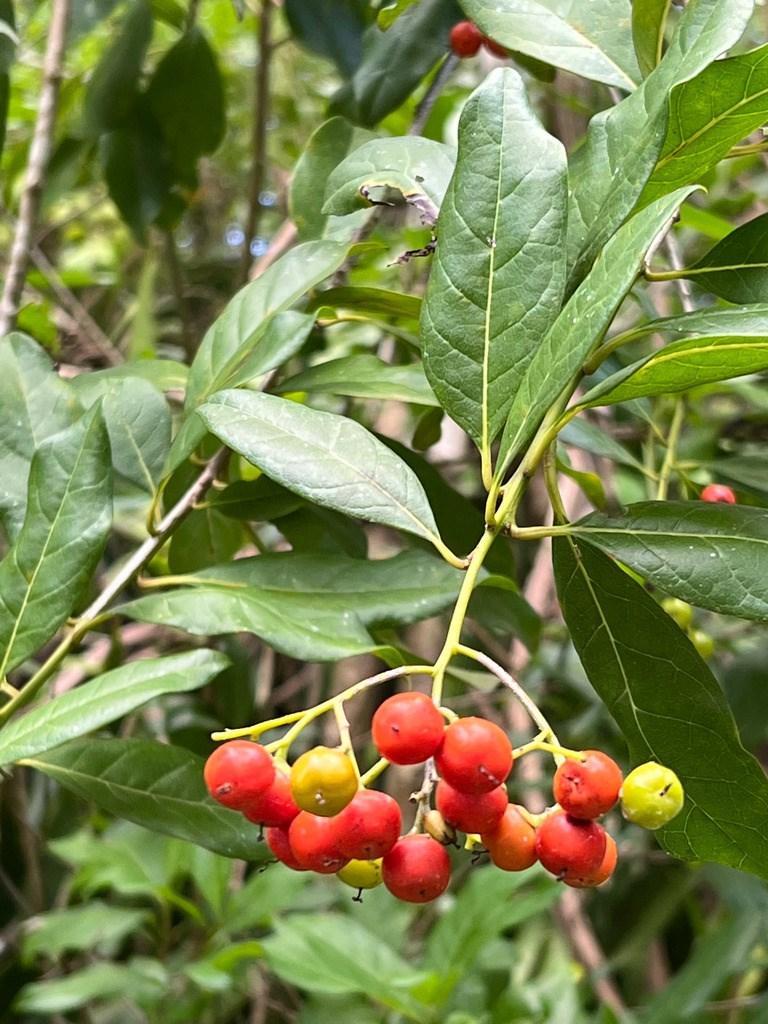

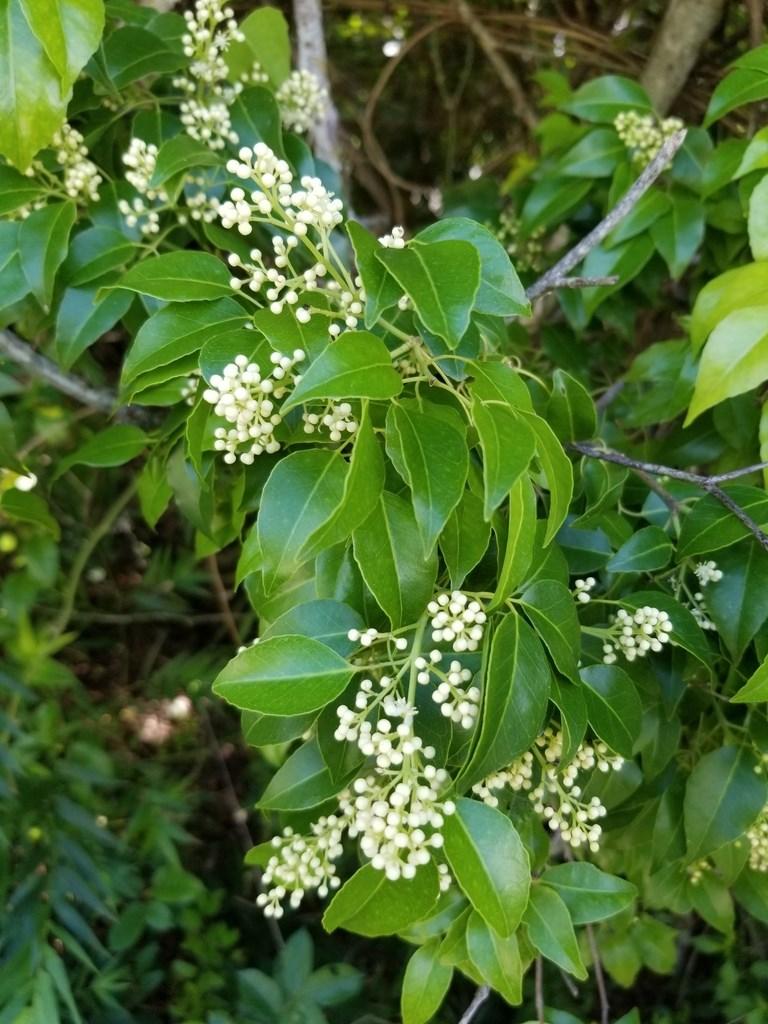
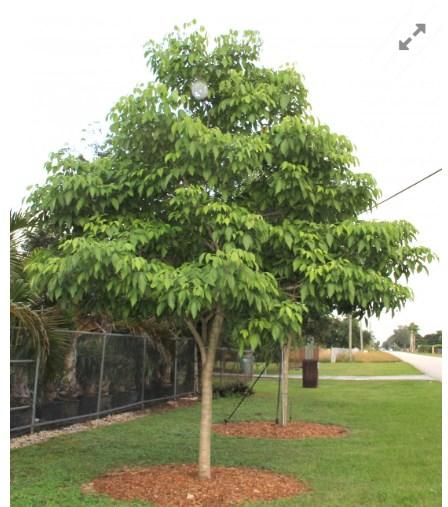
22
Credit: TreeWorld
(c) Chanell – (CC BY-NC)
Status Regionally Important Salt Water Tolerance Low Salt Wind Tolerance Moderate Butterfly Plant Host
Understory
(c) Serguei Ponomarenko –(CC BY-NC)
Status Endangered Salt Water Tolerance Low Salt Wind Tolerance Moderate Butterfly Plant Nectar
Understory Species
Velvetseed, Everglades (
Small to Medium Trees
A small tree to 15 feet found in hammocks and pine rocklands. The species has light-green, flexible, hairy leaves and small creamy colored flowers. The fruit ripens from green to red to purple. The bark is smooth and sometimes peeling and mottled. The species prefers full sun to light shade.
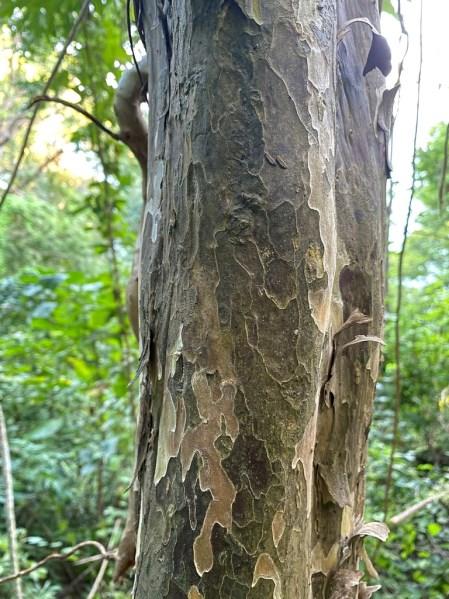
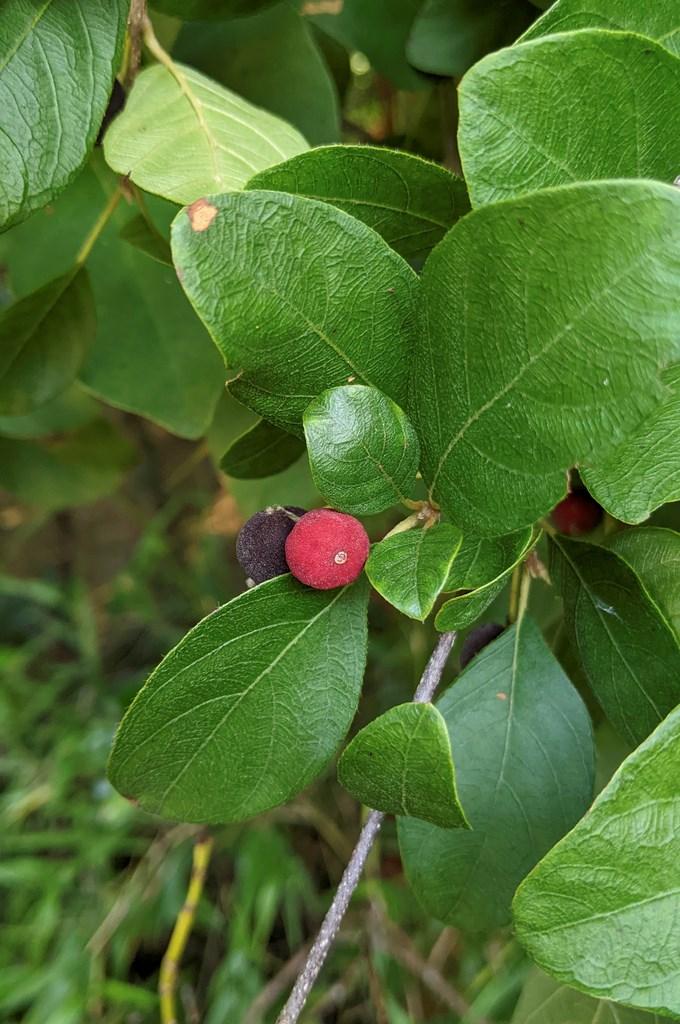

Velvetseed, Rough (Guettarda scabra)
A small erect tree up to 15 feet tall with stiff, rough, dark green leaves. White to pinkish tubular flowers produce velvety, bright red fruits which contrast nicely with the dark green leaves. Species is found in pinelands and hammocks and prefers full sun.
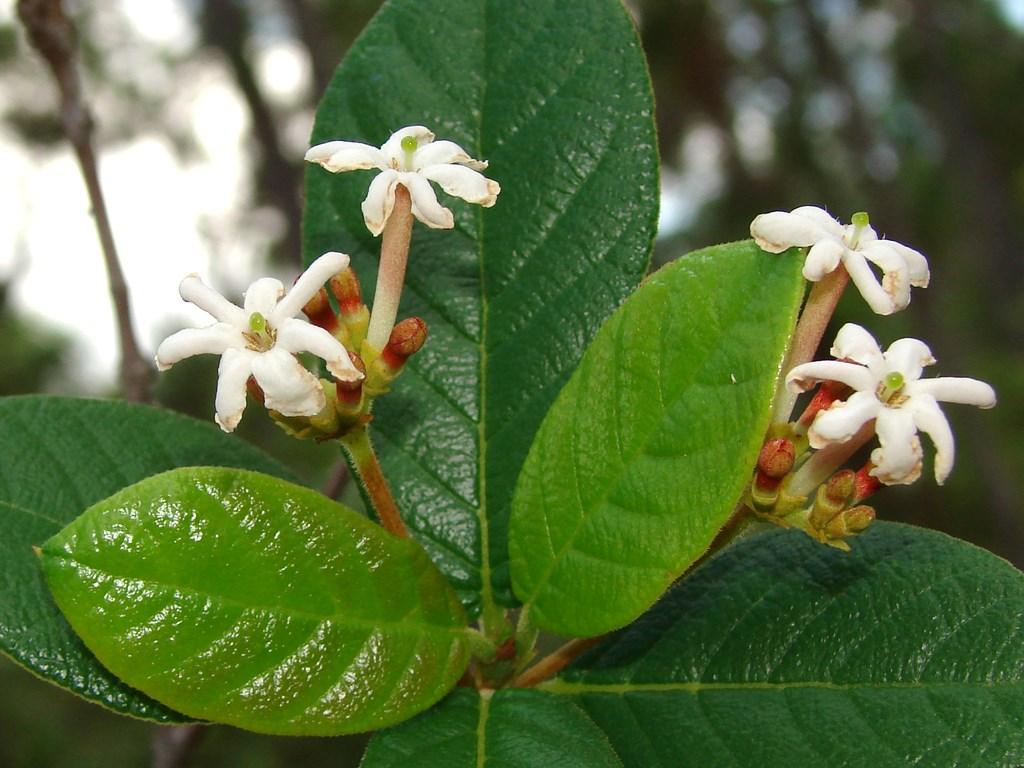
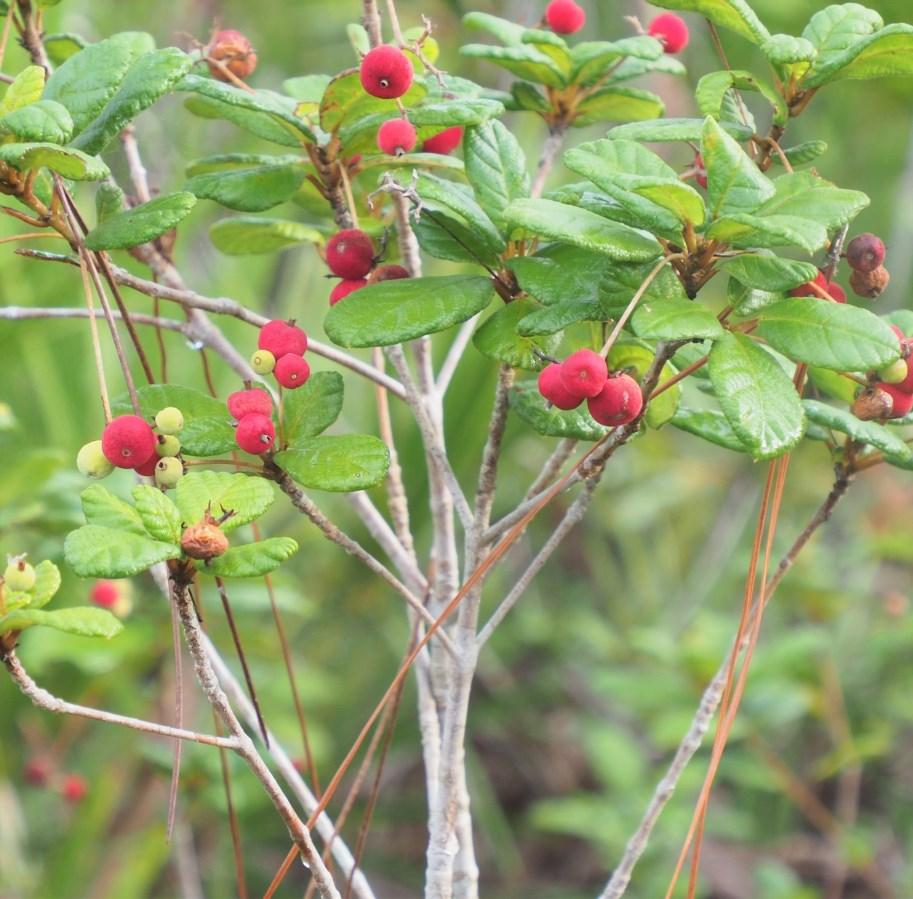
23
Status
Salt Water
Salt
Regionally Important
Tolerance Low
Wind Tolerance Low Swale Suitable ©
Ryan Fessenden, (CC-BY-NC)
Status
Salt Water Tolerance
Salt Wind Tolerance Mod/High Showy
Fruits
showy
© Guillermo Joaquin Martinez Mendoza, (CCBY-NC)
Native
Low
Flowers/
Semi-
(c) David Hochadel – (CC BY-NC) (c) Ryan Fessenden – (CC BY-NC)
Understory
Understory Species
Wax Myrtle (Myrica cerifera)
A shrub or small tree showcasing a slender crown adaptable for use as a shrub or as an accent tree when pruned. Its narrow, toothed leaves complement its appearance. Sporting round bluish-grey fruits coated with a waxy layer, this tree thrives in full sun or light shade. It serves as a crucial larval host plant for redbanded hairstreak butterflies. Fun Fact: The wax of the fruits is extracted to produce bayberry candles.
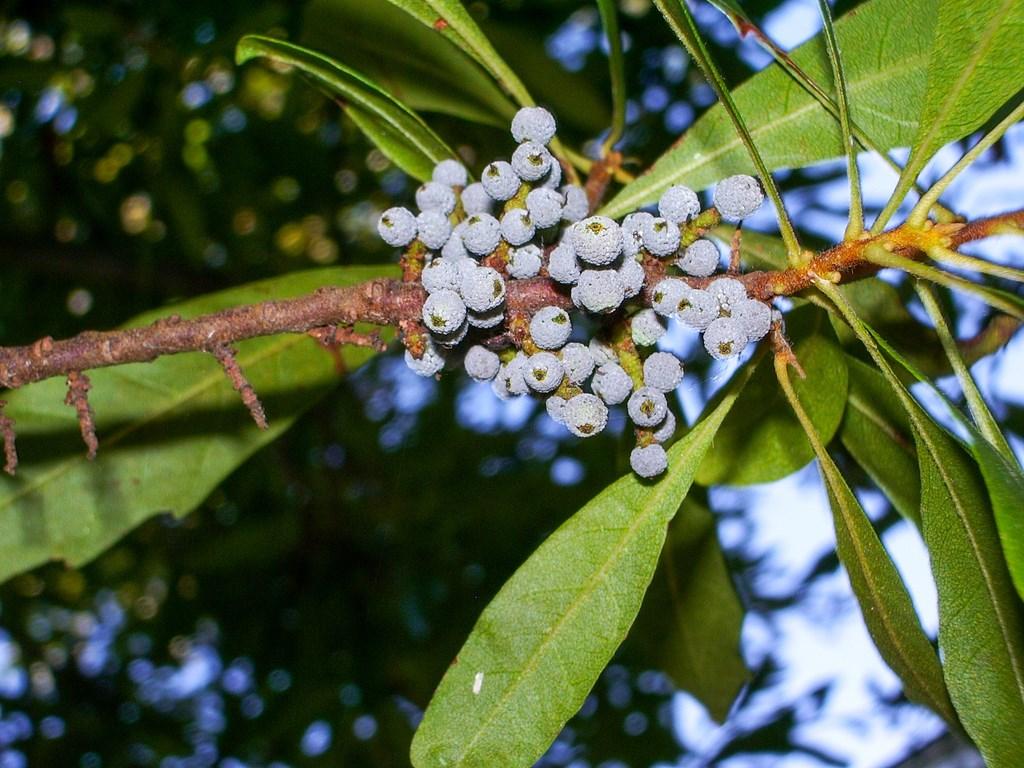
Small to Medium Trees


White Ironwood (Hypelate trifoliata)
A rare shrub or small tree typically 18 feet but sometimes to 30 feet. Trifoliate compound tear-drop shaped leaflets give the specimen a delicate appearance. The attractive tree is underutilized in landscapes. Small white flowers produce black oval fruits. Found in hammocks, the tree prefers full sun to light shade.

Credit:

24
(c) David Jeffrey Ringer – (CC BY-NC)
Homer Edward Price Status Endangered Salt Water Tolerance Low Salt Wind Tolerance Moderate
© Kathy Richardson – (CC BY-NC)
Understory
© grinnin – (CC BY-NC) Status Native Salt Water Tolerance Low Salt Wind Tolerance Moderate Swale Suitable Butterfly Plant Host Screening Suitable
© Maggie (CC BY-NC 2.0 DEED)
Understory Species
Wild Dilly (Manilkara jaimiqui subsp. emarginata)
Small to Medium Trees
A unique shrub or small tree, commonly reaching heights up to 15 feet. It features stiff, pale, dusty -green oblong leaves clustered towards the ends of its branches. Clusters of small yellow flowers similarly gather at the tips of the stems, later giving way to substantial round or slightly flattened fruits with a rough skin texture. Thriving in full sun, this species thrives in coastal hammocks and pine rocklands.


IMPORTANT: this species may be confused with the invasive exotic Manilkara sapodilla. Please be sure to purchase from a reputable native nursery.
Wild Lime (Zanthoxylum fagara)
A shrub or small tree reaching heights of 20 feet, with unique compound leaves distinguished by a winged midrib. Despite its thorny stems, this tree remains a favorite among butterfly enthusiasts. Its small, inconspicuous yellow flowers do little to detract from its allure. Upon ripening, the orangebrown fruits open to reveal glossy black seeds. This species plant thrives in full sun and serves as a crucial larval host for giant swallowtail butterflies.
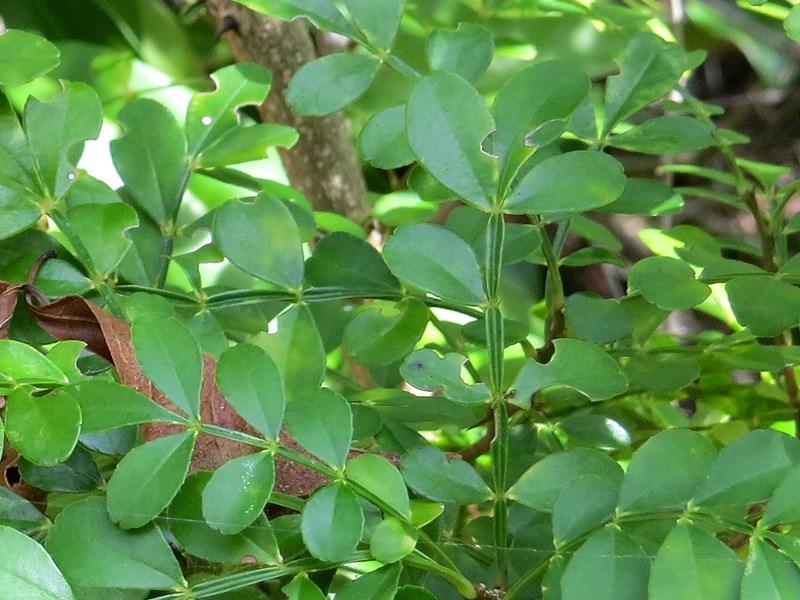
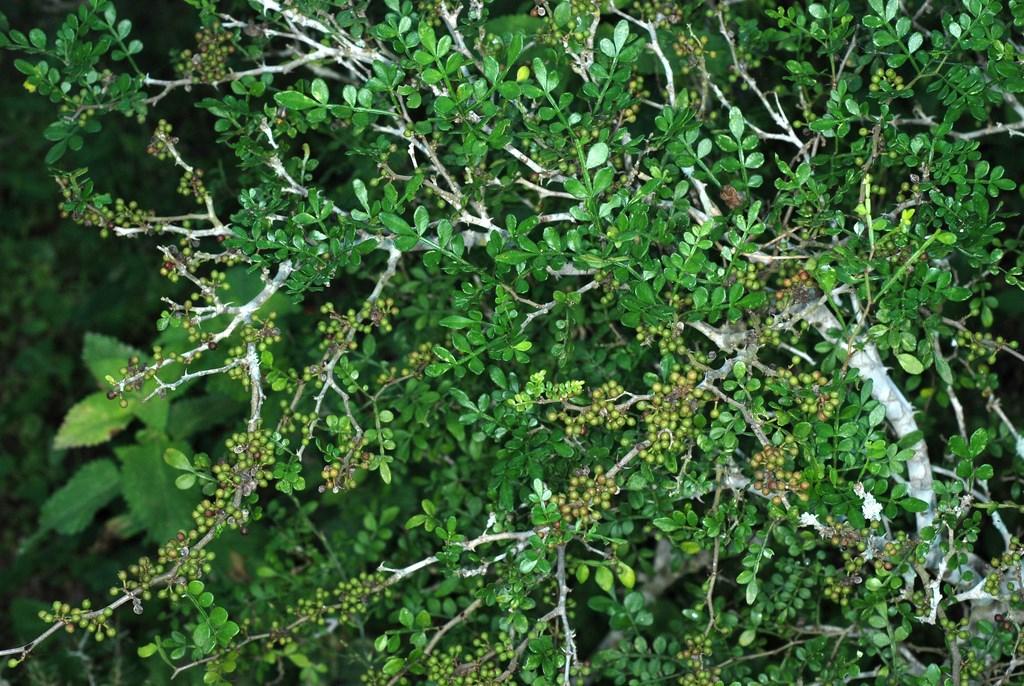
Status Regionally Important
Salt Water Tolerance Low
Salt Wind Tolerance Moderate Screening Suitable Butterfly Plant Host/Nectar
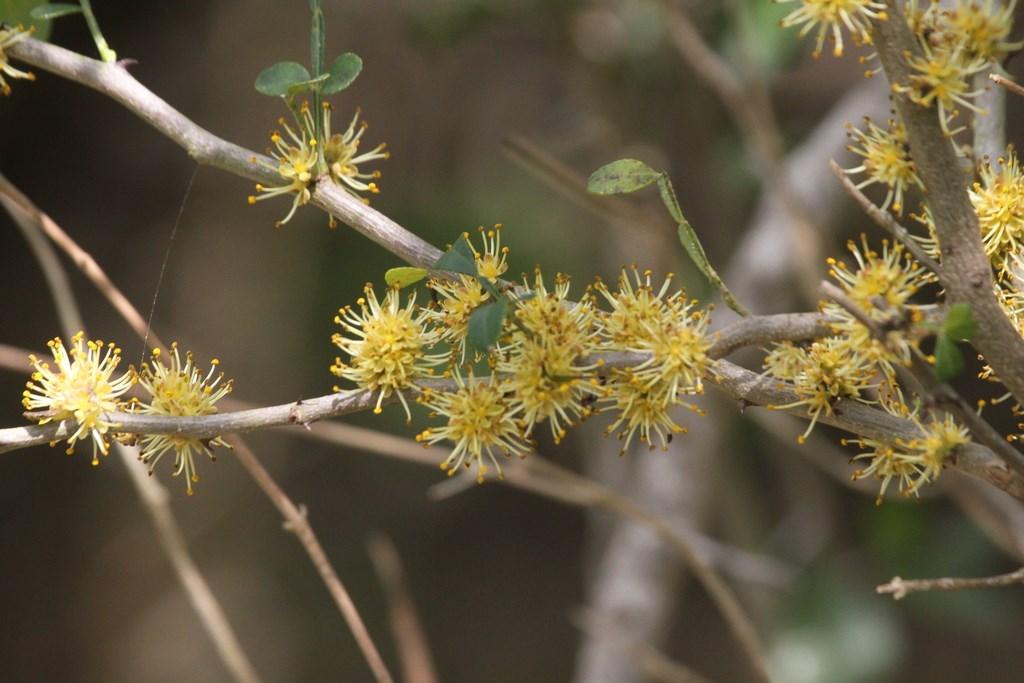
25
(c) Douglas Goldman
Credit: Janice Broda
(c) chobuck – (CC BY-NC)
(c) Ryan Fessenden – (CC BY-NC)
Credit: cotinis
Status Threatened Salt Water Tolerance Moderate Salt Wind Tolerance Low Understory
Shrub Species
Bahama Senna (Senna mexicana var. chapmanii)
A small shrub, generally to 4’ in height, often spreading wider. Its vibrant, butterfly-shaped bright yellow flowers stand out prominently, creating a captivating contrast against the green compound leaves. This species not only attracts pollinators but also serves as a larval host plant for several butterfly species including the cloudless sulphur, sleepy orange and orange-barred sulphur butterfly.

Generally Less Than 10’ Tall
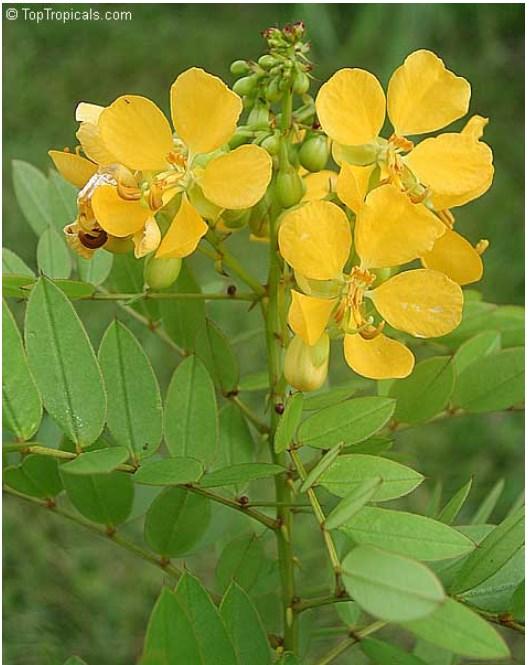
Fun Fact: Glands situated at the leaf base serve to attract ants, which subsequently defend the plant by attacking caterpillars. This interaction effectively minimizes herbivory, leading to a notable increase in fruit and seed production.
Bay Cedar (Suriana maritima)
A coastal species, usually standing under 6 feet in height, though occasionally reaching up to 10 feet. This plant is often underutilized but can be pruned to form an appealing hedge. Its small, soft, paddle-shaped leaves cluster toward the branch ends. While the yellow flowers are small, their abundance adds to their visual presence. Thriving in full sun, this species serves as a host plant for the martial scrub-hairstreak and the mallow scrub-hairstreak butterflies.
Fun Fact: Can be grown from seed.


26
© Timothy Johnson, (CC-BY-NC)
Status Threatened Salt Water Tolerance Low Salt Wind Tolerance Low Screening Suitable Showy Flowers/ Fruits Showy Butterfly Plant Host
Credit: Doug Ingram & Sons Nursery
Shrub
© David Jeffrey Ringer, (CC-BY-NC)
Status Regionally Important Salt Water Tolerance Moderate Salt Wind Tolerance High Swale Suitable Butterfly Plant Host
Shrub
Shrub Species
Beautyberry (Callicarpa americana)
Generally Less Than 10’ Tall
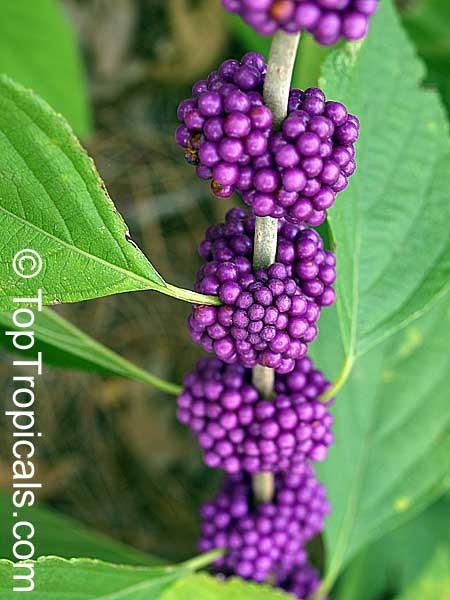

© jmcpeak111, (CC
A common landscape shrub known for its clusters of small pink flowers and striking purple (sometimes white) fruits. The species is generally 4-6 feet tall, with long, sprawling limbs, and rough textured, light green, toothed leaves. Beautyberry flowers all year and is a nectar plant for butterflies. The species prefers full sun to light shade and is primarily found in the Upper Keys.
Status Native Salt Water Tolerance Low
Salt Wind Tolerance Moderate
Blacktorch (Erithalis fruticosa)
This shrub serves as a nectar source for the endangered Miami blue butterfly. Typically reaching heights of 8 feet, it's commonly observed at around 6 feet tall. The dark green, glossy leaves contribute to the plant's lush tropical appearance. Its petite white starshaped flowers yield shiny dark purple to black berries.
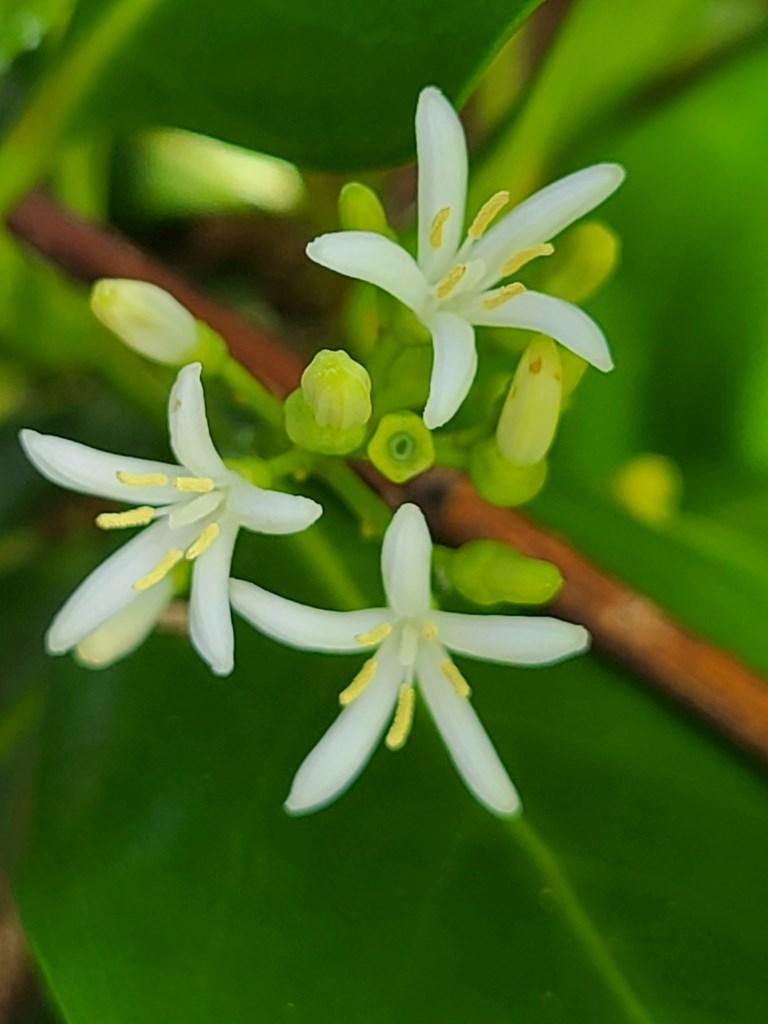
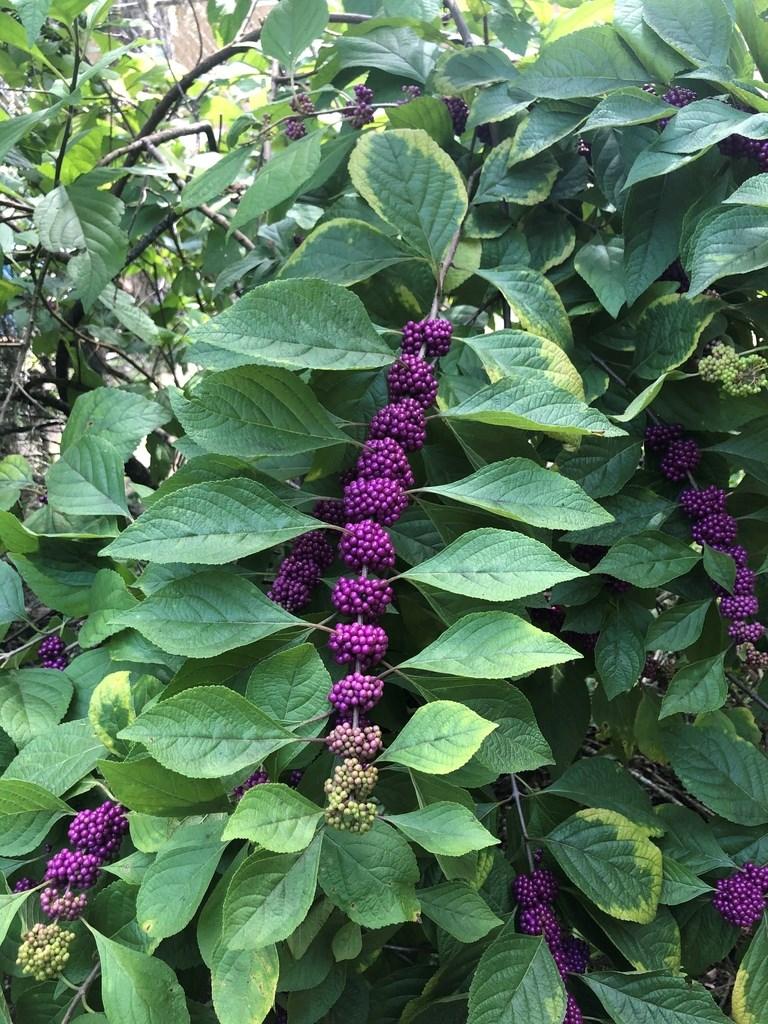
Showy Flowers/ Fruits Showy Butterfly Plant Nectar
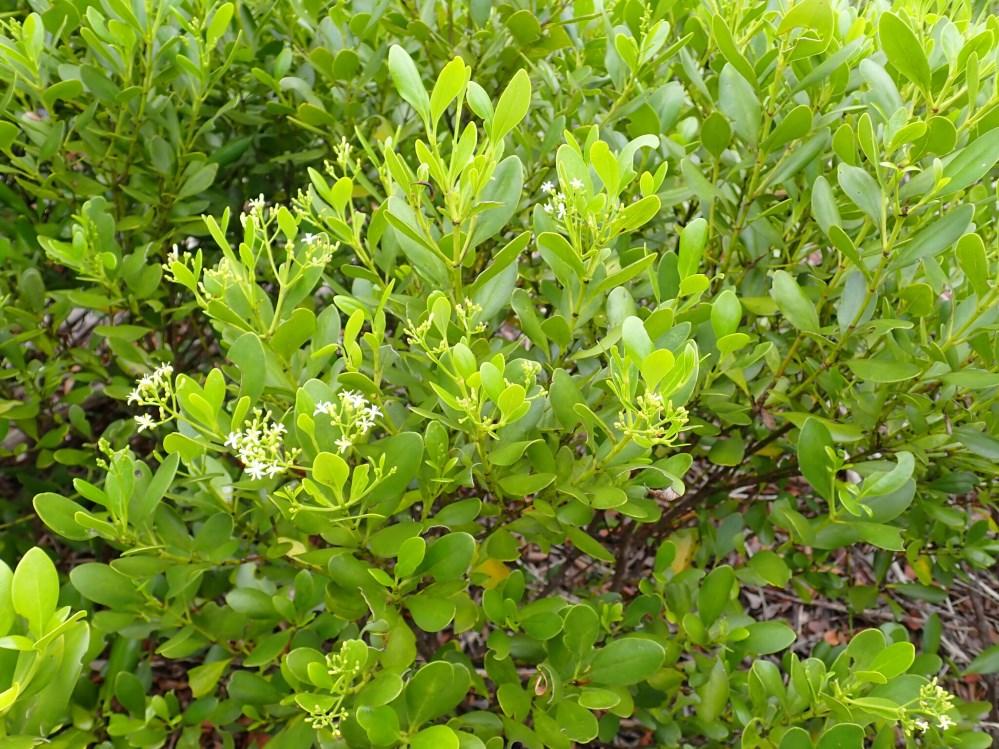

27
-BY-NC)
© Kristin A. Bakkegard, (CC-BY-NC)
Status Threatened Salt Water Tolerance Moderate Salt Wind Tolerance High Screening Suitable Butterfly Plant Nectar © ritirene,
(CC-BY)
© fredjburton, (CC-BY-NC)
© Jessica Bickell, (CC-BY-NC)
Shrub Species
Coco-plum (Chrysobalanus icaco)
A common landscape plant growing to about 10 feet. The stiff leathery leaves are notched and may have red tips. Small white flowers produce relatively large darkpurple or white fruits to 1-inch in diameter. They are commonly hedged in landscapes and provide excellent screening. This plant provides nectar for butterflies while its fruits are a source of food for birds and mammals.
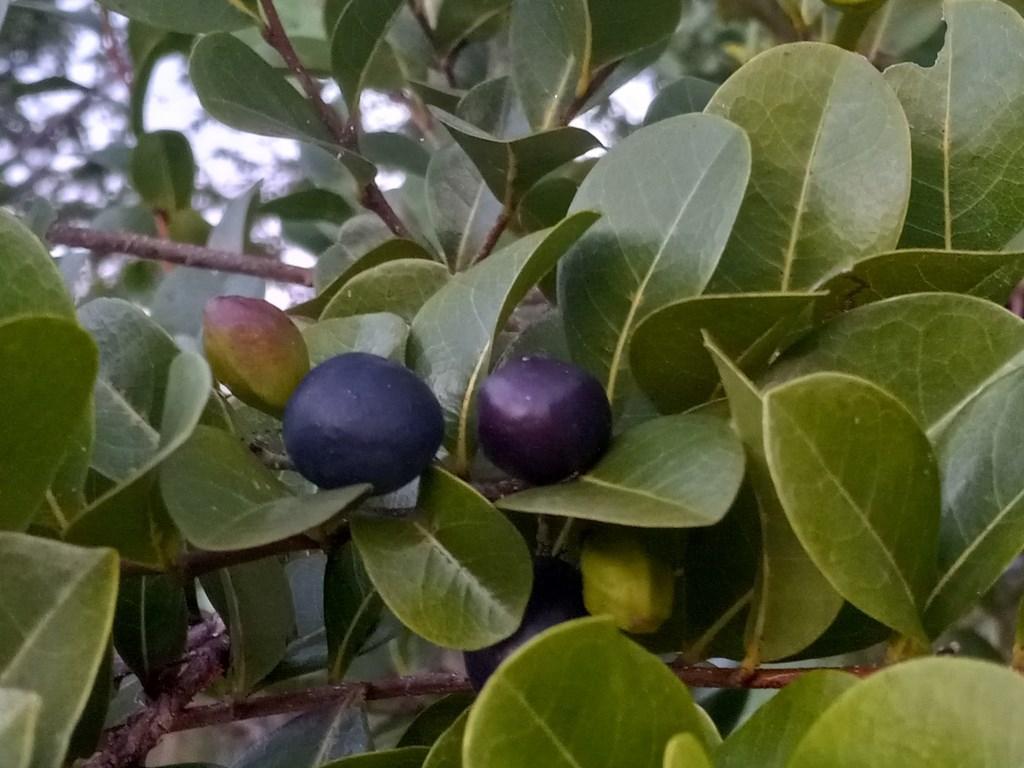
Coffee, Wild (Psychotria nervosa)
Generally Less Than 10’ Tall
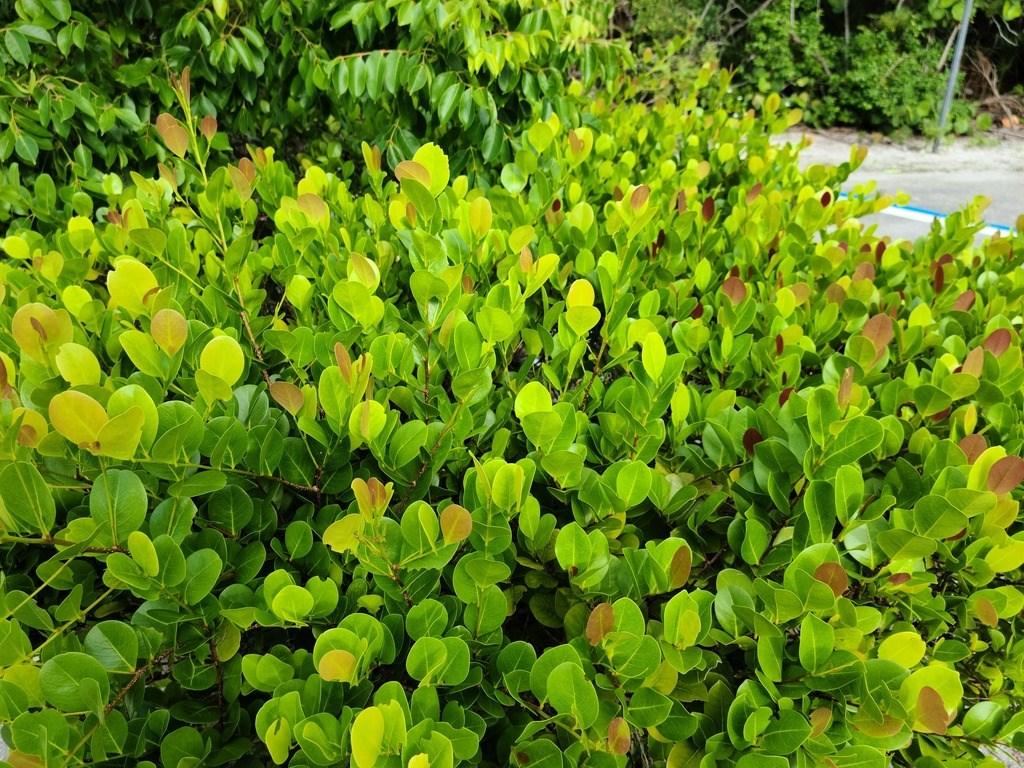
Coffee, Bahama Wild (Psychotria ligustrifolia
P. nervosa is the more prevalent of the two species, featuring shiny "quilted" leaves and white flowers clustered on short stalks. The endangered P. ligustrifolia tive "quilted" appearance, with its flowers situated on longer stalks. Both species flourish in light shade but can withstand full sun.
Pictures of



28
Monroe County
Environmental Resources
Bob Peterson (CC BY 2.0)
Monroe County Status Native/ Endangered Salt Water Tolerance Low Salt Wind Tolerance Moderate Swale Suitable Showy Flowers/ Fruits Semi-showy Screening Suitable Butterfly Plant Nectar
BY-NC)
© Martin Reith, (CC-BY-NC)
Status Native Salt Water Tolerance Low Salt Wind Tolerance Moderate Swale Suitable Screening Suitable Butterfly Plant Nectar Shrub
Shrub
Shrub Species
Coontie (Zamia integrifolia)
Generally Less Than 10’ Tall
This cycad makes an excellent specimen or accent shrub. This rugged plant has fern-like leaves that are quite stiff and an underground stem. Reaching heights to 4 feet, both male and female specimen produce a 3-6 inch cones. The female cones are broader and produce seeds with a fleshy, bright orange skin. Fun Facts: Native Americans utilized the starchy tuber, known as Florida arrowroot, however, it is poisonous if not properly treated. The only native cycad in the United States, and the only host plant for the rare Atala butterfly. The voracious larvae may significantly damage the plant but it will recover. After a 35 year absence the Atala returned to the Everglades in September, 2023.
IMPORTANT: This plant can be poisonous and even fatal to cats, dogs and other animals.
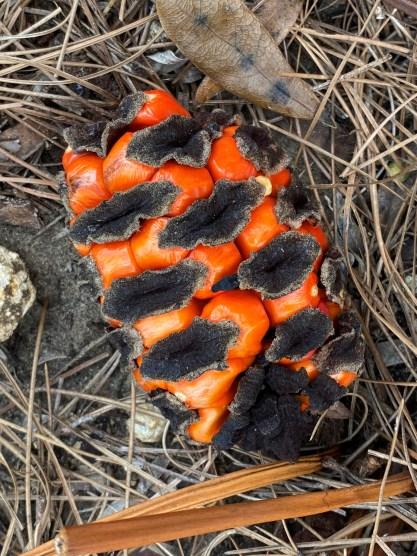
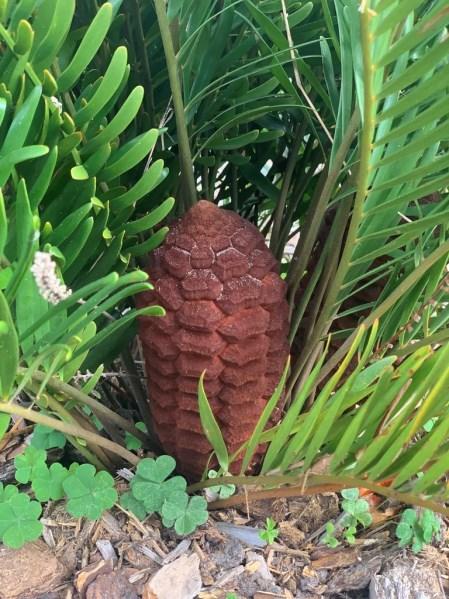
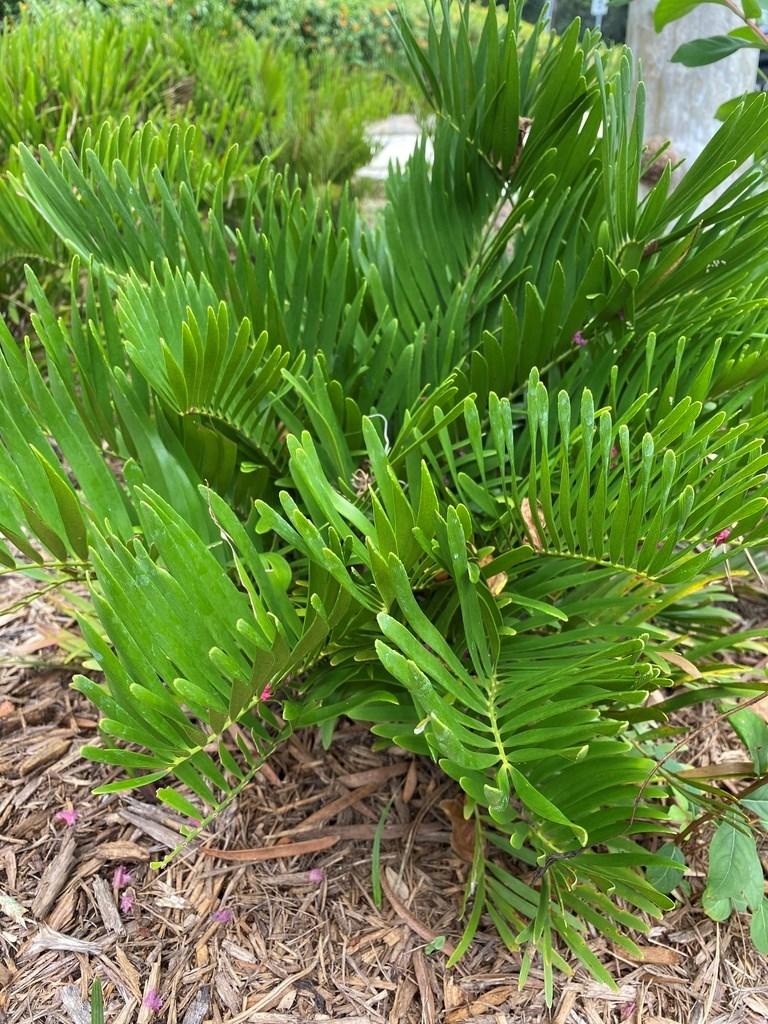
Firebush (Hamelia patens var. patens)
A colorful shrub and great wildlife attractant. The shrub grows about 10-12 feet in height. Light to medium-green, hairy leaves, often tinged red may reach 4 inches in length. Red to orange-red tubular clusters grow in terminal clusters. They are a favorite for butterflies and hummingbirds as well as a variety of other pollinators. The plant requires full sun.
IMPORTANT: This species is easily confused with Hamelia patens var. glabra. The non-native species has mostly hairless leaves and yellow-red flowers. Hybridization threatens the native species. Be sure you purchase from a reputable native plant nursery.


29
© tante, (CC-BY-NC)
© snigui01, (CC-BY-NC)
Status Native Salt Water Tolerance Low Salt Wind Tolerance Moderate Swale Suitable Screening Suitable Butterfly Plant Host/Nectar
© bmagill, (CC-BY-NC)
© Carmen Jimenez, (CC-BY-NC)
Status Native Salt Water Tolerance Low Salt Wind Tolerance Mod/High Butterfly Plant Nectar/Host
© Susan Berg, (CC-BY)
Shrub Species
Florida Boxwood (Schaefferia frutescens)
This endangered species can grow to a small tree, but is more frequently seen as a shrub to 10-12 feet tall. It has small dark green erect leaves and brown bark. Small green to white flowers emerge from the stems, producing orange to red fruit. This species prefers light shade. It can be used as a hedge or trained as a single trunk tree for more formal landscapes.
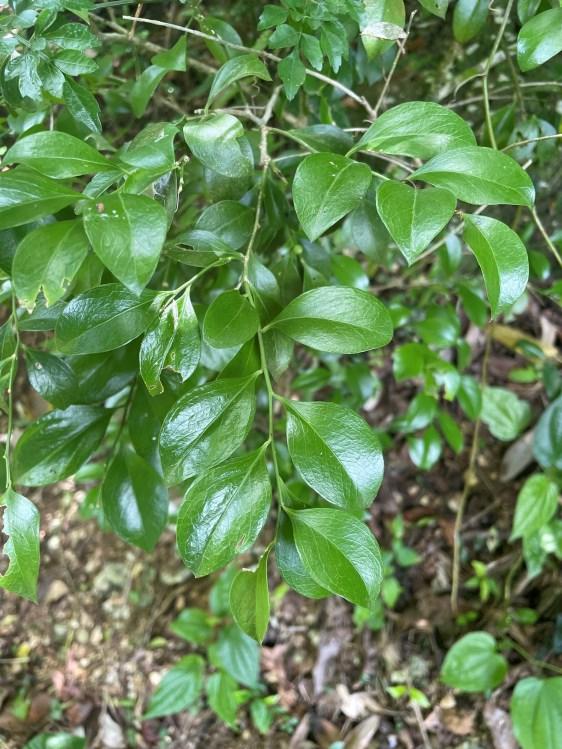

Florida Swampprivet (Forestiera segregata)
A semi-deciduous shrub with an irregular crown that can reach 15 feet or more in height. The bush has many small trunks, green leaves and clusters of small green to yellow to white flowers with striking stamens. The fruits are bluish to black, olive-like drupes. The species grows at a moderate to fast pace and prefers full sun.
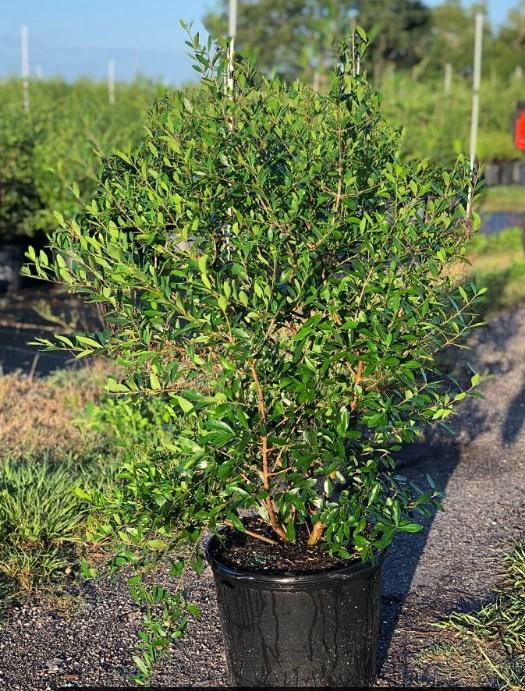
Credit:
Generally Less Than 10’ Tall

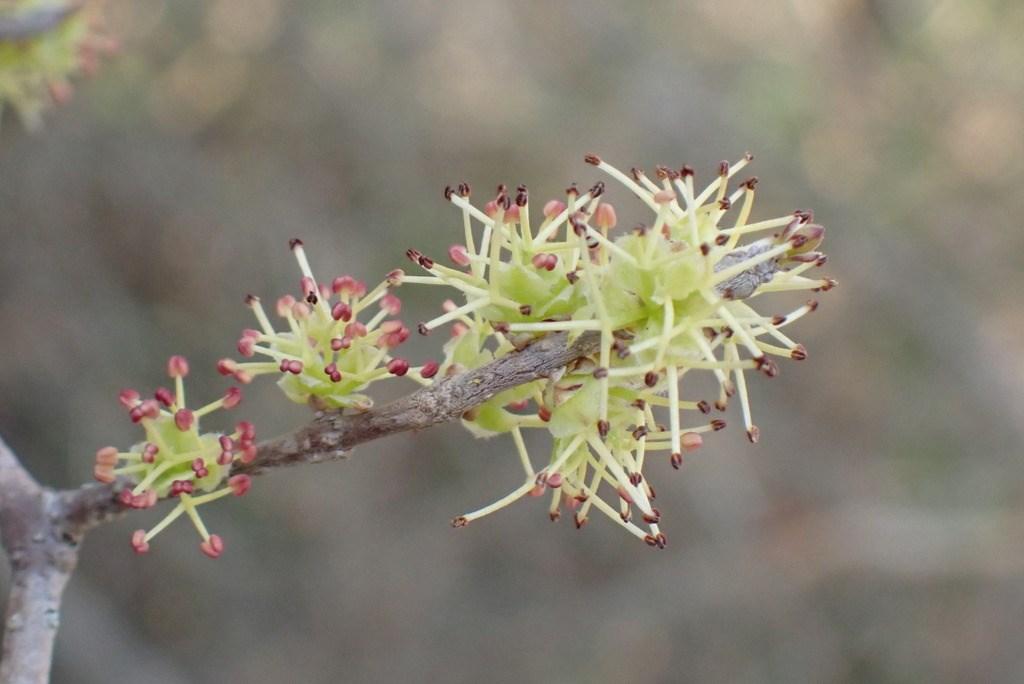
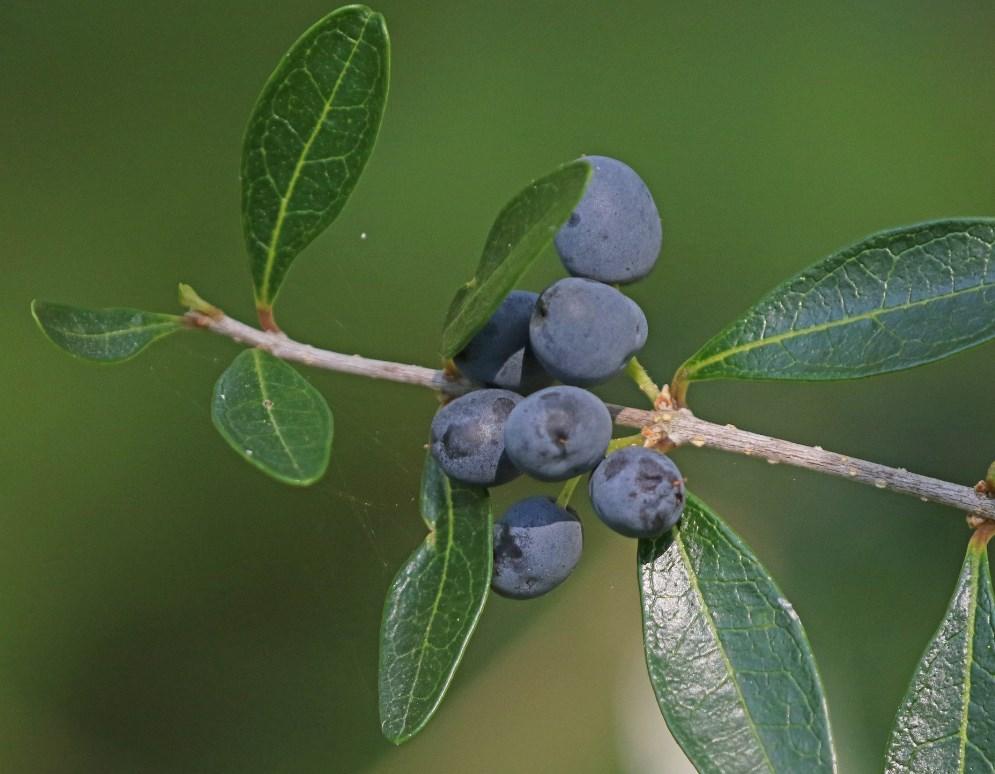
30
© R Snyder, (CC-BY-NC-SA) Status Regionally Important Salt Water Tolerance Low Salt Wind Tolerance Mod/High Screening Suitable
King’s Nursey
© Ali and Brice, (CC-BY-NC)
Credit: Botanics Wholesale, Inc.
© Steve Maldonado Silvestrini, (CC-BY-NC)
Status
Salt
Tolerance
Salt
Tolerance
© Martin Reith, (CC-BY-NC)
Endangered
Water
Low
Wind
Low Shrub
Shrub Species
Inkberry (Scaevola plumieri)
A mounding coastal shrub. The species has large (1-2”) glossy green succulent leaves. Leaves are located toward the end of long trailing branches that may re-root upon touching the ground. Small, fan-shaped flowers produce shiny black berries. The species does well in sandy dune areas and requires full sun.
IMPORTANT: This may be confused with the invasive exotic Scaevola taccada, which has white berries and can take over landscapes. Be sure you purchase the native species from a reputable nursery.
Generally Less Than 10’ Tall

Status Threatened
Shrub
Salt Water Tolerance Low
Salt Wind Tolerance High
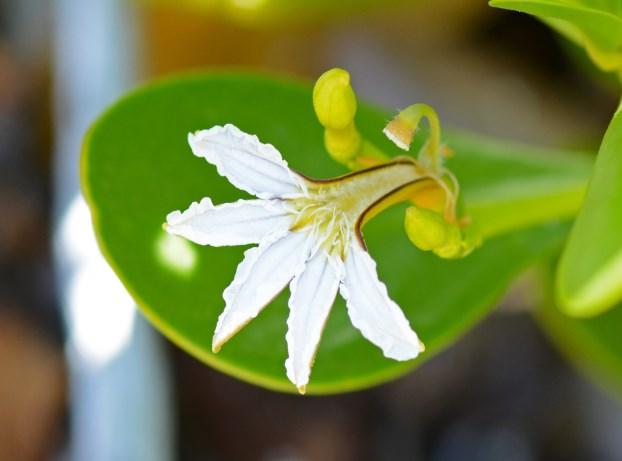
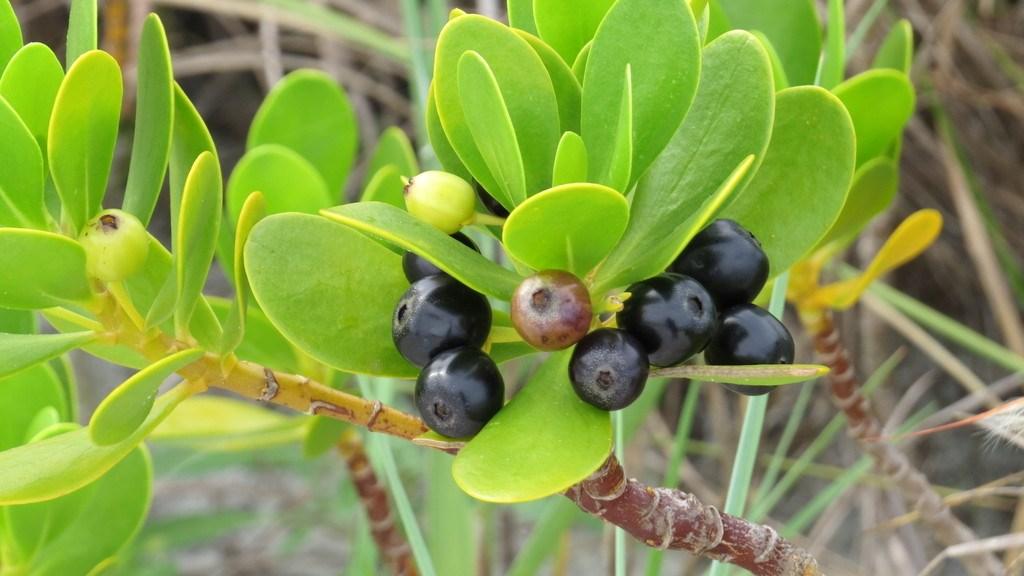
Locustberry (Byrsonima lucida)
An underutilized shrub with showy clusters of multi-colored flowers. Usually found in shrub size, Locustberry can grow to 16 feet in height. Its leaves exhibit a dark green hue on the upper side and a distinct lighter green shade beneath, creating an eye-catching contrast. It has a flat-topped spreading crown and prefers full sun to light shade.

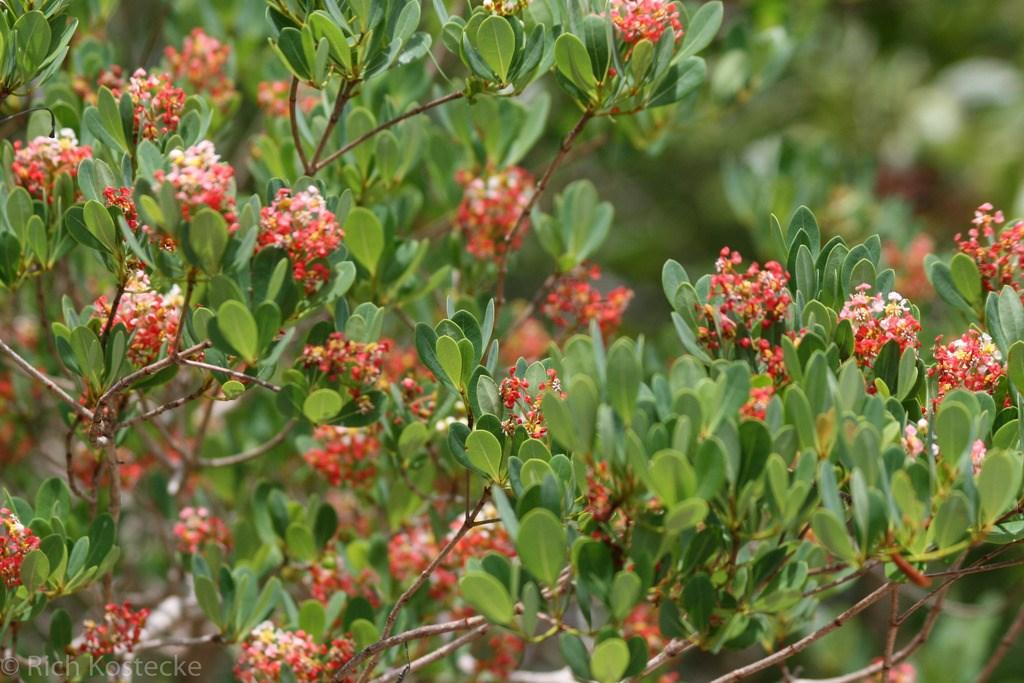
Status Threatened
Salt Water Tolerance Low
31
© Josh Emm, (CC-BY-NC)
© Rich Kostecke, (CC-BY-NC)
Salt Wind Tolerance Moderate Screening Suitable Showy Flowers/ Fruits Showy Butterfly Plant Host
© obrock, (CC
(c) Nils Tack – (CC BY-NC) © obrock, (CC-BY-NC)
Shrub Species
Maidenbush (Heterosavia bahamensis)
Maidenbush, typically found in the Lower Keys rockland hammocks, provides excellent screening and may reach heights to 12 feet or more. The species forms a rounded crown, and has stiff, leathery, grey-green leaves that are paler below. Small greenish flowers are borne in clusters from the stem on male plants and are solitary at the leaf axis in female plants. Fruits are a dry brown 3-lobed capsule. The plant requires full sun.
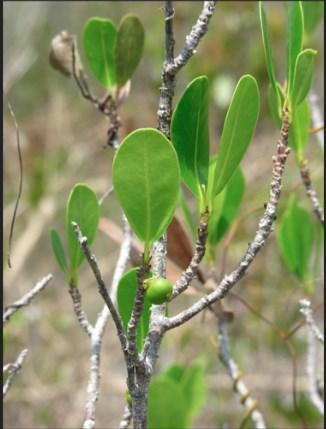
Generally Less Than 10’ Tall
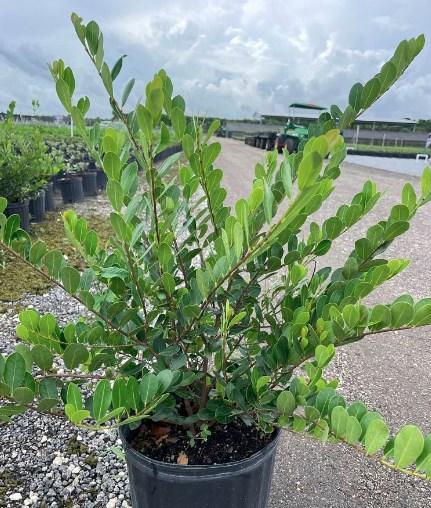
Mangrove SpiderLily - (Hymenocallis latifolia)
This unique species has dark green, strap-like leaves that grow directly from an underground bulb. In addition to the attractive foliage, the plant produces large, showy, white flowers with elegantly drooping petals adorning landscapes from March to October. The plant can reach 3 feet in height, does well in moist soils and prefers full sun to light shade. There are several similar species but the orange pollen on this native identifies it as the species specific to the Keys.
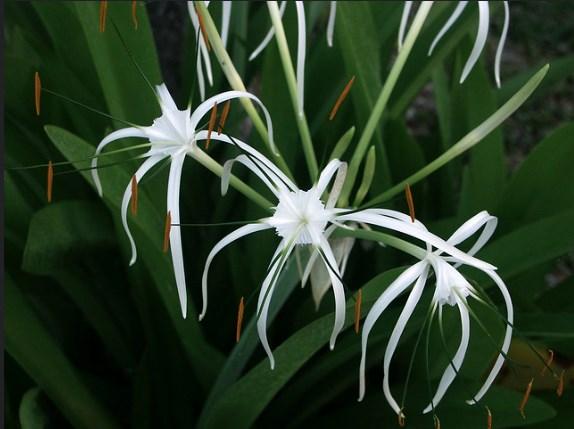

32
© Nohely Reyes, (CC-BY-NC)
Status Native Salt Water Tolerance Moderate Salt Wind Tolerance Moderate Swale Suitable Showy Flowers/ Fruits Showy
© scott.zona Cc BY-NC 4.0
Status Endangered Salt Water Tolerance Low Salt Wind Tolerance Moderate Screening
Credit: Bamboo Hammock Nursery
Suitable
Jenny Evans , (CC BY-NC 2.0) Shrub
Shrub
Shrub Species
Mayten (Maytenus phyllanthoides)
Usually from 10-12 feet in height, this woody shrub with grey bark. It is densely foliated with fleshy green leaves. The weight of the leaves may cause longer branches to droop. The bright red berries contrast nicely with the foliage. This species does well along the mangrove fringe transition area and prefers full sun to light shade.
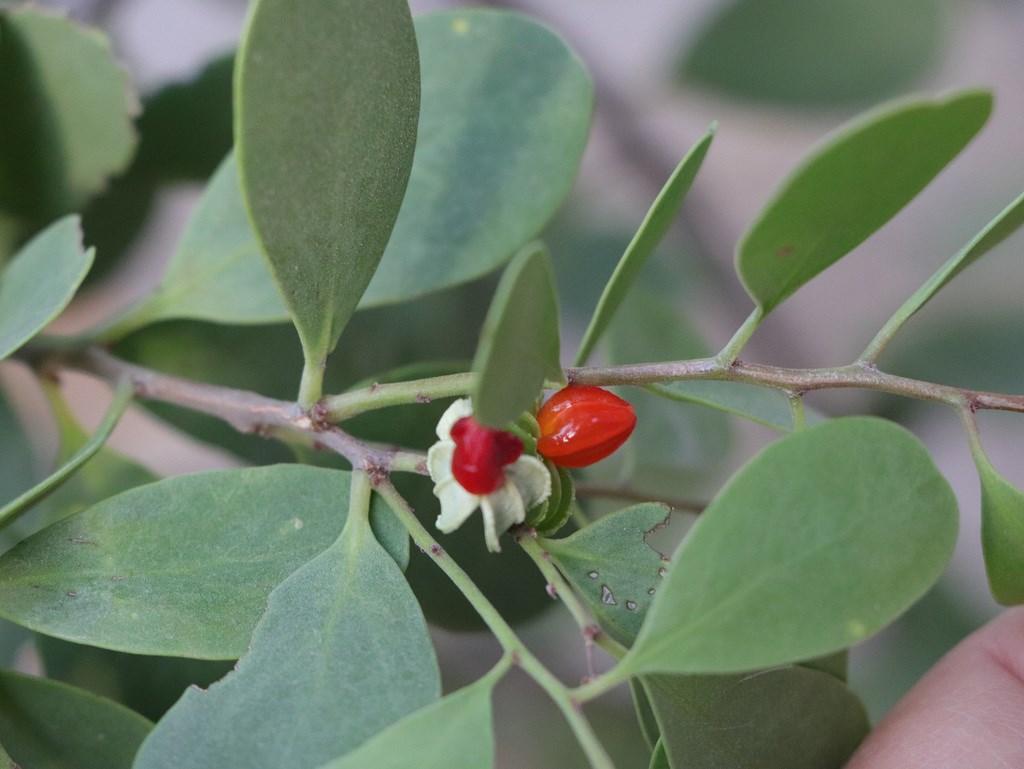
Status Threatened
Pearlberry (Vallesia antillana)
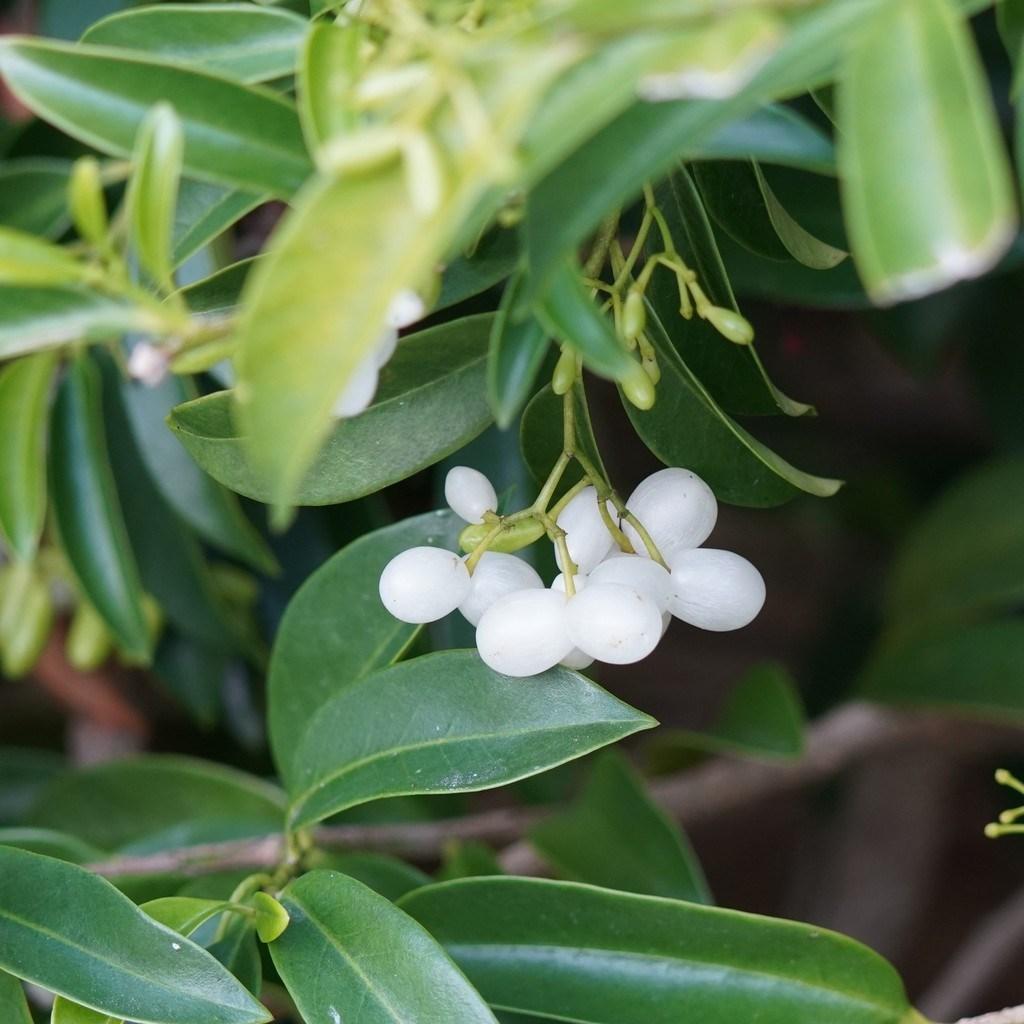
Generally Less Than 10’ Tall

Usually a small shrub but may reach 10 feet in height. Light green lanceolate leaves 2-3 inches long appear on somewhat droopy stems. Small delicate white flowers grow in fruit appears somewhat translucent. The shrub
Salt Water Tolerance Moderate
Salt Wind Tolerance Moderate Swale Suitable


Status Endangered
Salt Water Tolerance Moderate
Salt Wind Tolerance Moderate
Treeworld Wholesale (CCBY 2.0)
(c) bharding81 - (CC BY
© Isaac Lord, (CC-BY-NC)
© Sue Carnahan, (CC-BY-NC)
(c) dvalov – (CC BY-NC)
Shrub Species
Randia, White Indigoberry (Randia aculeata)
Generally Less Than 10’ Tall
A shrub to 10 feet with small blunt glossy-green leaves. Often with opposite branching creating a unique “ v” shape from the trunk. Spines are often present. Small white flowers produce greenish-white fruits. The species is a larval host plant for Tantalus sphinx months and a nectar plant for Schaus' swallowtail and other butterflies.


Sea Lavender (Heliotropium gnaphalodes)
A striking mounding shrub that grows from 3 to 6 feet in height. This endangered species is densely adorned with small, soft, hairy silvery-green leaves. Small white flowers are clustered on curved terminal spikes. The plant does well in coastal areas and dunes, preferring well drained and sandy soils. The species is an effective erosion control plant.
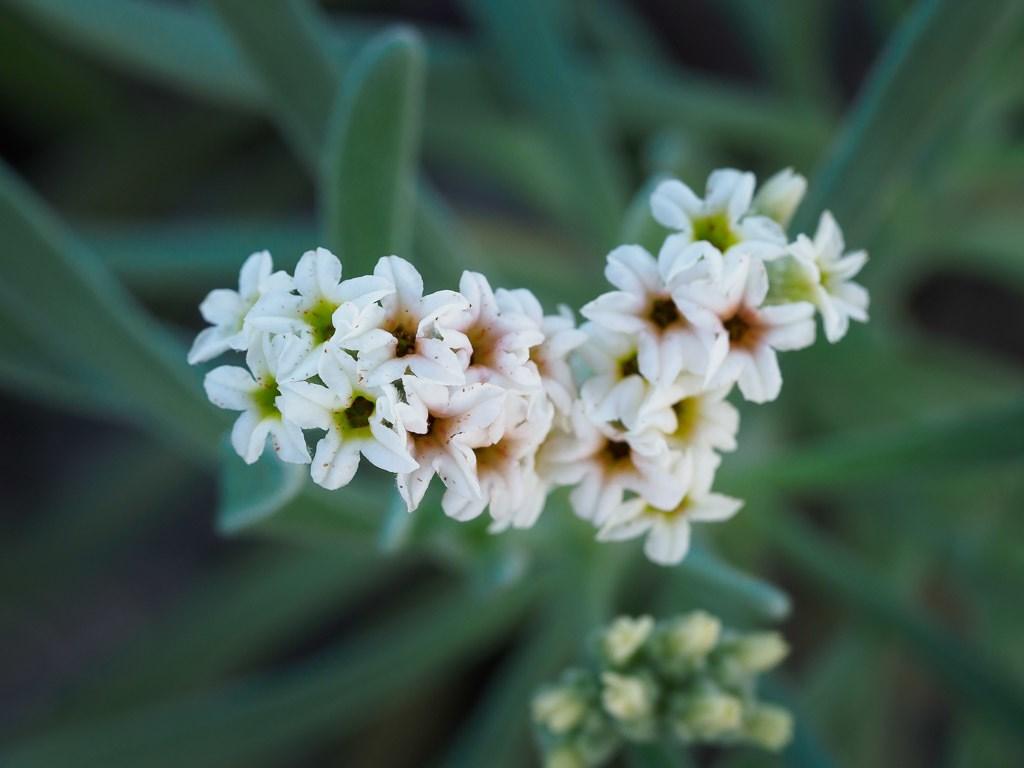
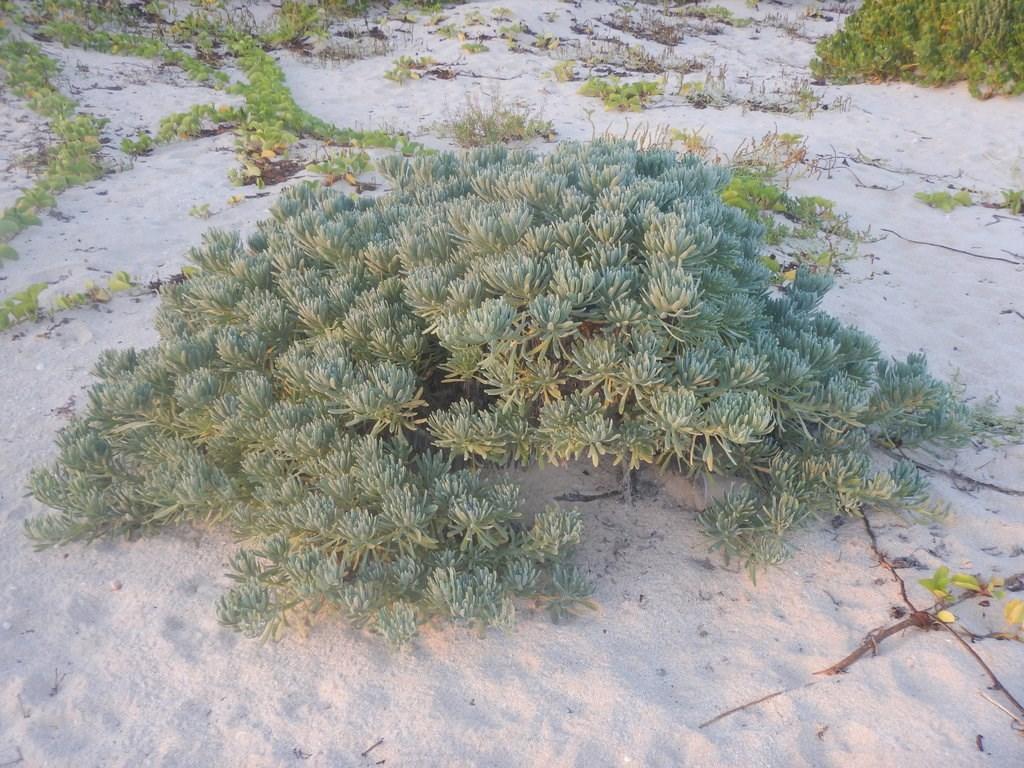
34
Sam Kieschnick, CC BY 4.0
mefisher, CC0 1.0.
Status Native Salt Water Tolerance Low Salt Wind Tolerance Moderate Swale Suitable Butterfly Plant Nectar
© Deneb Ortigosa, (CC-BY-NC)
© Francisco Herrera, (CC-BY-NC)
Status Endangered Salt Water Tolerance Low Salt Wind Tolerance High Screening Suitable Butterfly Plant Nectar Shrub
Shrub
Shrub Species
Sea-oxeye-daisy, Green (Borrichia arborescens)
Sea-oxeye-daisy, Silver (Borrichia frutescens)
Both are wildflowers common on the coast of the Keys. Both have bright yellow flowers that resemble little sunflowers and typically reach a height of 3-4 feet. B. arborescens has succulent, smooth green leaves and tends to grow slightly taller than B. frutescens. B. frutescens has slightly hairy grey-green leaves. Both can be hedged.
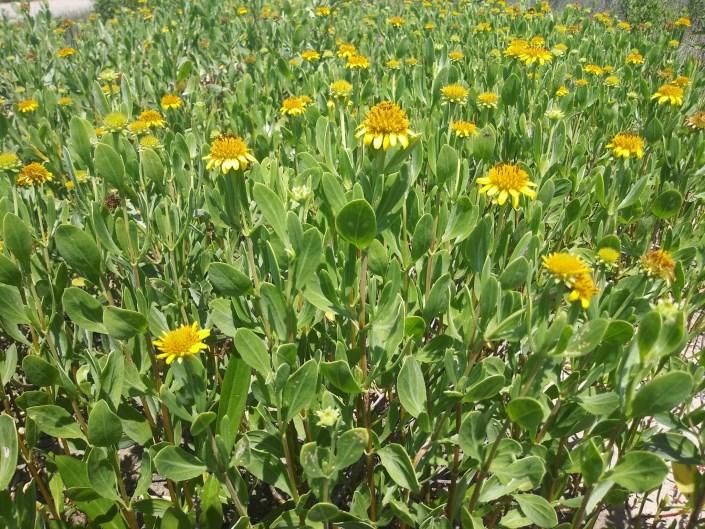
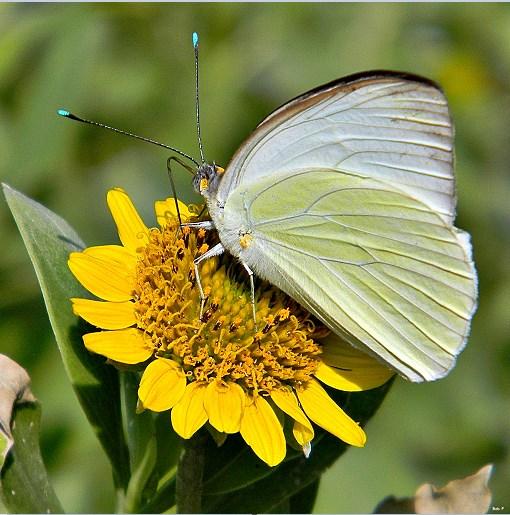
Wild Lantana (Lantana involucrata)
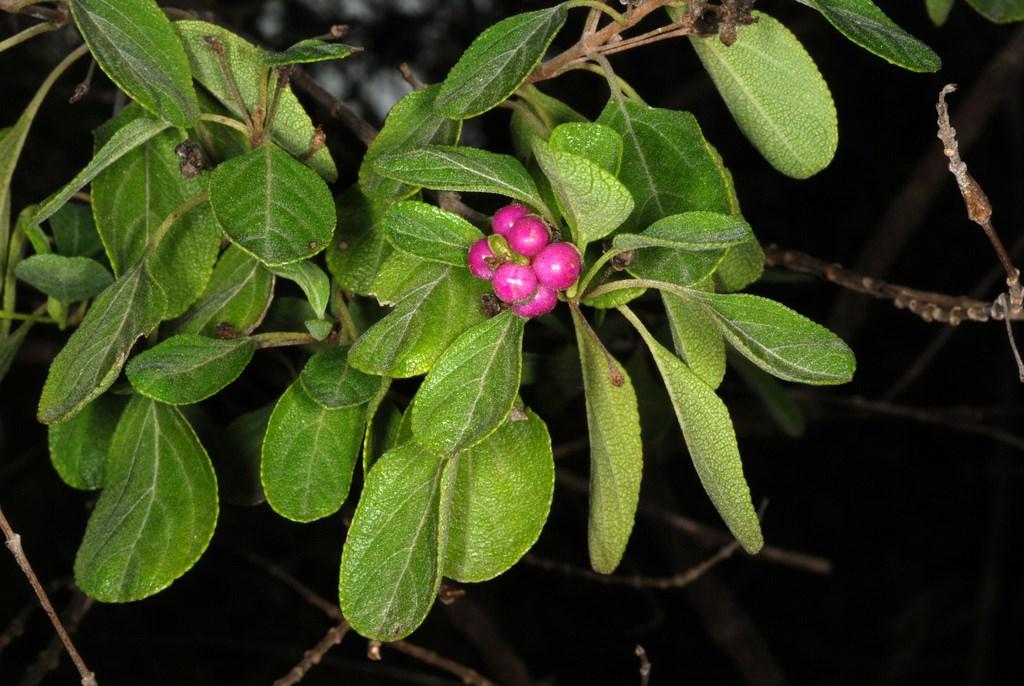
Generally Less Than 10’ Tall
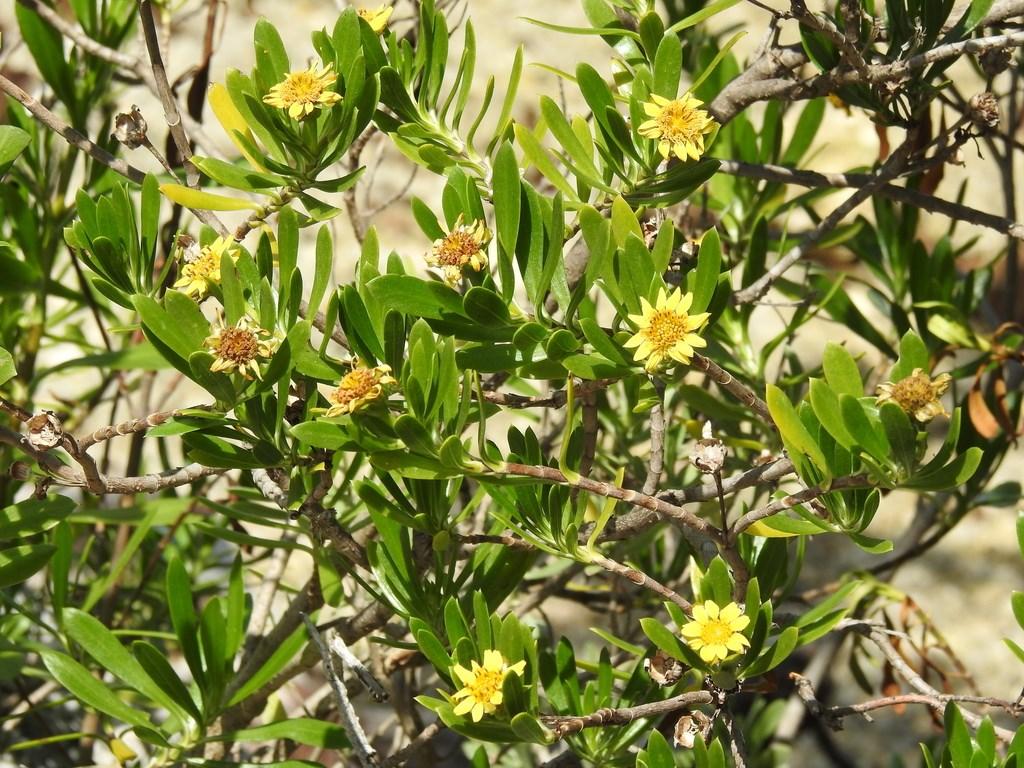
A small shrub with a rounded crown to 8 feet in height with small, rough light-green leaves. The native species has white, sometimes light lavendar or pink flowers with yellow centers. Fruits are purple. The leaves are pleasantly aromatic when crushed. The species prefers full sun.
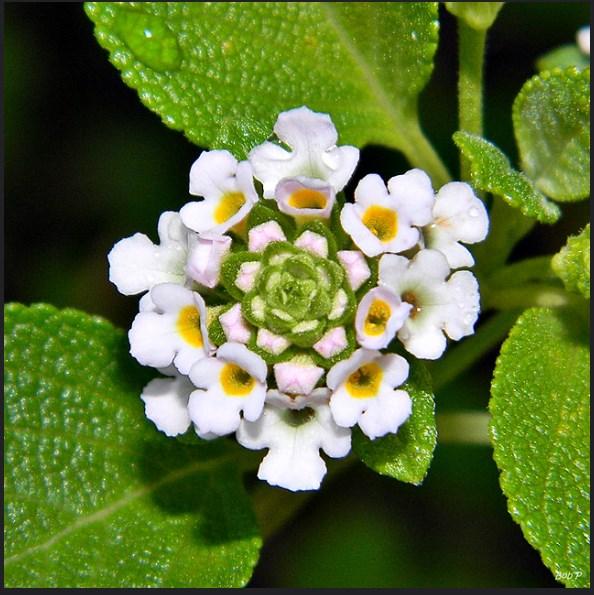
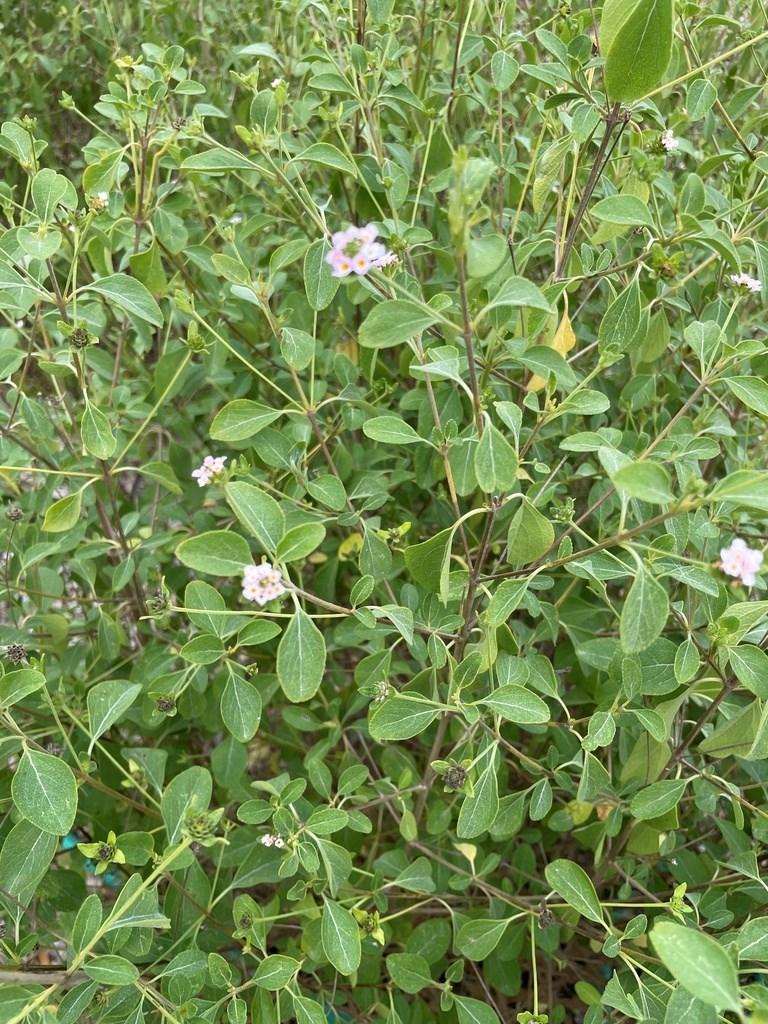
Status Native Salt Water Tolerance Low
Salt Wind Tolerance Mod/High
Showy Flowers/ Fruit Semi Butterfly Plant Nectar
35
© alangrandiflora, (CC-BY-NC)
© Douglas Goldman, (CCBY-NC)
(c) Daniel Onea – (CC BY-NC)
© Mary Keim, (CC-BY-NC-SA)
Status Regionally Important Salt Water Tolerance Moderate Salt Wind Tolerance High Butterfly Plant Nectar
Flower with Great Southern White © Bob Peterson (CC BY 2.0 DEED)
Groundcovers, Vines and Grasses
Blue Porterweed (Stachytarpheta jamaicensis)
A sprawling groundcover that attracts hummingbirds and serves as the host plant for the tropical buckeye butterfly and a nectar plant for a multitude of others. Typically 1 to 2 feet tall with a 2 to 3 foot spread. The plant produces quilllike spikes with small blue to purple flowers and prefers full sun.


Fun Fact: In keeping with its name the plant has been reported to be used to make a porter-like drink in the Bahamas. Please check with authorities on edible plants prior to consuming any plant
IMPORTANT: Species is easily confused with Stachytarpheta cayennensis Be sure to purchase only from a nursery that specializes in native plants.

East Coast Dune Sunflower (Helianthus debilis subsp. debilis
A spreading wildflower found on dunes that prefers full sun and does well in sandy soils. The plant grows to about 2 feet in height with a spread of 2 to 4 feet and will reseed. The bright yellow flowers and seeds attract wildlife. The species self
Fun Fact: The flowers follow the direction of the sun throughout the day.
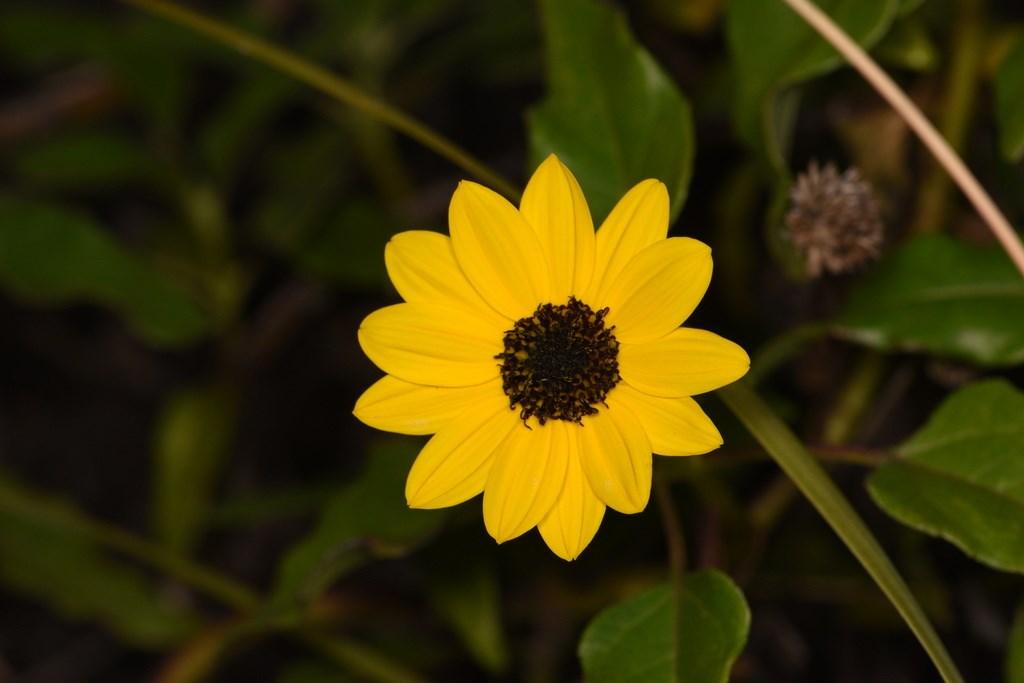

36
Albert, (CC BY-SA 3.0)
Bernard DUPONT, (CC BY-SA 2.0)
Status Native Salt Water Tolerance Low Salt Wind Tolerance Moderate Butterfly Plant Host/Nectar Showy Flowers/ Fruit Semi
© Claire O'Neill, (CCBYNC)
Brandon Evans (CCO 1.0)
Groundcovers, Vines & Grasses
© Aidan Campos, (CC-BY-NC)
Status Native Salt Water Tolerance Low Salt Wind Tolerance High Showy Flowers/ Fruits Showy
Groundcovers, Vines & Grasses
Groundcovers, Vines and Grasses
Elliott’s lovegrass (Eragrostis elliottii)
A tufted, clumping grass typically 1 to 2 feet tall. The tan to grey billowy plumes bloom in the summer and fall to create a soft showy contrast in the landscape. The abundant seeds attract birds and pollinators. The plant prefers full sun and does well in moist soils which makes it a good choice for swale plantings.
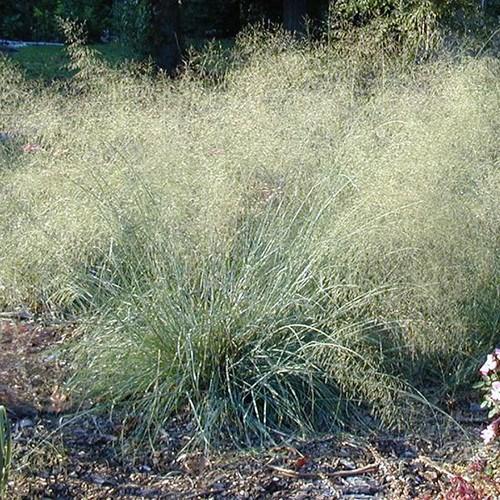
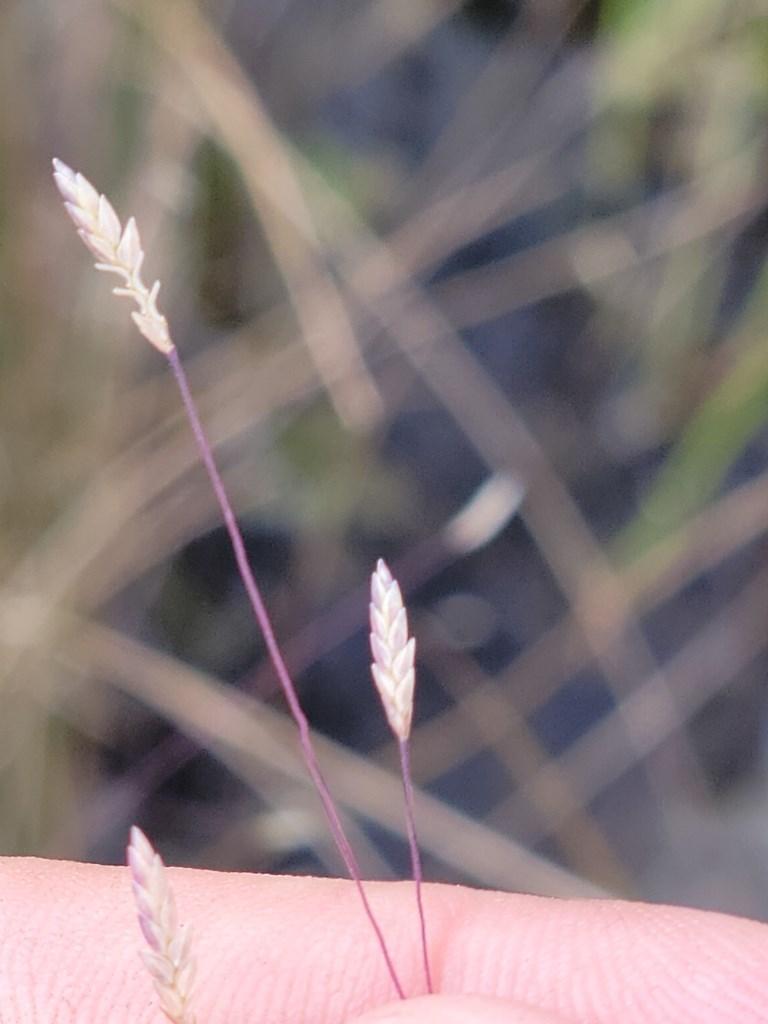
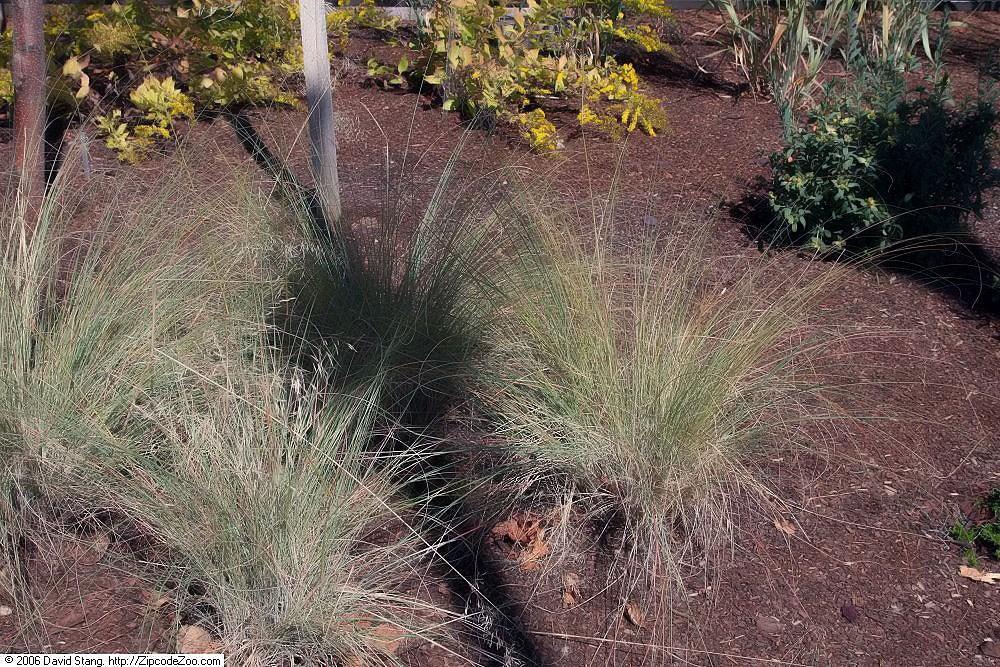
Golden Creeper (
This versatile plant, reaching up to 3 feet in height, thrives in dunes, beaches, and coastal hammocks, serving as an adaptable groundcover or shrub. It can be easily shaped as a border in formal landscapes or left to grow naturally in clumps within more organic settings.
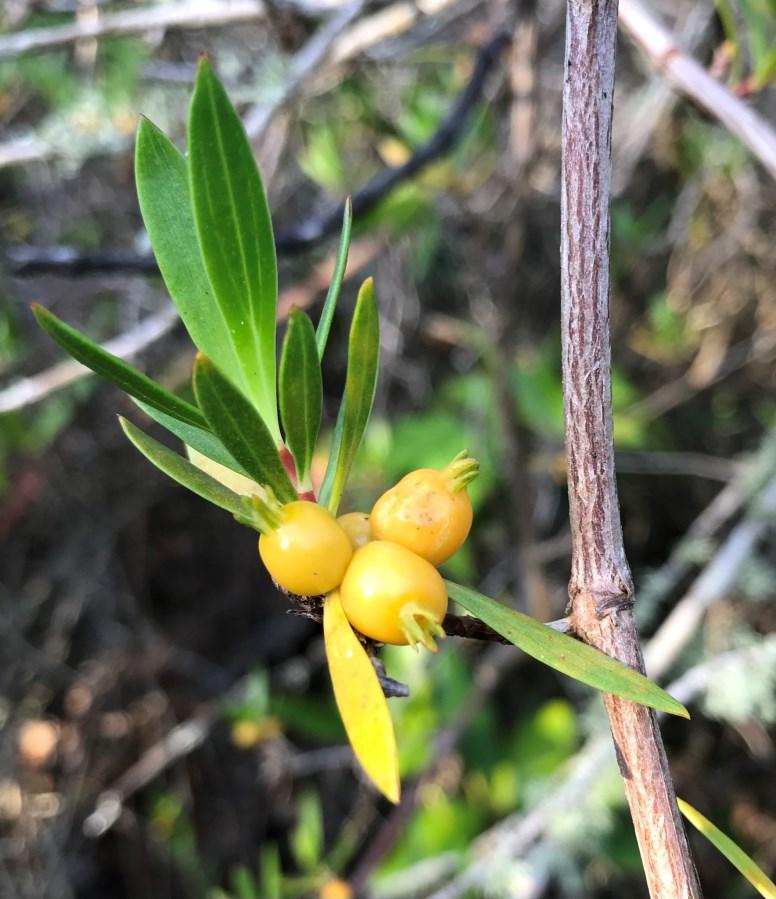
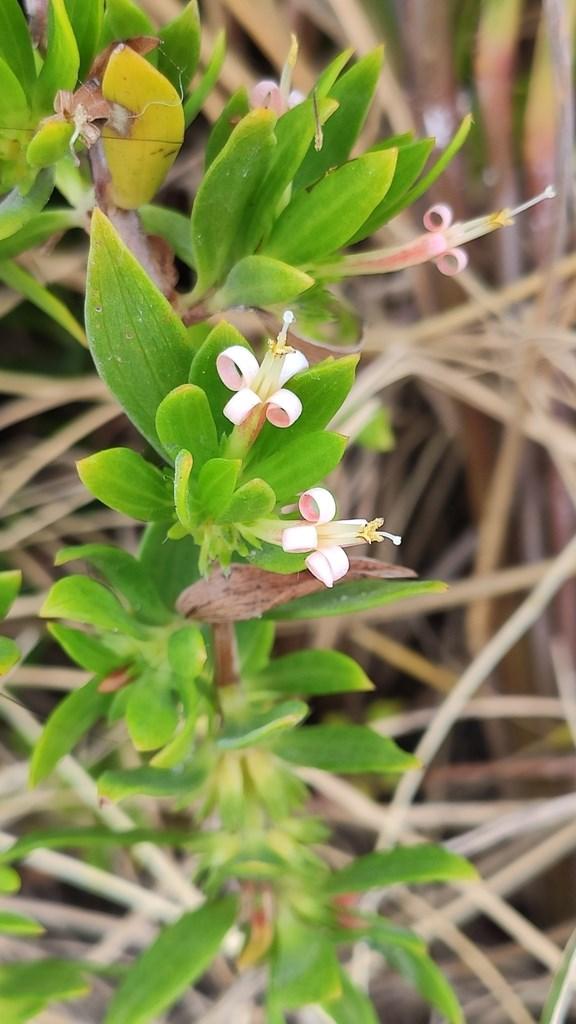

Abundant small, shiny green leaves, sometimes tinged with a faint yellow hue, adorn its sprawling limbs, which reroot easily, facilitating its spread. Delicate pinkish white tubular flowers give way to round yellow fruits. Thriving in full sun and capable of withstanding moist soils, it stands as an excellent choice for plantings in swales.
37
Credit: Plant World Seeds
© Jay Horn, (CC-BY)
Status
Salt Water Tolerance
Salt Wind Tolerance
Swale
© 2006 David Stang http://ZipcodeZoo.com
Native
Low
High
Suitable
Credit: Monroe County Environmental Resources
© Patti Haynes, (CC-BY-NC)
Status Native Salt Water Tolerance
Salt Wind Tolerance Moderate
Suitable
© Patti Haynes, (CC -BY-NC)
Low
Swale
Groundcovers, Vines and Grasses
Muhly Grass (Muhlenbergia capillaris)
A tall ornamental grass with deep green blades and captivating, feathery pink-purple blooms that emerge during in the fall. This grass can reach up to 3 feet in height, with its flowering phase often extending its stature even further. Spanning approximately 3 feet as it spreads, it thrives best in full sun or light shade, proving itself to be effortlessly cultivated and easily pruned when necessary.


Status Native Salt Water Tolerance Moderate
Salt Wind Tolerance High
Showy Flowers/ Fruits Showy
Railroad Vine (Ipomoea pes-caprae subsp. brasiliensis)
A ground cover with long trailing stems that can exceed 20 feet in length. Oval bright green leaves are notched and the relatively large, purple flowers with darker purple stripes make a stunning contribution to the landscape. The plant works well as a beach dune stabilizer. It prefers moist well-drained sandy soil and full sun.

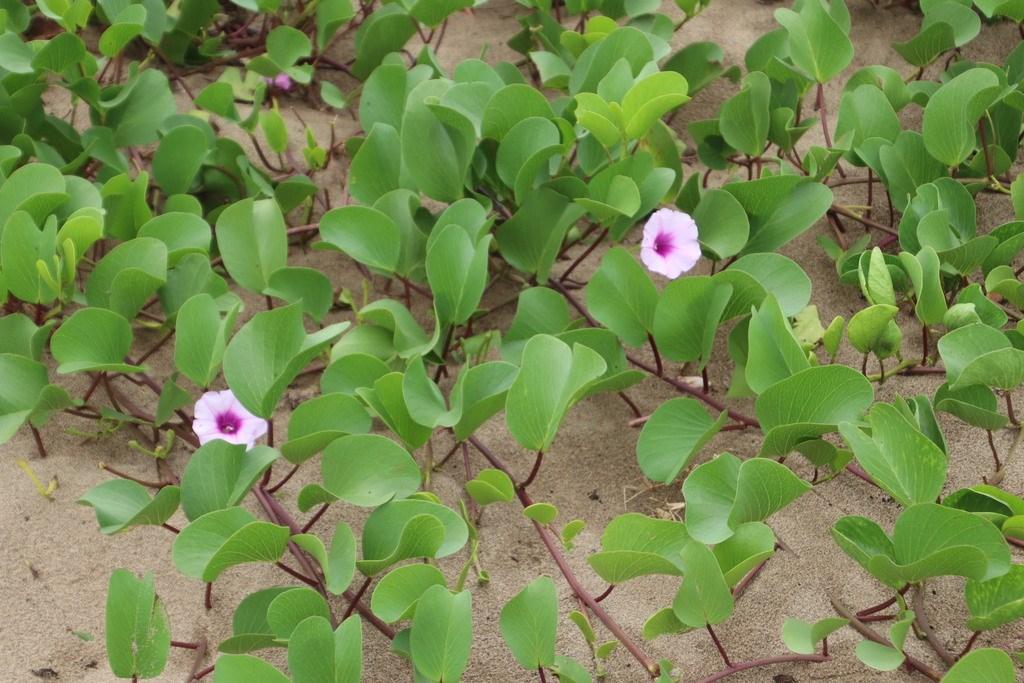
38
John Winder (CC BY-NC-ND 2.0)
(c) Lauren McLaurin (CC BY)
© Tony Rebelo, (CC-BY-SA)
© Craig Peter, (CC-BY-NC)
Status Native Salt Water Tolerance Moderate Salt Wind Tolerance High Showy Flowers/ Fruits Showy Groundcovers, Vines & Grasses
Groundcovers, Vines & Grasses
Groundcovers, Vines and Grasses
Saltmeadow Cordgrass (Spartina patens)
This ornamental grass exhibits a clumping growth habit yet has the potential to spread. Its slender leaves showcase a dual tone, with a rich dark green on top and a contrasting lighter green below. These leaves elegantly arch outward, creating a beautiful spray pattern. Reaching approximately three feet in height, it thrives in full sun, showcasing adaptability by tolerating wet soils, thereby making it an excellent option for planting in swales.

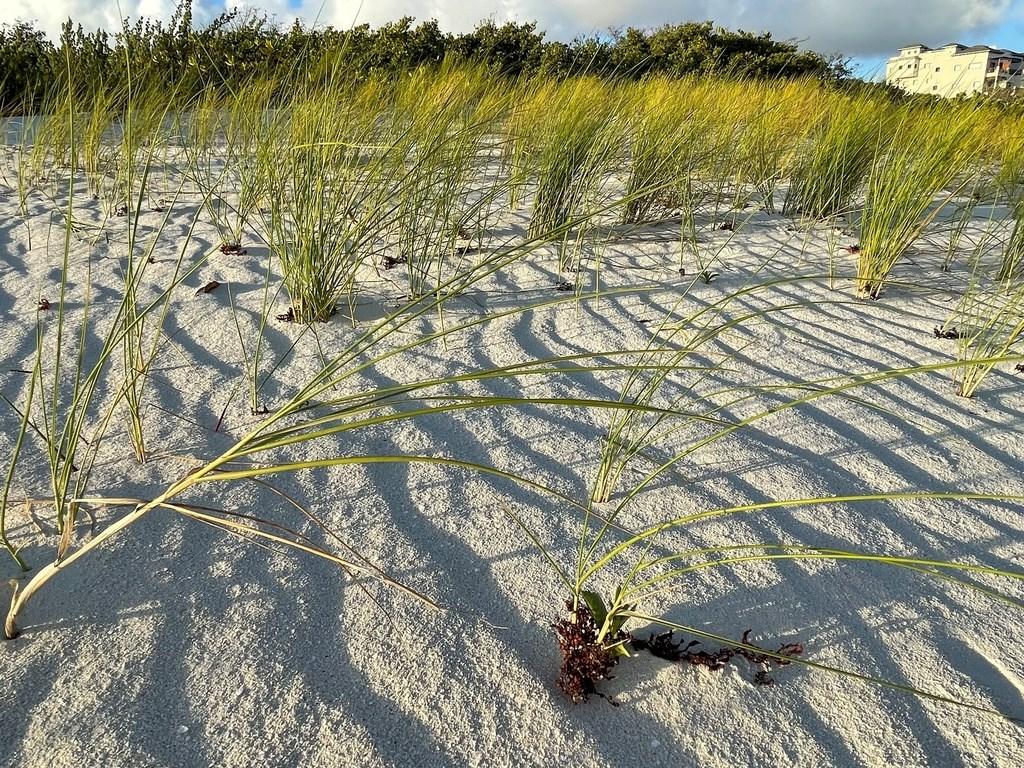
Skyblue clustervine (Jacquemontia pentanthos)
A gorgeous twining, flowering vine that readily spreads and climbs. Heart-shaped leaves are found on stems that can exceed 6 feet in length. It is a prolific flowering species, blooming in winter, with numerous small, delicate, sky blue morning shaped flowers. The plant requires full sun and does well in well-drained soils.
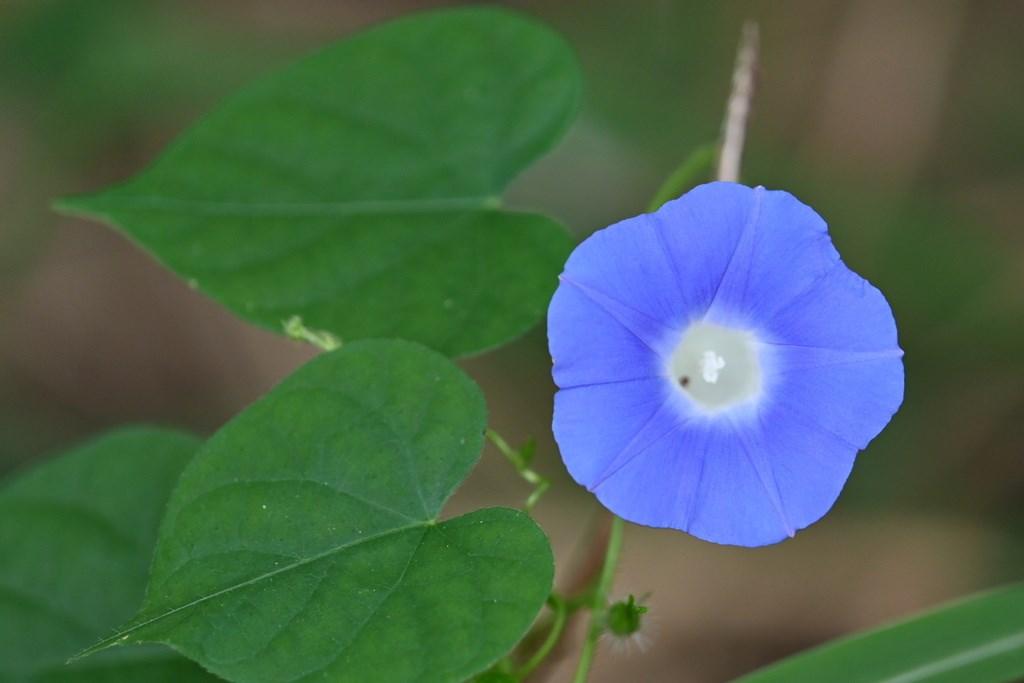

39
© Entz, (CC-BY-NC)
Status
© Frank Izaguirre, (CC-BY-NC)
Native Salt Water Tolerance High Salt Wind Tolerance Mod/High Swale Suitable
Status
Salt
© Altaf Habib, (CC-BY-NC)
Endangered
Water Tolerance Low Salt Wind Tolerance High Showy Flowers/ Fruits Showy
© Scott Sutherland, (CC-BY-NC)
Groundcovers, Vines and Grasses
Snowberry (Chiococca sp.)
Three species of snowberry are found in the Florida Keys (C. alba, C. parvifolia and C. pinetorum). All grow as climbing vine-like shrub with dark green shiny leaves.
C. alba is the most common species. It boasts clusters of small, fragrant, white to yellow flowers that bloom year-round, followed by round, snow-white berries, adding ornamental charm to landscapes. This shrub typically reaches a height of 6 to 12 feet, featuring glossy green leaves arranged neatly along its branches. This species prefers part shade.
C. parvifolia, also known as small-leaved snowberry, is very similar to C. alba but slightly smaller in stature and leaf size. This species prefers full sun to part shade.
C. pinetorum (Lower Keys Only) is the smallest of the three, growing to about 2 feet tall. Flower spikes are adorned with small white to yellow bell-shaped flowers and bloom year-round. This species prefers full sun to part shade.
The flowers and berries of all three add ornamental charm to the landscape.
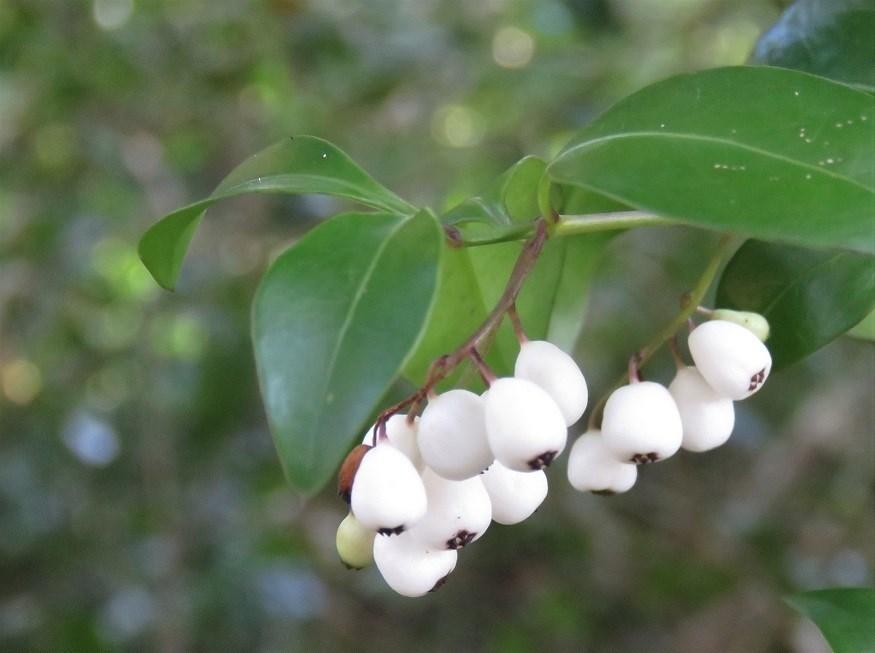
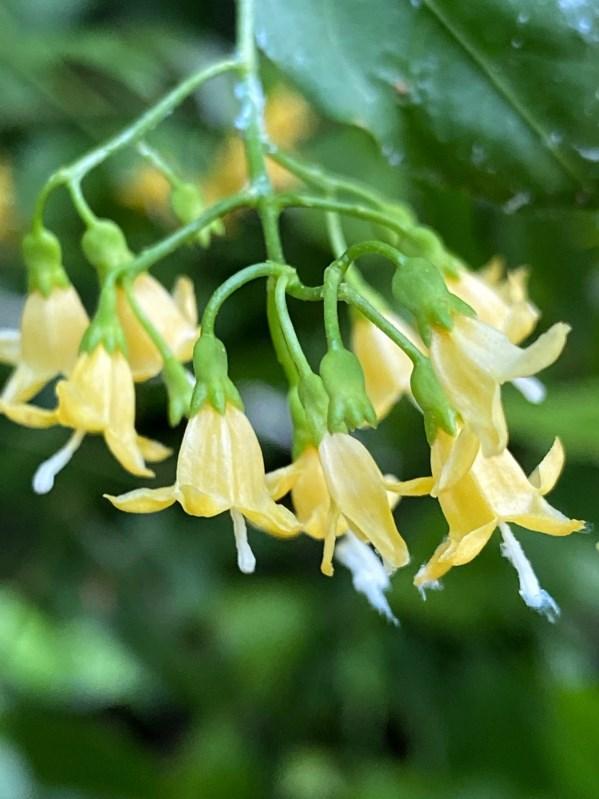
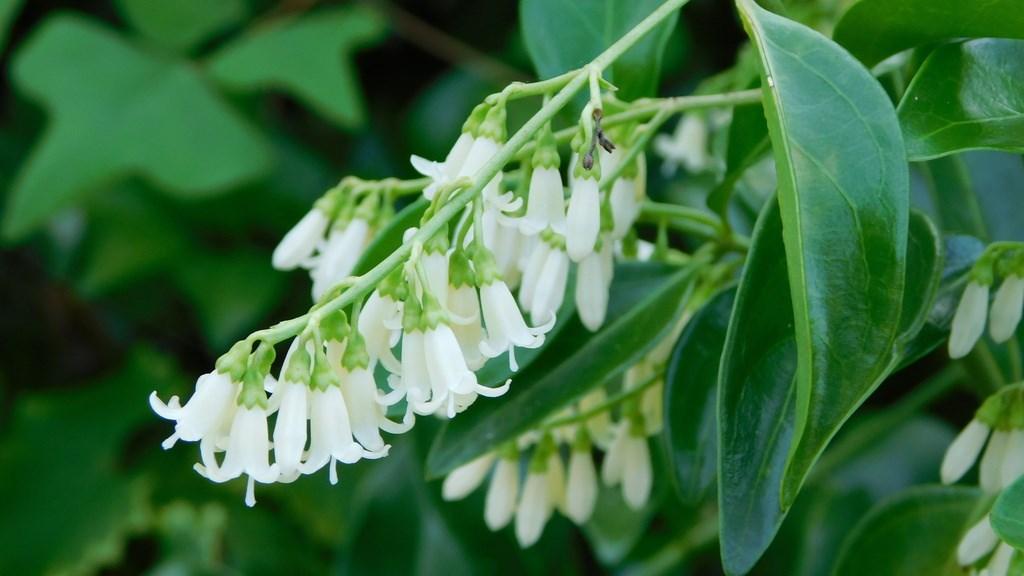
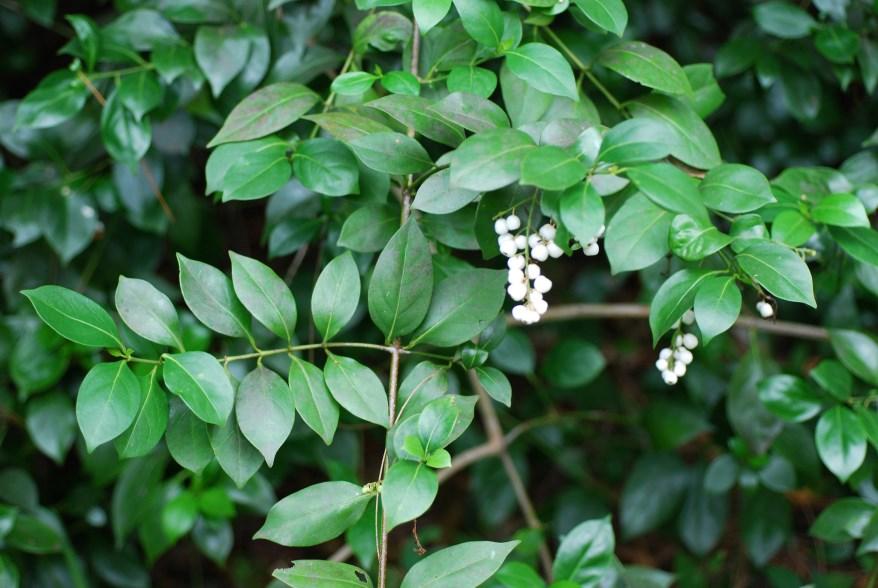
40
(c) Douglas Goldman – (CC BY-NC)
Status Native Salt Water Tolerance Low Salt Wind Tolerance Low* Showy Flowers/ Fruits Showy Butterfly Plant Nectar Groundcovers, Vines & Grasses
high salt wind tolerance.
Chiococca alba - © Stephanie C, (CC0)
*C. alba has a moderate to
Chiococca alba - © j_appleget – (CC BY-NC)
(c) Armando Feliciano – (CC BY-NC)
Useful References & Resources
Plant Identification Books
• Hammer, Roger L. 2022. Wildflowers of the Florida Keys.Guilford Ct: The Rowman and Littlefield _ Publishing Group, Inc.
• Scurlock, J. Paul.1987. Native Trees and Shrubs of the Florida Keys: A Field Guide. Pittsburgh, Pa: Laurel _ Press
• Tomlinson, P. B. 2001. The Biology of Trees Native to Tropical Florida. Alston, Ma: Harvard Printing and _ Publication Services
Plant Identification Websites
• Atlas of Florida Plants
Wunderlin, R. P., B. F. Hansen, A. R. Franck, and F. B. Essig. 2023. Atlas of Florida Plants (http:// florida.plantatlas.usf.edu/). [S. M. Landry and K. N. Campbell (application development), USF Water Institute.] Institute for Systematic Botany, University of South Florida, Tampa.
• Florida Natural Areas Inventory
Florida Natural Areas Inventory. (2023). Florida Natural Areas Inventory. https://www.fnai.org/
• Floristic Inventory of the Florida Keys
Regional Conservation. (2023). IRCs Database. Retrieved from https://regionalconservation.org/ircs/database/ DatabaseFK.asp
• Natives for Your Neighborhood
Gann GD, Abbott CJ, Hines KN, and Collaborators. 2005-2023. Natives For Your Neighborhood. The Institute for Regional Conservation. Delray Beach, Florida. https://www.regionalconservation.org/beta/ nfyn/
Plant Landscaping Links
• Newcomers Guide to Landscaping in the Florida Keys
IFAS-Extensions-Landscaping-PDF (cityofkeywest-fl.gov)
• Florida Friendly Landscaping - Handbook for Home Landscapes
https://ffl.ifas.ufl.edu/media/fflifasufledu/docs/FFL-Handbook_03172022_web.pdf
• Florida Native Plant Society - Landscaping with Natives
Florida Native Plant Society. (2023). Landscaping with Native Plants. Retrieved from https://www.fnps.org/what -we-do/landscaping
41
Deer-Resistant Landscaping Tactics
Numerous words have been used to describe Key deer (Odocoileus virginianus clavium) iconic, adorable, diminutive, and resilient. However, if you own property in key deer territory, the word that likely comes to mind is 'voracious'!
If you reside in this area, and wish to maintain a vibrant landscape, do not despair. There are strategies that you can employ to enjoy these marvelous creatures and your lush landscaping.
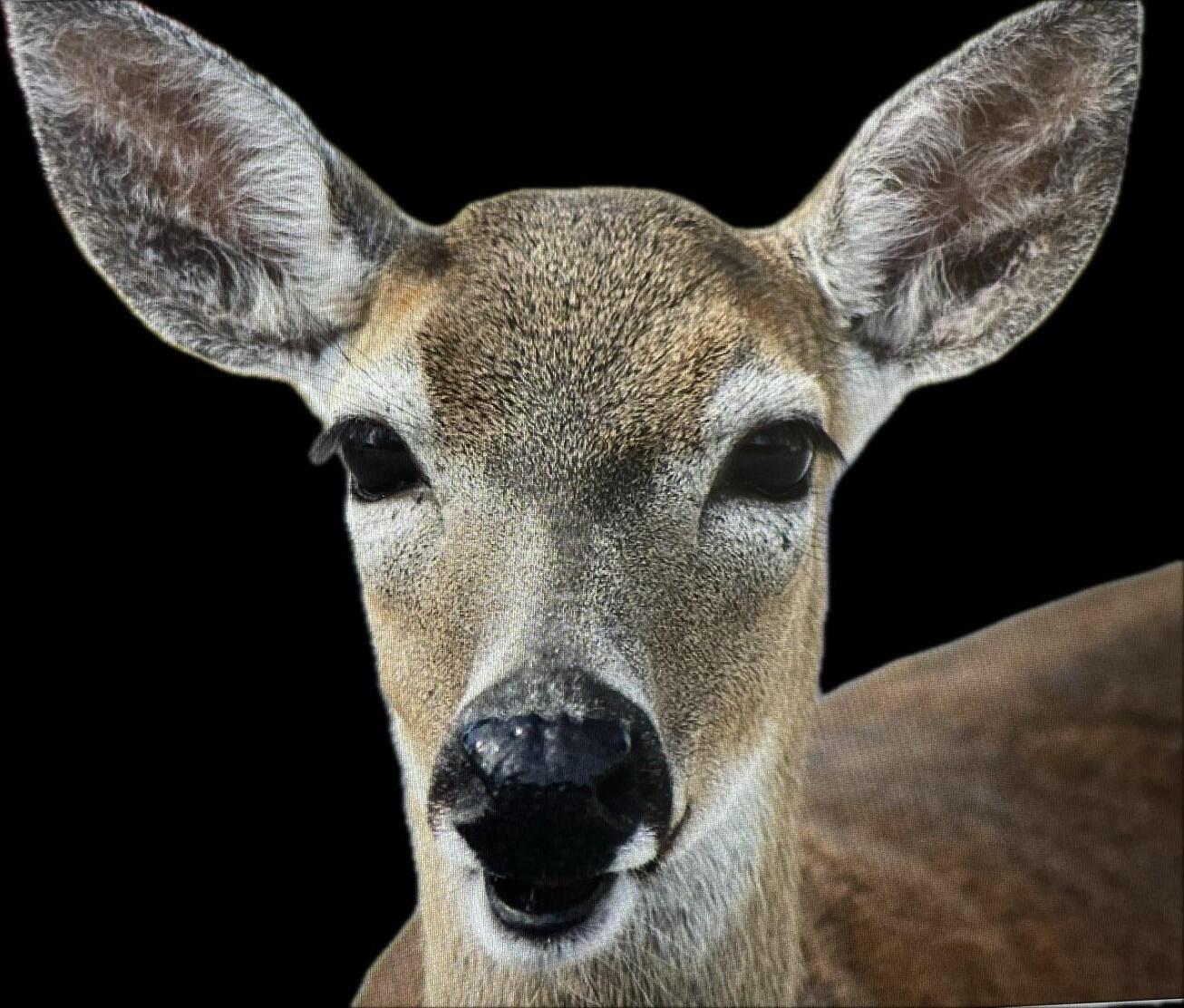
1. Choose wisely. Below is a list of plants that have, in general, been successfully planted by Monroe County within Key deer habitat and not typically eaten by the Key deer. It's important to note that while these plants are less appealing to the deer, this is not an absolute guarantee. Hungry deer may unexpectedly explore new tastes. Moreover, well-watered, nutrient-rich nursery stock can be especially attractive to Key deer, particularly during the dry season when freshwater is scarce.
2. Heed height. Though typically small in stature, they can reach up to six feet when standing on their hind legs. If you're considering planting canopy trees, it's advisable to purchase trees with foliage extending beyond the sixfoot mark.
3. Stabilize with Stakes. Be sure to stake those freshly installed canopy trees. The deer sometimes don’t realize their own limitations and may knock into you tree in a vain attempt to reach the foliage. It's advisable to remove the stakes after the first year.
42
Species on the Key Deer’s Nonpreferred Food List* Common Name Page Common Name Page Bahama senna 26 Saltmeadow cordgrass 39 Bay cedar 26 Saw palmetto 12 Blackbead, catclaw 12 Seagrape 7 Blackbead, Fl. Keys 12 Silver palm 11 Buccaneer palm 9 Slash pine 8 Cabbage Palm 10 Stopper, Red 21 Coontie 29 Stopper, Redberry 21 Darlingplum/Red ironwood 15 Stopper, Spanish 21 Jamaica caper 16 Stopper, White 21 Jamaica dogwood 3 Thatch palm, Florida 10 Joewood 16 Thatch palm, Keys 11 Locustberry 31 Velvetseed, Everglades 23 Muhly grass 38 Wax-Myrtle 24 Pigeon plum 6 Wild dilly 25 *Please be aware, this list is not foolproof. See text
information.
Credit: Big Pine Key Fishing Lodge, (CC BY 2.0 DEED)
above for more
43 Index - Common and Scientific Names Amyris elemifera 22 Damburneya coriacea 4 Ardisia escallonioides 18 Darlingplum/Red ironwood 15 Bahama senna 26 Drypetes diversifolia 5 Bay cedar 26 East coast dune sunflower 36 Beautyberry 27 Elliott’s lovegrass 37 Black ironwood 1 Eragrostis elliottii 37 Blackbead, catclaw 12 Erithalis fruticosa 27 Blackbead, Fl. Keys 12 Ernodea littoralis 37 Blacktorch 27 Eugenia axillaris 21 Blolly 13 Eugenia confusa 21 Blue porterweed 36 Eugenia foetida 21 Borrichia arborescens 35 Eugenia rhombea 21 Borrichia frutescens 35 Exostema caribaeum 6 Bourreria cassinifolia 22 Exothea paniculata 3 Bourreria radula 22 Fiddlewood 15 Bourreria succulenta 22 Firebush 29 Buccaneer palm 9 Florida boxwood 30 Bursera simaruba 2 Florida swampprivet 30 Buttonwood 1 Forestiera segregata 30 Byrsonima lucida 31 Geiger tree 2 Cabbage Palm 10 Golden creeper 37 Callicarpa americana 27 Guaiacum sanctum 17 Canella winterana 13 Guapira discolor 13 Casasia clusiifolia 20 Guettarda elliptica 23 Chiococca alba 40 Guettarda scabra 23 Chiococca parvifolia 40 Gumbo limbo 2 Chiococca pinetorum 40 Gymnanthes lucida 14 Chrysobalanus icaco 28 Hamelia patens var. patens 29 Chrysophyllum oliviforme 7 Helianthus debilis subsp. debilis 36 Cinnamonbark 13 Heliotropium gnaphalodes 34 Cinnecord 14 Heterosavia bahamensis 32 Citharexylum spinosum 15 Hymenocallis latifolia 32 Coccoloba diversifolia 6 Hypelate trifoliata 24 Coccoloba uvifera 7 Inkberry 31 Coccothrinax argentata 11 Inkwood 3 Cocoplum 28 Ipomoea pes-caprae subsp. brasiliensis 38 Coffee, Bahama 28 Jacquemontia pentanthos 39 Coffee, wild 28 Jacquinia keyensis 16 Colubrina elliptica 20 Jamaica caper 16 Conocarpus erectus 1 Jamaica dogwood 3 Coontie 29 Joewood 16 Cordia sebestena 2 Krugiodendron ferreum 1 Crabwood 14 Lancewood 4 Crossopetalum rhacoma 19 Lantana involucrata 35 Cynophalla flexuosa 17 Leucothrinax morrisii 11
44 Index - Common and Scientific Names Lignumvitae 17 Seagrape 7 Limber caper 17 Sea-oxeye-daisy, green 35 Locustberry 31 Sea-oxeye-daisy, silver 35 Lysiloma latisiliquum 8 Senna mexicana var. chapmanii 26 Maidenbush 32 Serenoa repens 12 Mangrove spiderlily 32 Seven-year apple 20 Manilkara jaimiqui subsp. emarginata 25 Sideroxylon foetidissimum 4 Marlberry 18 Sideroxylon salicifolium 9 Mastic 4 Silver palm 11 Mayten 33 Simarouba glauca 5 Maytenus phyllanthoides 33 Skyblue clustervine 39 Milkbark 5 Slash pine 8 Muhlenbergia capillaris 38 Snowberry, common 40 Muhly grass 38 Snowberry, pineland 40 Myrcia neopallens 21 Snowberry, small-leaved 40 Myrcia zuzygium 19 Soldierwood 20 Myrica cerifera 24 Spartina patens 39 Myrsine 18 Spicewood, Pale lidflower 21 Myrsine cubana 18 Stachytarpheta jamaicensis 36 Myrtle-of-the-River 19 Stopper, Red 21 Paradise tree 5 Stopper, Redberry 21 Pearlberry 33 Stopper, Spanish 21 Pigeon plum 6 Stopper, White 21 Pinus elliottii var. densa 8 Strongback, Bahama 22 Piscidia piscipula 3 Strongback, pineland 22 Pithecellobium keyense 12 Strongback, rough 22 Pithecellobium unguis-cati 12 Suriana maritima 26 Princewood 6 Thatch palm, Florida 10 Pseudophoenix sargentii 9 Thatch palm, Keys 11 Psychotria ligustrifolia 28 Thrinax radiata 10 Psychotria nervosa 28 Torchwood 22 Quadrella jamaicensis 16 Vachellia choriophylla 14 Railroad vine 38 Vallesia antillana 33 Randia aculeata 34 Velvetseed, Everglades 23 Randia, White indigoberry 34 Velvetseed, rough 23 Reynosia septentrionalis 15 Wax-Myrtle 24 Rhacoma 19 White ironwood 24 Sabal Palmetto 10 Wild dilly 25 Saltmeadow cordgrass 39 Wild lantana 35 Satinleaf 7 Wild lime 25 Saw palmetto 12 Wild tamarind 8 Scaevola plumieri 31 Willow bustic 9 Schaefferia frutescens 30 Zamia integrifolia 29 Sea lavender 34 Zanthoxylum fagara 25
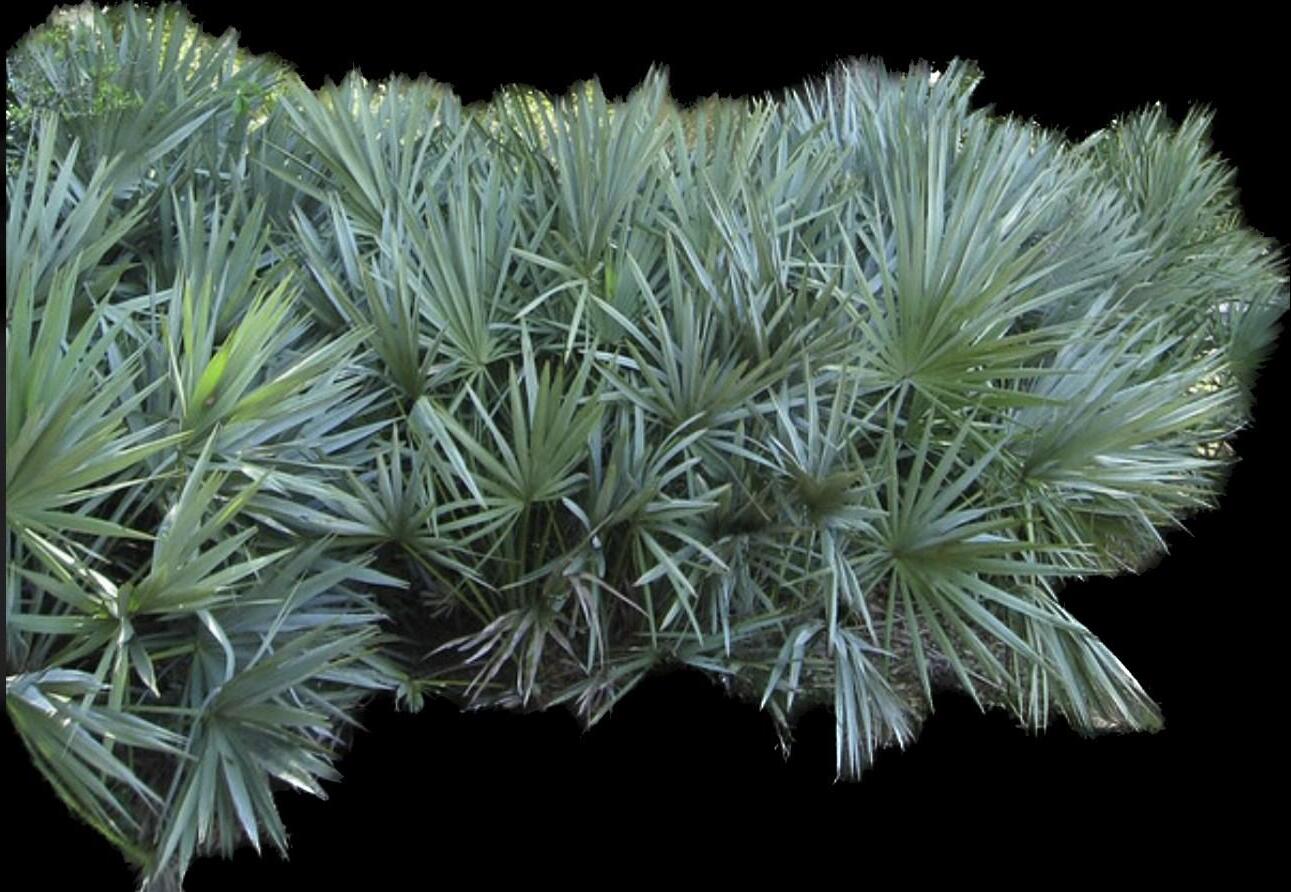
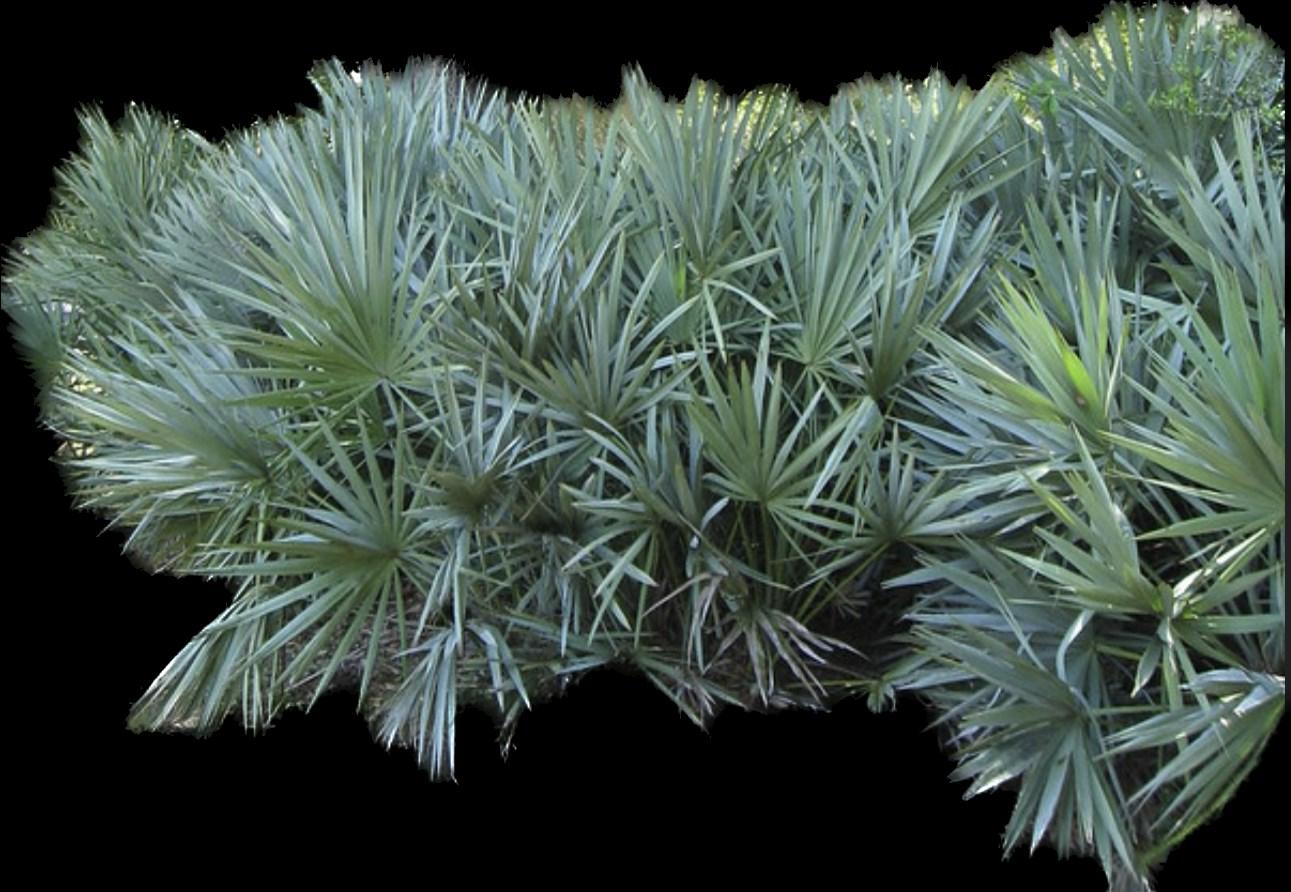






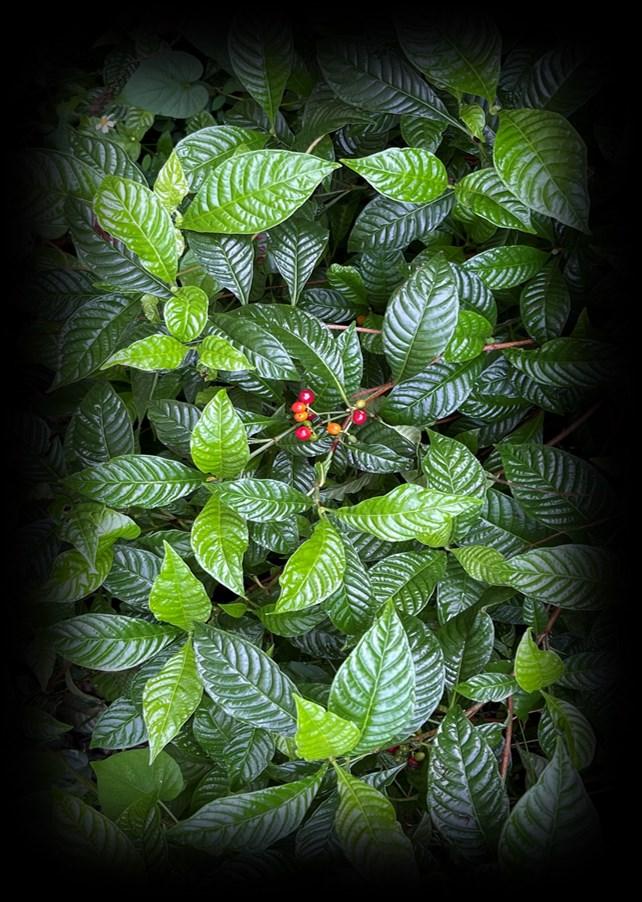








 Bark of Mature Black Ironwood
Bark of Mature Black Ironwood































































































































































































